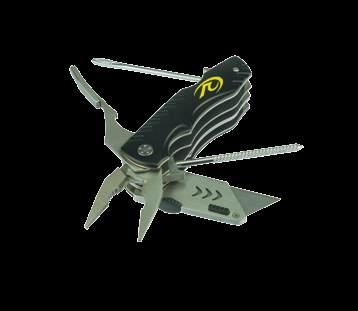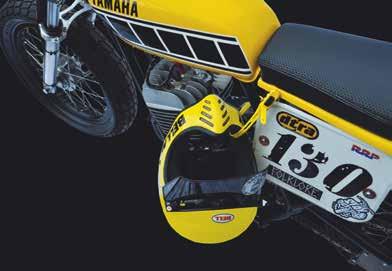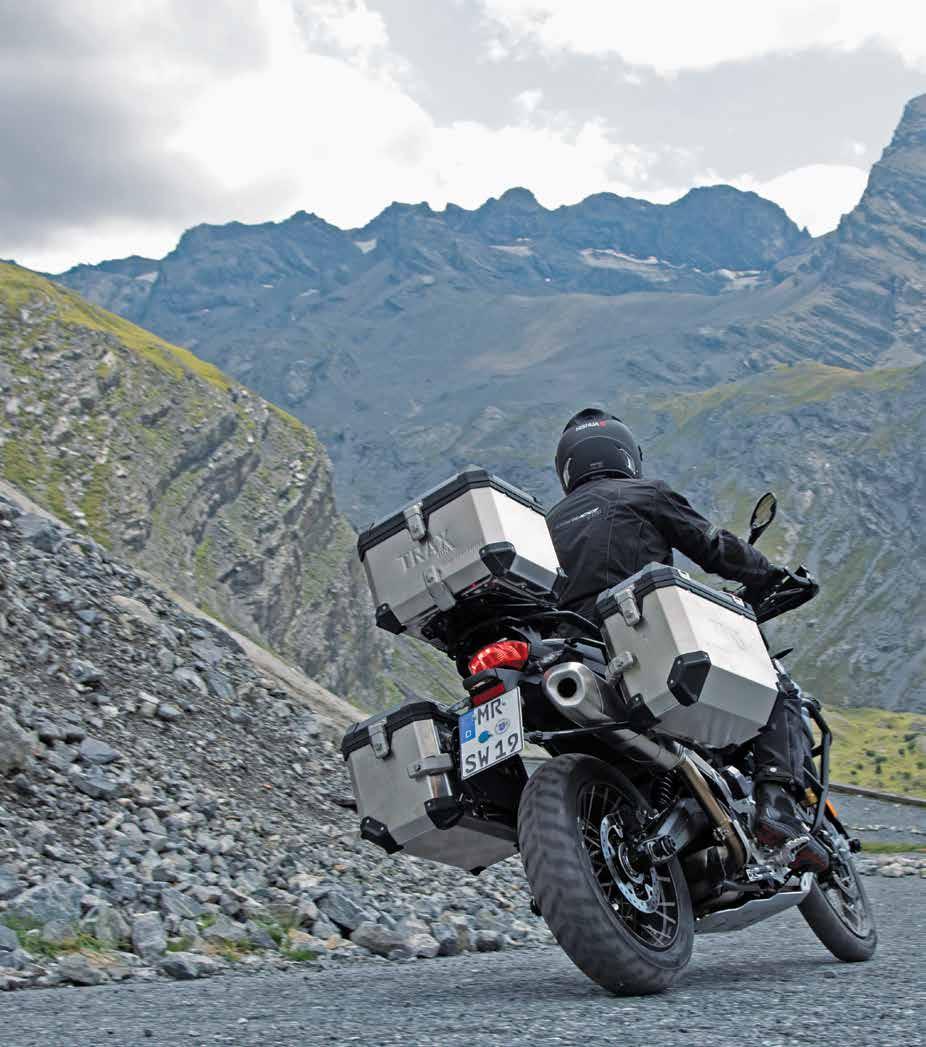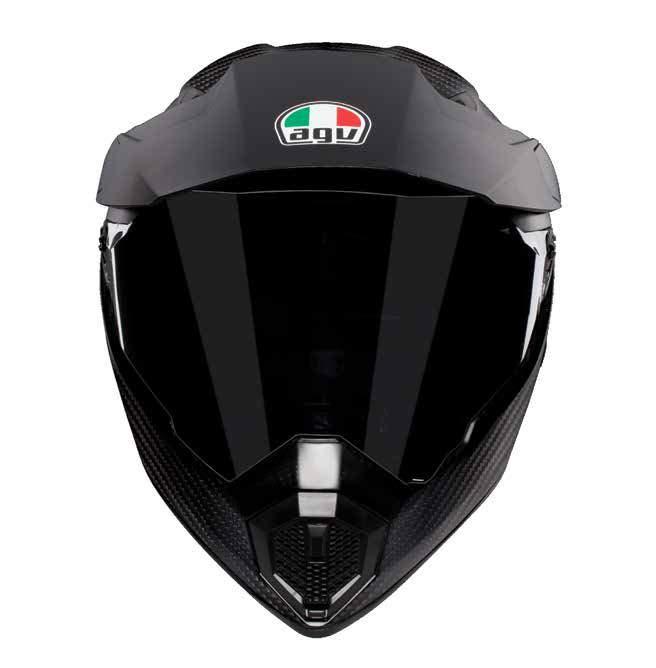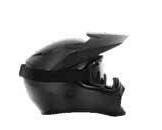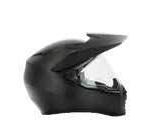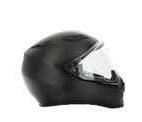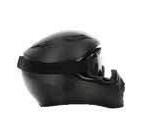
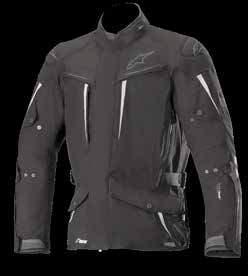
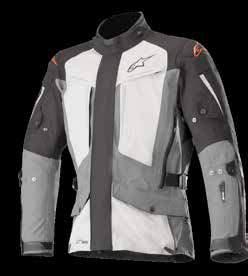
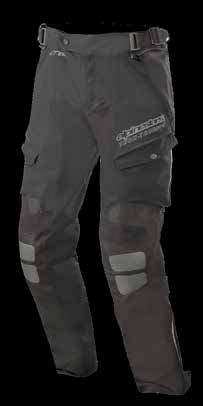
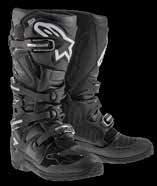
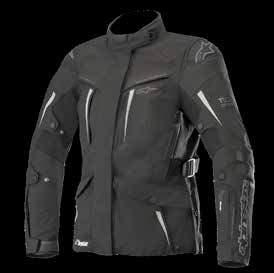
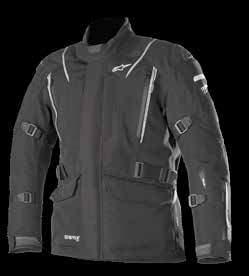





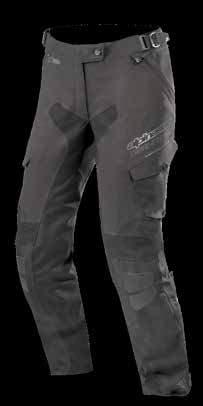
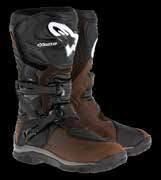
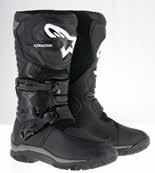
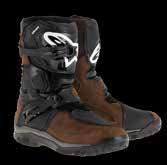

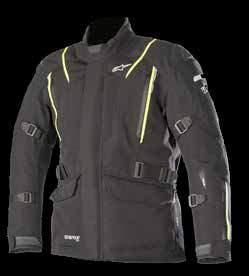
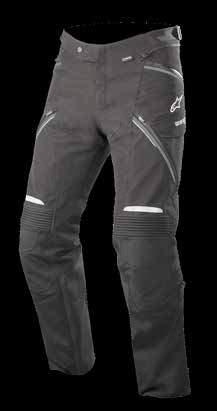

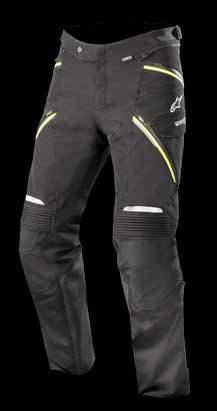

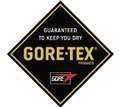
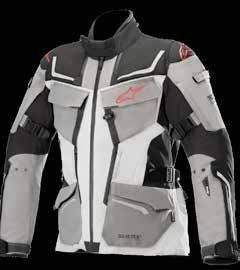
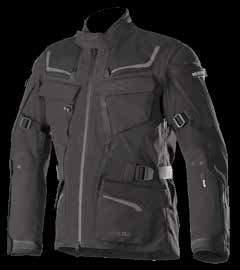
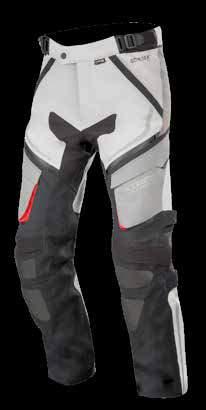

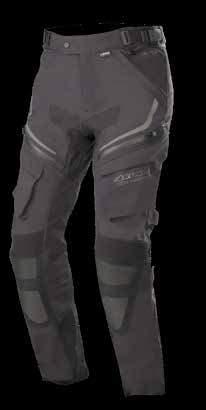
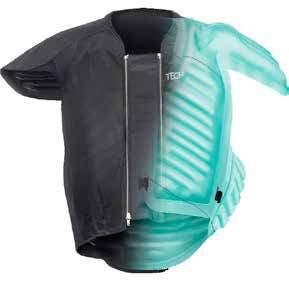
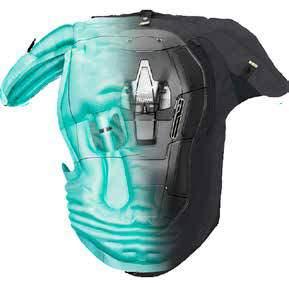

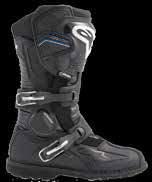







Phone:


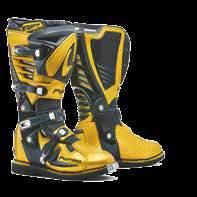
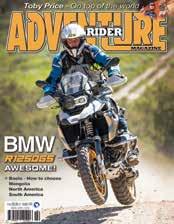
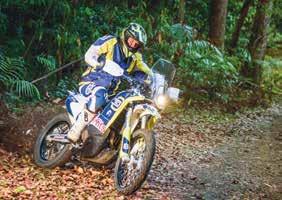
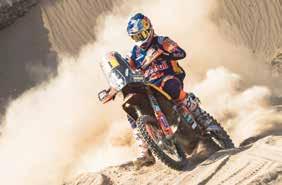
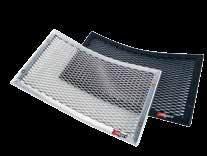
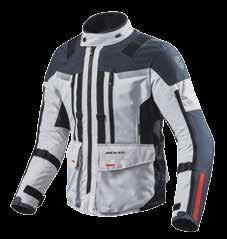
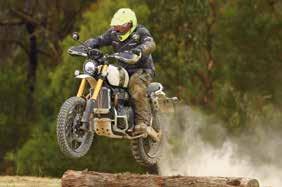
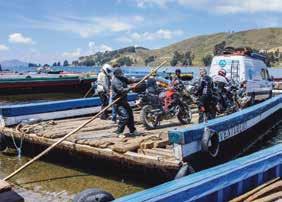
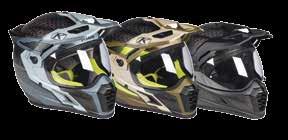
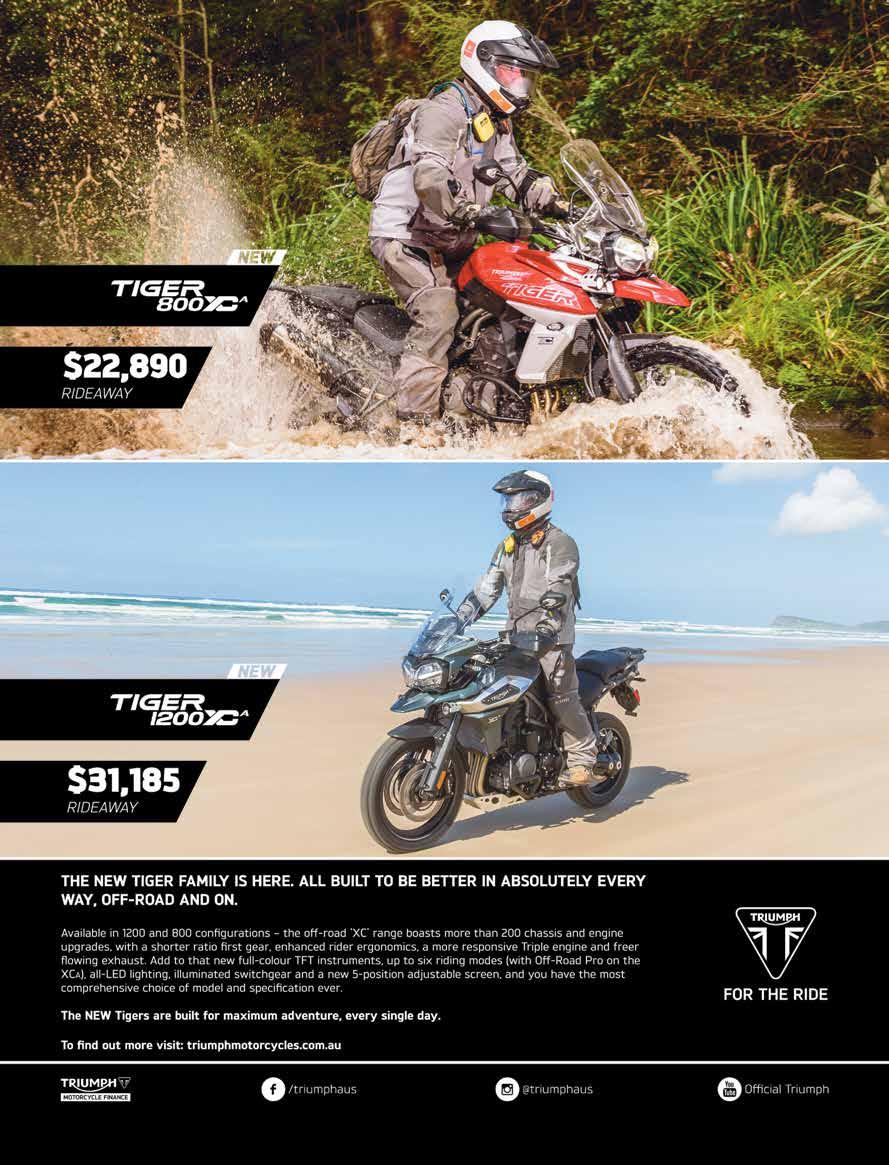








































Phone:












BMW’s new boxer-twin is an out-and-out winner. No ifs or buts. It’s a stone-cold stunna that’s ready for anything.
Main: The standard R1250GS had all the on-road and off-road capability expected of a GS. It didn’t limit our options compared to the up-specced models at all.
Right: The 1250 didn’t feel bulky or difficult on the single-track sections.
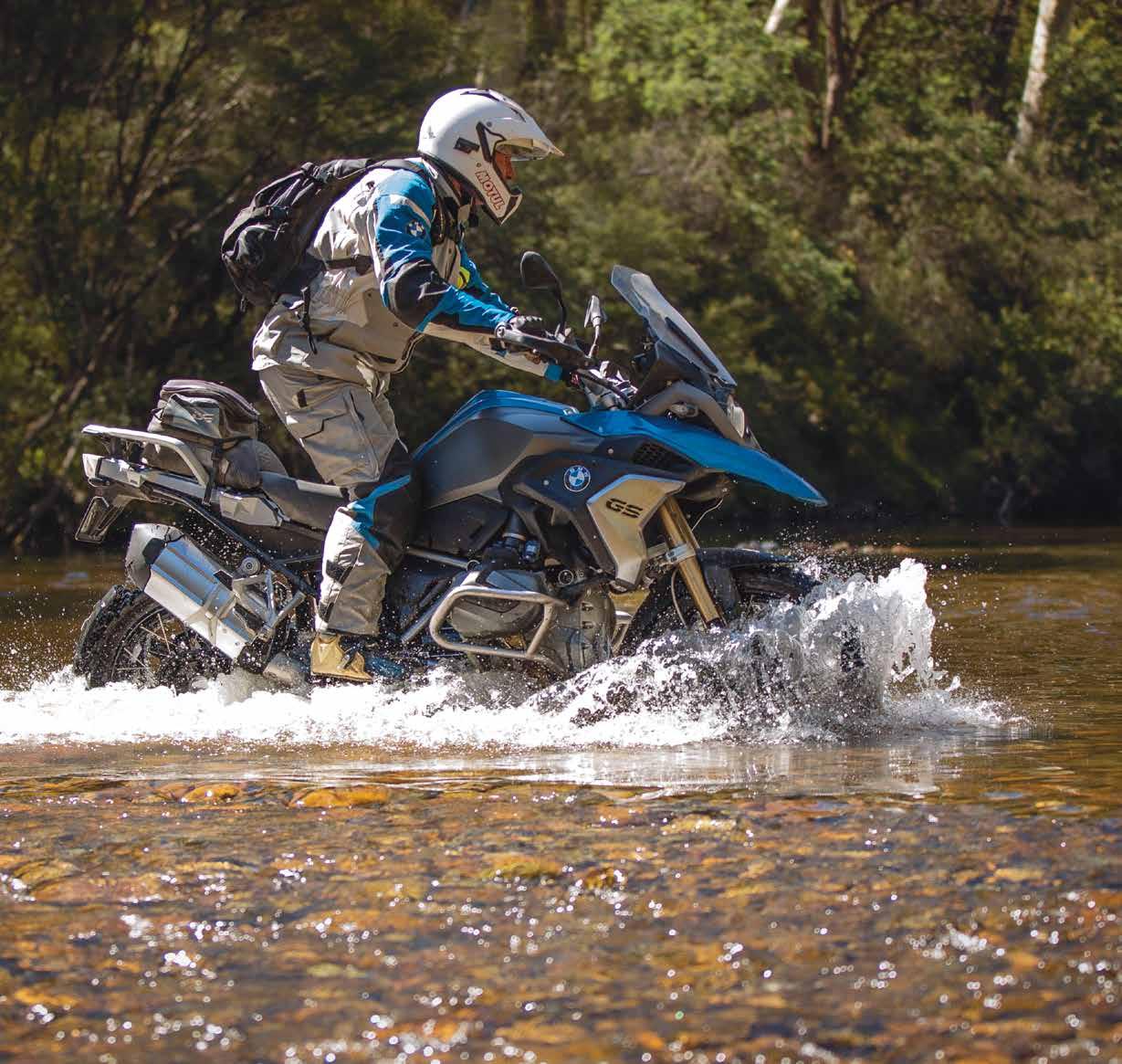
We’ve called this a review of the R1250GS, but in reality we rode a few variations of that bike. For the sake of not having the important message hidden behind too much detail, we’re going to group all the bikes under the heading ‘R1250GS’.
The important message is: this motor is fricken awesome.
Everything that was so great about the 1200 boxer twin is still evident in the 1250. It’s as smooth as warm Motul 10w-40 and as torquey as a heavy-duty pipe bender. But thanks to the variable valve timing, it has a whole lot of heart-racing snort available as well.
BMW calls the new system ShiftCam, and it works in the best possible way.
The 1250 motor is, of course, a boxer twin. Capacity is up from the old motor to 1254cc, offering 100kW of power – 134hp – and a stonking 143Nm of torque. That’s a fair old hike in those figures, with horsepower up nine per cent and torque up 14 per cent over the 1200. Also new for the 1250 is a ‘knocksensor’ system which allows the use of a wider range of fuel quality. Hill-start control and Road and Rain modes are standard on the base model, but all the bikes we rode had the dongle fitted and also offered Dynamic Pro, Enduro and Enduro Pro, modes.
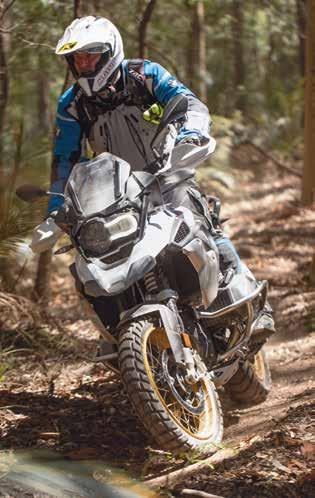
sudden explosion of power. It just keeps driving long after we expected it to sign off.
And that, folks, is what has us so excited about the R1250GS. It’s as comfortable and stable as we expect a big Beemer to be, but that broad spread of usable power is what left us trying to hide an embarrassing bulge in the trouser of our new Rallye suits.
The 1250, especially ShiftCam, roolz.
The modes can be changed on the fly, and although we’re not certain, we think the modes are easier to change than they used to be. We thought we remembered having to return the throttle to zero and pull in the clutch. Now it’s only a matter of thumbing the button until the desired mode shows on the TFT dash, then chopping the throttle for just an instant, and Bob’s your uncle.
The 1250 motor is an eye-opener. Where the 1200 boxer twin was a grunt monster up to around 5000rpm – depending on which mode was selected – the 1250 just keeps on driving, way up toward the redline. There’s no detectable change in the feel of the motor and there’s no
How does ShiftCam work?
Here’s how BMW explains it:
‘ShiftCam varies the valve timings and valve stroke on the intake side.
The core of the technology is a singleunit shift camshaft with two cams per valve – one partial-load cam and one full-load cam, each featuring optimised cam geometry design. While the partial-load cam has been configured to ensure optimised fuel consumption and refinement, the full-load cam is designed for optimised output.
‘Axial shift of the intake camshaft means the intake valves are activated by either the partial-load or the u
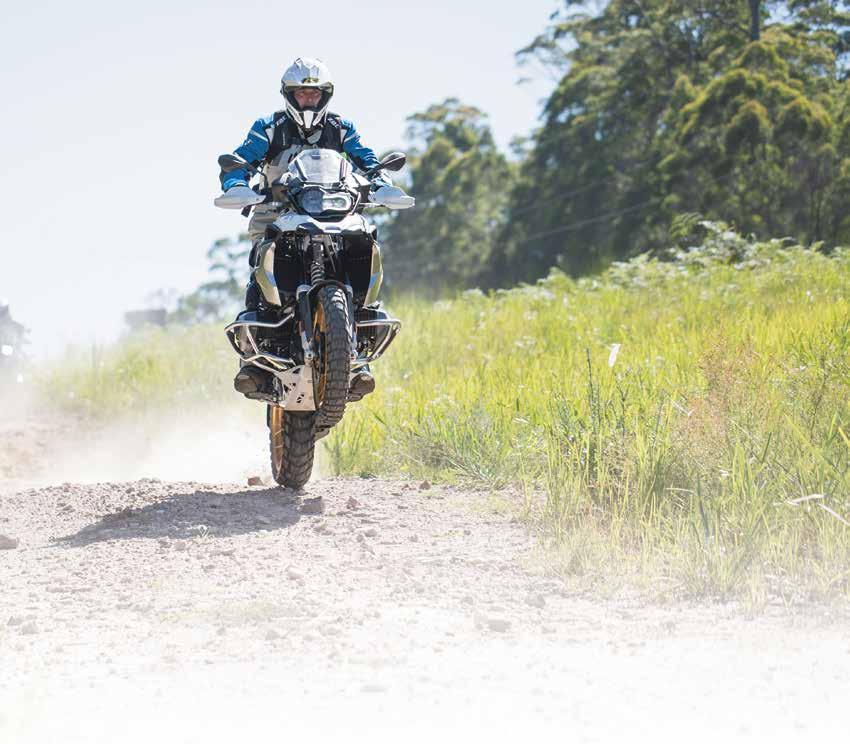
full-load cam, depending on load and engine speed. That’s determined by means of a shifting gate on the camshaft and an electronic actuator.
‘The varied configuration of the cam geometry also enables variation of the intake valve stroke. While the full-load cam provides maximum valve stroke, the partial-load cam delivers reduced valve stroke. There is also a difference between the intake cams for the left and righthand intake valve in stroke and angular position. This phase shift means that the two intake valves are opened to different degrees and on a time-staggered basis.
‘In short, ShiftCam Technology helps boost power to the 100kW output, reduces load-change loss in the partial-
load range, reduces idling speed by 100rpm, reduces emissions, improves the exhaust note, and cuts fuel consumption by four per cent compared to the engine’s predecessor.’
That’s some heavy-duty tech for an engine, that, at first glance, doesn’t really appear very different. As we’ve already said though, the result is a very big step forward from last year’s motor. With our brains spinning like a full-load cam at high revs, we climbed on board the GS to find pretty much the same comfortable, familiar BMW we’d come to know and love. The Rallye X – still our
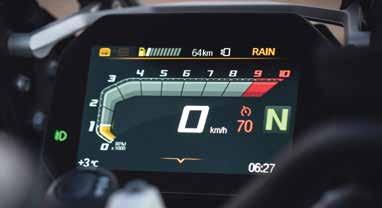
Above: ShiftCam lets the 1250 motor keep working through a much wider rev range than the 1200. Below left: We’ve seen this TFT screen for a year or two. Now it’s standard across the 1250 range. Below right: Yeah, baby! An Akro was a nice addition on the HP.
favourite, but now called the ‘HP’ – was a little taller than the standard GS, and of course the GSA was substantially wider at the tank and a little firmer on the front end, but we left the national capitol jumping from one model to other and feeling instantly comfortable on all of them. If anything, maybe the 1250 motor feels a little more compact than the 1200…but maybe not. To be honest, we were so insanely happy cruising down
u
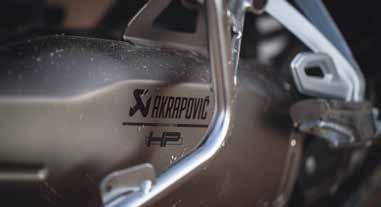
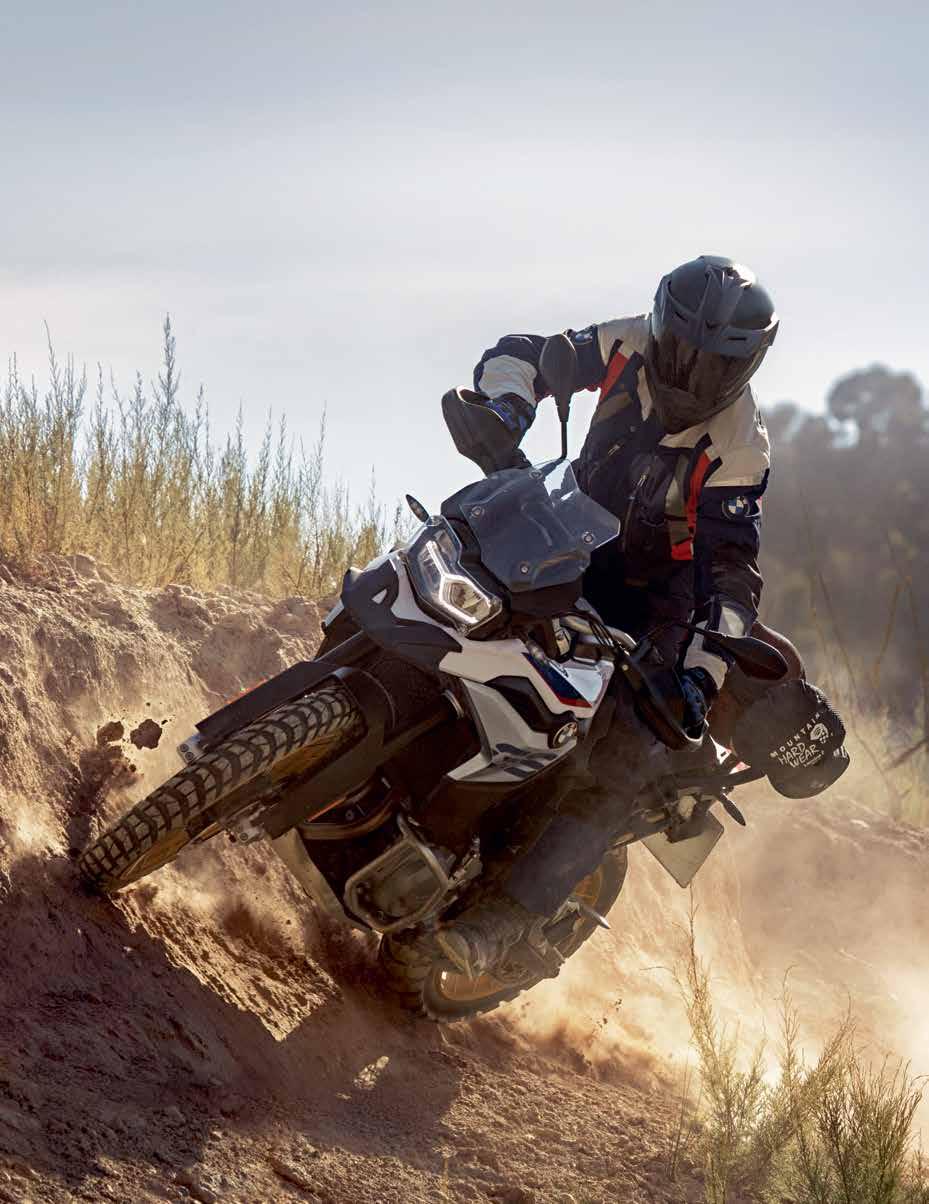
Experience unlimited adventure. Introducing the new F 850 GS – BMW’s latest adventure motorcycle. Featuring ASC, ABS and optional TFT display, there’s never been a better time to take your adventure to the next level. IN DEALERSHIPS NOW, Book a test ride: bmw-motorrad.com.au @bmwmotorradaus @bmwmotorradaus

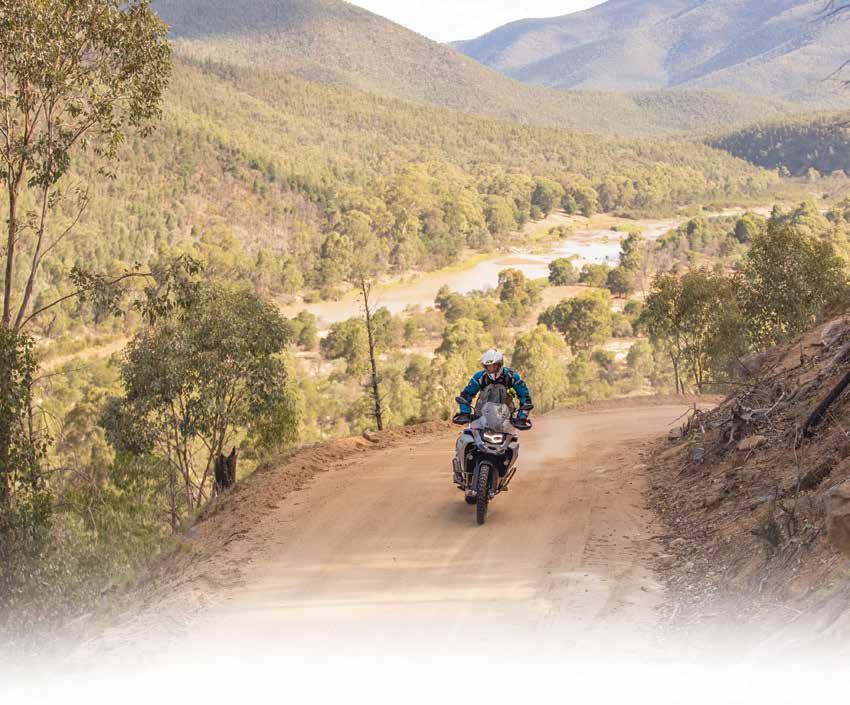
the highway on a sunny Canberra day, with the temperatures in the mid-30s, a brand new BMW Rallye suit showing off its venting and what was clearly a very excellent motorcycle doing the work, we enjoyed ourselves and forgot to pay much attention.
That aspect of riding a big BMW clearly hasn’t changed.
We’ve always considered BMW to be the leaders in electronic rider aids. And we’re not embarrassed to say that last year we thought Suzuki’s V-Strom 1000 had matched BMW for usable, fun traction control.
But with the 1250, BMW has taken another jump forward. The electronics on all these bikes are incredible.
TFT screens are standard across the 1250 range, and the amount of information available to a rider is overwhelming. Literally. We had so much trouble resetting the trip meter we had to ask for help, and then we were shown how we could customize pretty much everything, right down to the information
shown on the TFT screen itself, and that made it all so much easier.
Our default mode on BMWs is Enduro Pro. It means no ABS on the rear, traction control allows a sensible amount of wheel spin and, on- or off-road, it does the bizzo for us.
But we tried the Road mode on dirt, the Rain mode in the dry and all sorts of variations in unsuitable situations, only to find they were all quite usable. There were obvious limitations on totally unsuitable terrain, but we didn’t find ourselves stuck once because of mode choice. We did discover Dynamic Pro mode on the road. Hoo-aah. That’s a bit special. Enduro Pro, standard, without any change in the factory parameters, still worked fine for us in all situations, but we had a ball trying some of the other modes, and they were all great. Used in their intended applications they’re stellar.
‘Connectivity’ is a big facet of BMW’s design these days, and the 1250 has reached new levels, thanks in part to that amazing TFT dash.
Here’s the lowdown in BMW’s own words again:
‘The multifunctional instrument cluster with a 6.5-inch, full-colour, TFT display and numerous features is available and comes standard on the R1250GS. In conjunction with integrated operation via the BMW Motorrad multi-controller, it gives the rider quick access to vehicle and connectivity functions.
‘It’s also easy to make telephone calls or listen to music while on the road. If the rider, for example, connects a smartphone and a helmet equipped with the BMW Motorrad communication system using the TFT display, they can easily access the media playback and phone functions.
‘In addition to that, the free BMW Motorrad Connected app offers everyday-suitable and practice-oriented arrow navigation directly via the TFT display.
The BMW Motorrad Connected app is available for free from the Google and Apple app stores.’
Above: The 1250s are most at home on open terrain, especially on harder surfaces. Under those conditions their stability is a notable factor of their performance. u
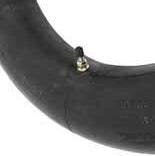
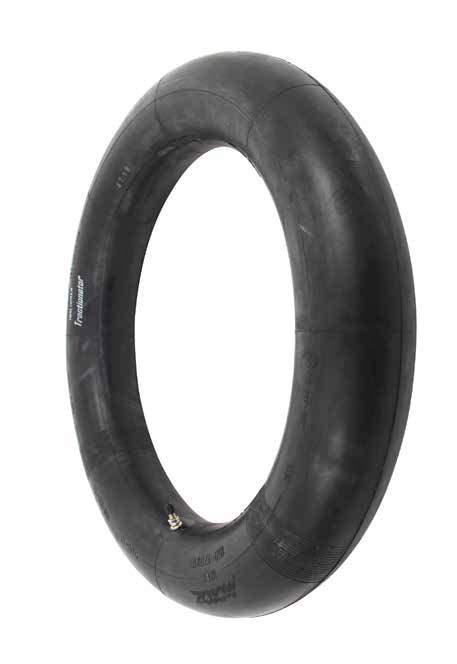
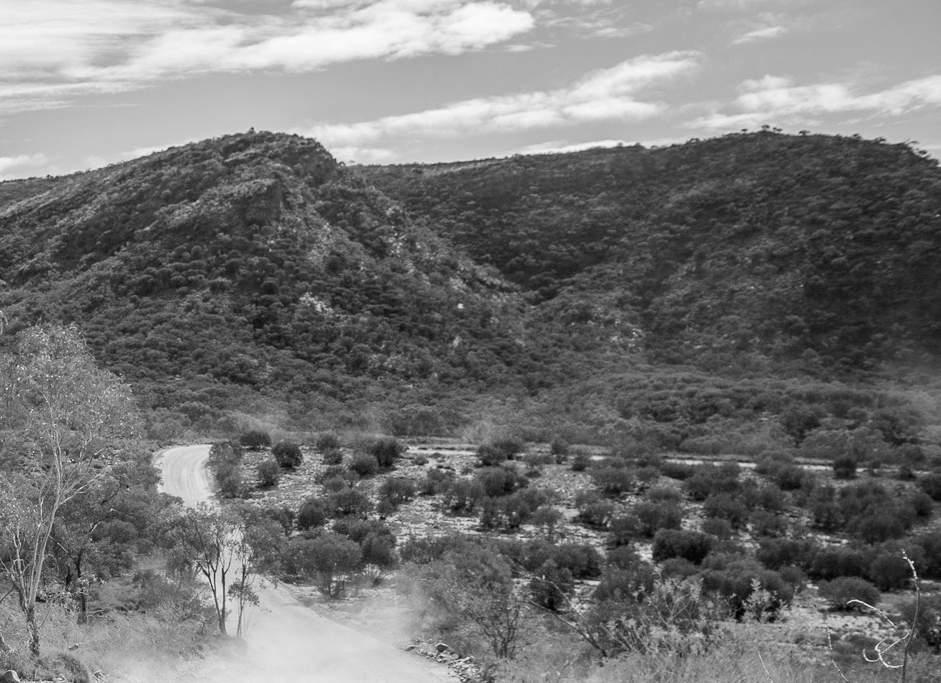
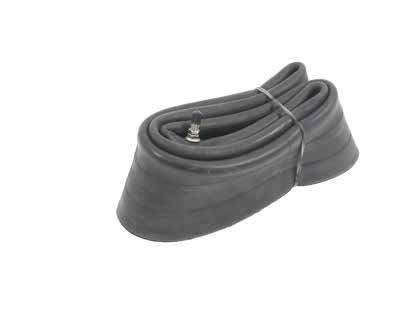
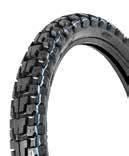
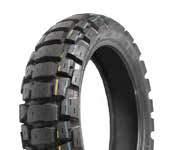
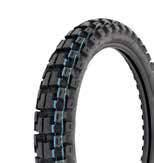
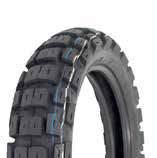

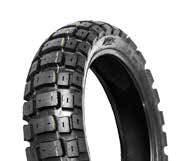
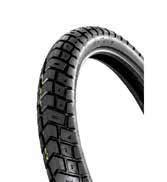
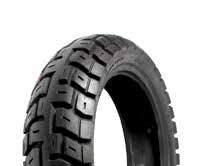

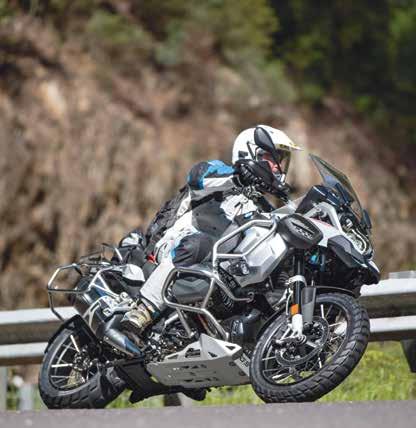
Above: Road stretches are a pleasure on all the 1250s. ShiftCam does encourage some hooning, and makes that hooning a very satisfying experience. Bottom right: Still unmistakably a Beemer, but just that hint of hidden sexiness.
Set and forget
Suspension on the 1250s is fairly awesome, of course. The optional Dynamic ESA is pretty much a set-and-forget option. The bike will read the terrain in near real time and make adjustments within a micro-poofteenth of a second. But even the standard, non-ESA option is good. The Telever front end still means no diving under even the hardest braking – and the brakes on these bikes are sensational for strength and feel – and the rear stayed planted and did its job without any fault we could find, no matter what the terrain surface.
They’re big bikes, though. The standard 1250GS weighs in at 249kg ready to ride. With some luggage and maybe a fuel bladder that’s a mass that needs thinking about. It’s similar to other bikes in the class these days, and we honestly didn’t feel the bike was bulky or difficult as we paddled across the Murray River or picked our way along the few single-track sections BMW had included. Obviously the bike’s most at home on open terrain, especially on the harder surfaces of sandy, hard-packed roads like the Barry Way into Jindabyne. Under those conditions its stability is a notable factor of its performance.
But it’s a big handful of bike if things go pear-shaped, and riders need to keep that in mind.
We loved the R1250GS range, no question about that. We loved the comfort, the performance and the undoubted exceptional engineering. The ShiftCam system delivers everything the marketing material promises, and that’s saying something. If you’re the type of rider who loves what BMWs offer, you’re going to be ecstatic with the 1250s. If you’re the kind of rider who prefers a light, agile single, or plans their rides around tighter terrain, the 850s may be a better choice.
But, geez. We’d be smiling at any chance we had to ride one, no matter where we were going or which horizon we were chasing.
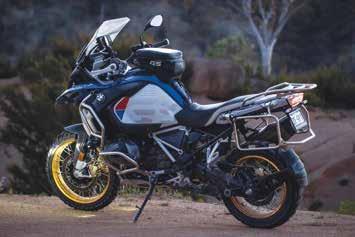
Web: www.bmw-motorrad.com.au
Recommended retail from:
$23,565 including GST, plus ORC.
Engine: Air/liquid-cooled, four-stroke flat twin with double overhead camshafts, one balance shaft and variable engine timing system BMW ShiftCam
Capacity: 1254cc
Bore x Stroke: 102.5mm x 76mm
Rated output: 100kW (134hp) at 7750rpm
Maximum torque: 143Nm at 6250rpm Compression ratio: 12.5:1
Fuel type: Unleaded, 95 octane (RON)
Gearbox: Constant-mesh, six-speed with helical gear teeth
Clutch: Oil-lubricated, hydraulically operated
Drive: Shaft
Frame: Two-section frame, front- and bolted-on rear frame.
Load-bearing engine.
Front suspension: BMW Motorrad Telever
Rear suspension: Cast aluminium, single-sided swingarm with BMW motorrad Paralever, WAD strut (travel-related damping), spring-preload hydraulically adjustable (continuously variable) at handwheel, rebound damping adjustable at handwheel
Suspension travel front/rear: 190mm/200mm
Wheels: Cross-spoked wheels
Tyres front/rear: 120/70R 19/170/60 R 17
Brake front: Double floating discs, four-piston radial calipers
Brake rear: Single disc, two-piston floating caliper
Wheelbase: 1525mm
Length: 2207mm
Height (excluding mirrors): 1430mm
Seat Height: 850mm/870mm (OE lowered suspension 820mm/800mm)
Width (including mirrors): 952.5mm
Usable tank volume: 20 litres
Unladen weight, road ready: 249kg
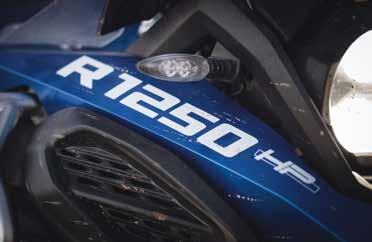
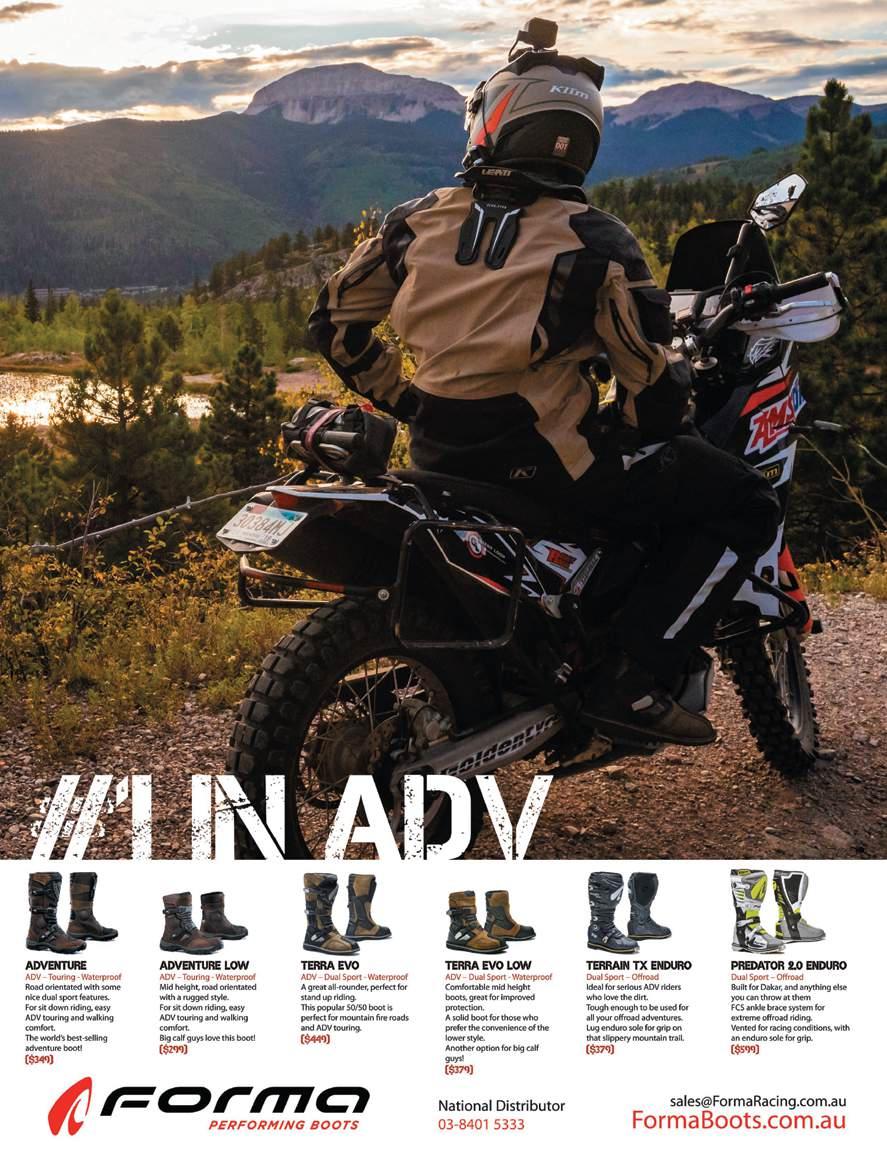
Adventure Rider Magazine spoke to
a
few experts to try and get a better understanding of the modern motorcycle boot.
Ranking right up there with a helmet, boots are essential safety equipment for adventure riders.
Like everything else in the modern adventure-riding world, advances in technology mean most of us don’t fully understand how boots are meant to do their job, or even what job some boots are meant to do.
We’re not going to claim we’ll make everything absolutely clear here, but we hope to steer you in the right direction when it comes time to think about new boots.
Heard it all before
We say it so often in adventure riding: selecting a boot is a compromise.
If protection was the only criteria we could have some steel pipe welded into and L shape and never fear an impact or penetration injury again.
Of course, we couldn’t operate our bike controls, we’d be in agonies of discomfort and we don’t even want to imagine what might happen as the result of a fall in a creek.
If comfort were the only parameter for choosing a foot covering, we could ride in Ugg boots and enjoy the kind of free movement around our lower extremities which would allow superb feel and control, right up until the almost guaranteed serious injury,
u
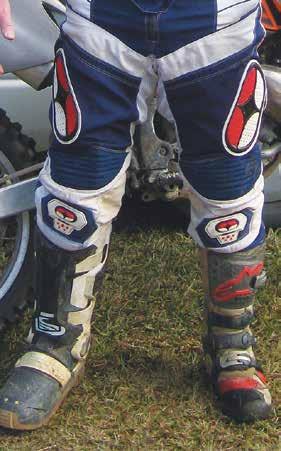
Above: Compromise. The right leg was recovering from a bad break and needed maximum protection that made using the rear brake almost impossible but kept the leg in one piece. The left leg was healthy, so some comfort and feel for the shifter was important, along with good protection.

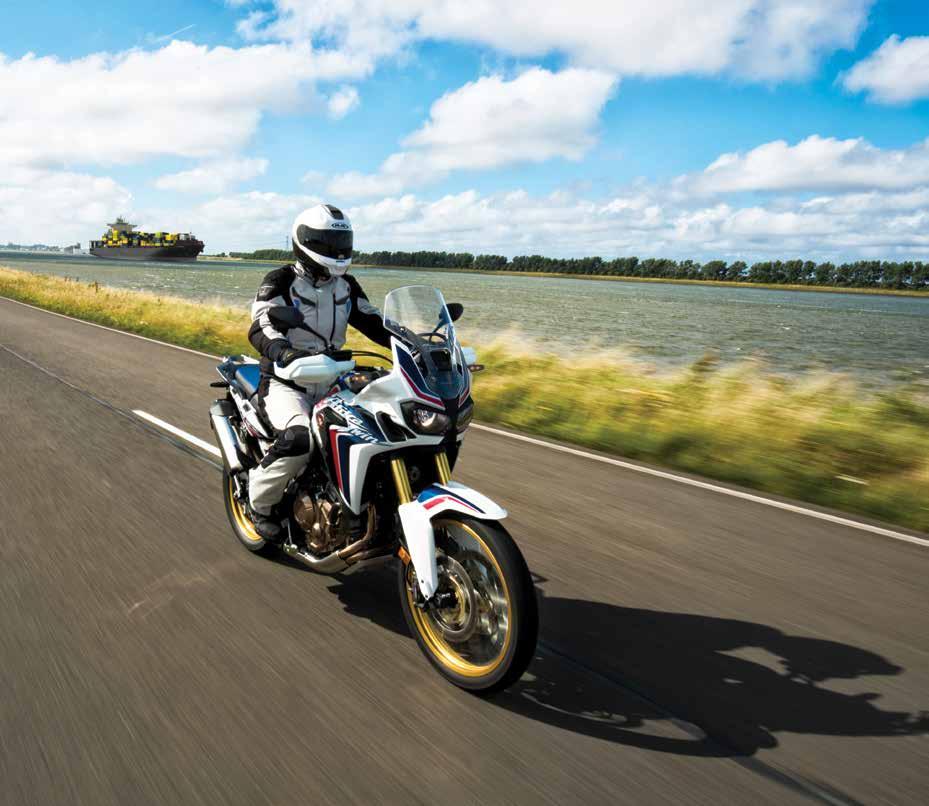
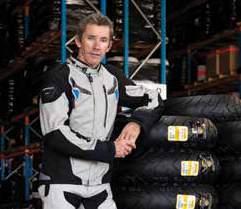
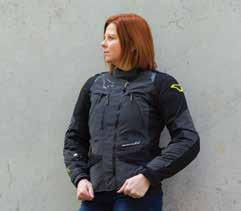
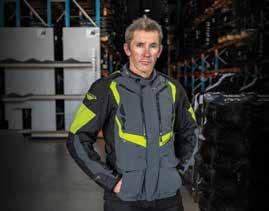
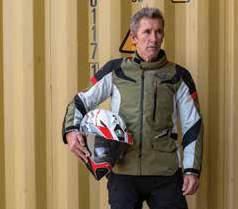

Functionality, comfort and innovation come together in the Core collection. Ready for endless miles of riding in all kinds of conditions. THE 2018 CORE RANGE
probably a few kilometres into the first off-road section.
So we compromise, and that’s the first thing to decide when buying a boot: are you buying for protection or comfort? And which of those things is more important?
Just to make sure there’s no misunderstanding, Adventure Rider Magazine advocates maximum protection whenever practicable. But even with that in mind, it can be a little more difficult to assess than it would seem at a quick glance.
We’re going to make some generalisations, just for the sake of moving the discussion forward, okay? We’re going to call full-on off-road boots ‘motocross’ boots.
We mean boots with buckles for closure, no velcro, stitched soles, steel toe caps, plastic panels…all that kind of thing.
Don’t send us e-mails saying some specific boot we mentioned is an enduro or flat-track boot and we called it a motocross boot. We’re putting all those types of boots under one heading.
We’re going to call the comfort-oriented boots – the ones with minimal plastic panels, possibly soft toe caps and high flexibility, ‘soft’ boots. ‘Road’ boots are those slim, sexy little units the road racers wear. That should cover us.
To the casual observer it would seem motocross boots are the ultimate in protection.
They’re big, heavy and, well…just look at them. They’re obviously all about protection.
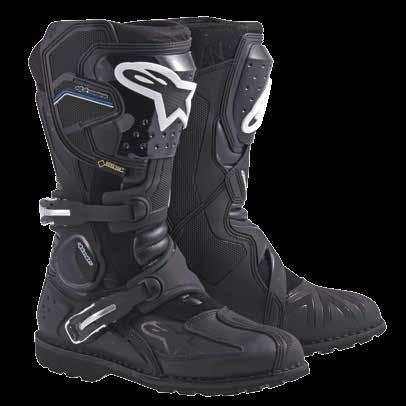
If that were true, why aren’t the road-race guys wearing motocross boots?
Here’s the biggest lesson we want you all to absorb: the key to good protection is in having the right boot for the right situation.
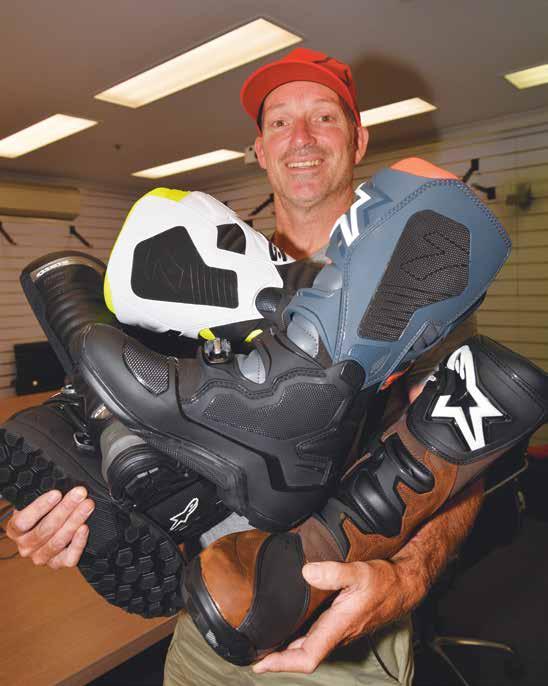
side. We’ll have enough to deal with here, without dissecting a style of boot that’s peripheral to adventure riding. If you ride on the road, wear boots made for that purpose. You’ll be more comfortable and better protected. Back to adventure.
Why not just wear a full-on motocross boot and know you have the best protection possible?
We recommend you do…if you ride hard off-road.
Think about that. It’s fundamental to making a good selection when you’re about to lay down a wodge of cash for a pair of boots.
Horses for courses
We’re going to leave road boots to one
Motocross boots will give the best protection against impact and abrasion injury in off-road situations. That’s all there is to that.
But motocross boots are designed to be worn for short periods. They’re meant to offer maximum protection at race speeds for the duration of a race. An adventure ride might be hours and hours over
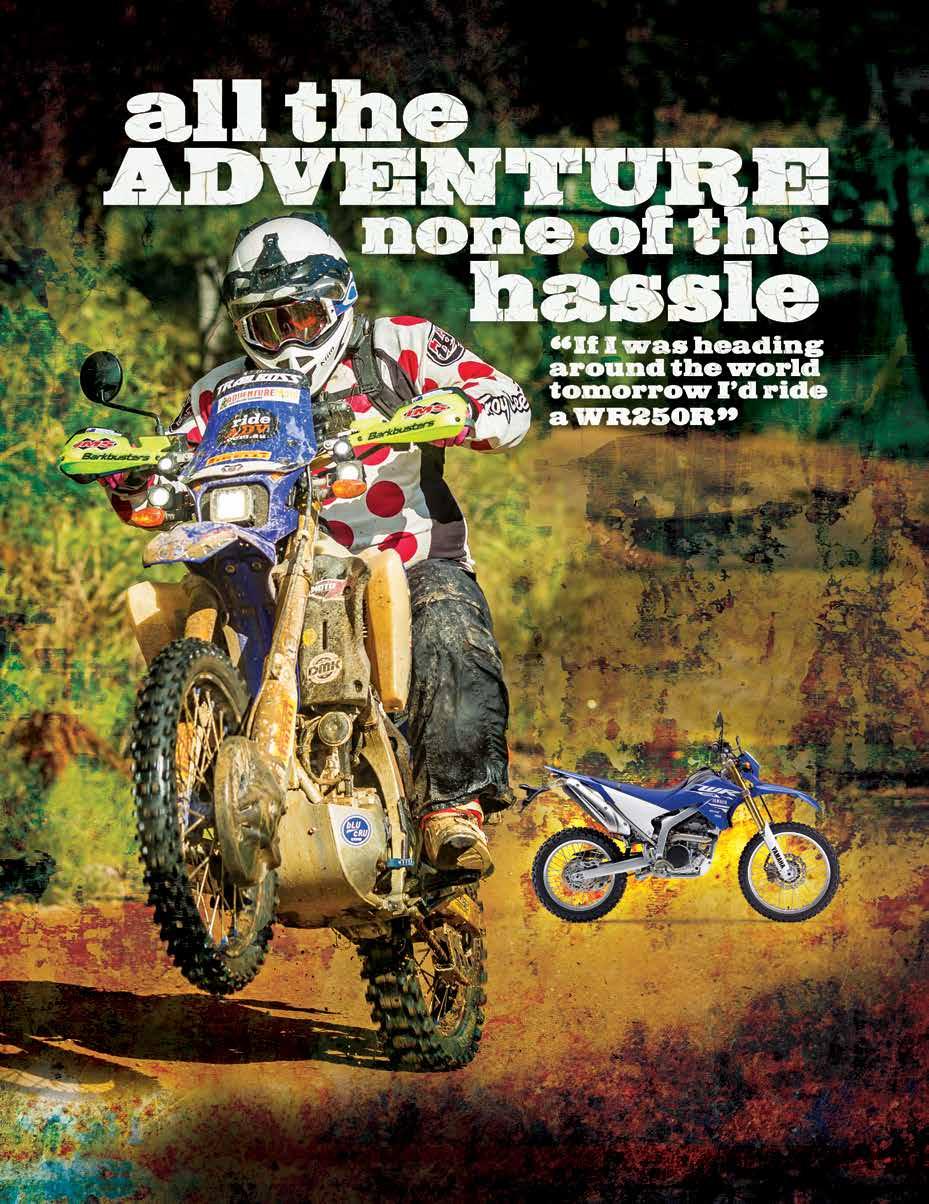




days and weeks, and a great deal of it may not be at high speed or on serious off-road terrain. In that circumstance there’s a case for accepting the value of some level of comfort and the effect that will have on rider fatigue.
Steve Jennings is Alpinestars’ Product And Brand Manager in Australia.
“What Toby Price wears doing Dakar isn’t what most adventure riders are going to need,” explained Steve, “because Toby’s not walking at all. Toby’s not hanging out with mates in his boots after the ride. He just gets on and off the bike to race. He needs to get to the other end safe, knowing his boots are protecting him.
“So what we try and do at Alpinestars is to work from a point of maximum safety and comfort, and then we want the riders to work out the percentage of off-road and road riding they do. That will determine which boot will suit them best. There’s just so many things to take into consideration.”
Adventure riding will often include a fair chunk of time off the bike, walking around campsites, lookouts, in and out of creek crossings… all kinds of situations where a little comfort can make a big difference. Motocross boots can still be a good option. We’re only suggesting you think about your own riding and consider what might suit best.
Hard case
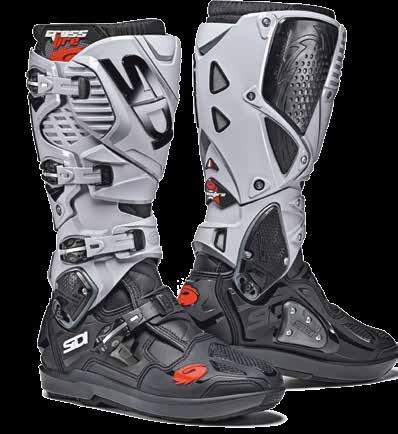
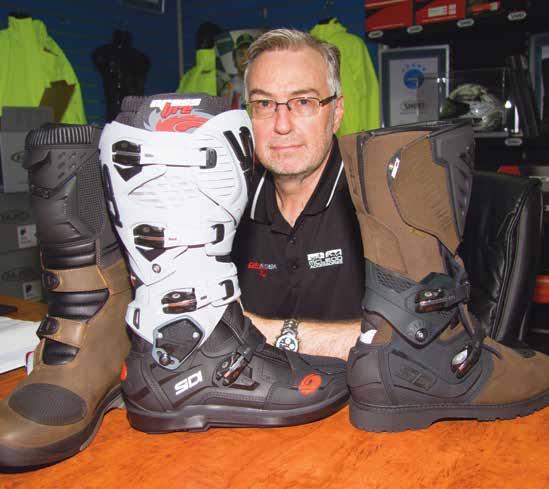
“Usually people go for a soft boot because they’re inexpensive,” said Wright. “They tend to be lighter in weight and pretty
So what if you elect to go for the full-on motocross boot?
What are the pros and cons?
The big thing in their favour is protection. No doubt about it. And, like anything, if you stump up enough cash you can get superb protection and a relatively high level of comfort.
Andrew Wright, Sidi’s Brand Manager at Australian importer, McLeod Accessories, clarified things for us.
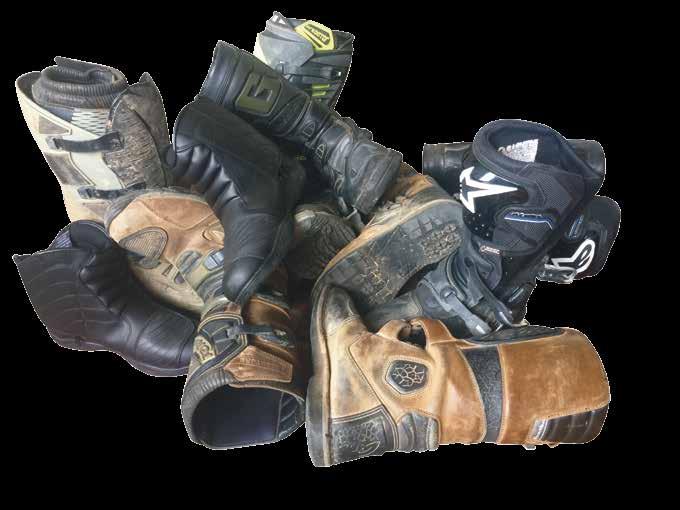
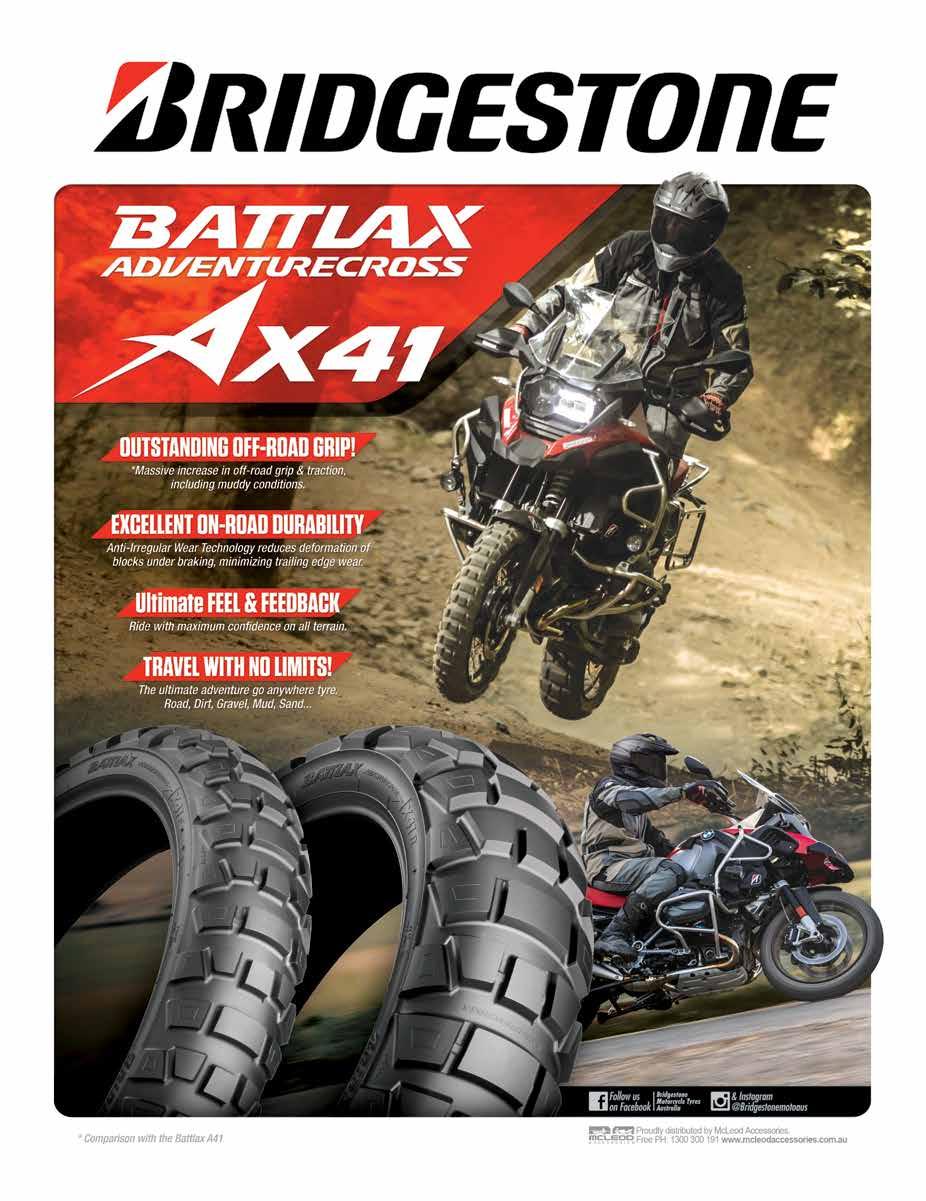
You don’t need to wear them in. They’re comfortable straight away and the protection for the lower leg is at a very high level.”
The Crossfire isn’t a cheap boot, and that’s the point. Price will give an indication of how well a boot fulfils its intended function.
Motocross boots aren’t waterproof. Because they’re designed for racing, they’re designed to get heat away from the body as fast as possible. If waterproof boots are high on your list of priorities, then consider a specific boot like the Sidi Adventure 2. It still offers good protection and comfort and has a Gore-tex liner.
Soft on Are there any advantages to soft boots?
Of course there are. Otherwise, why would road racers wear them?
In the adventureriding scenario, soft boots generally mean comfort. Entry-level and low-cost boots are often soft, but it’s for all the wrong reasons. They’re made using inferior components and materials, using questionable manufacturing methods.
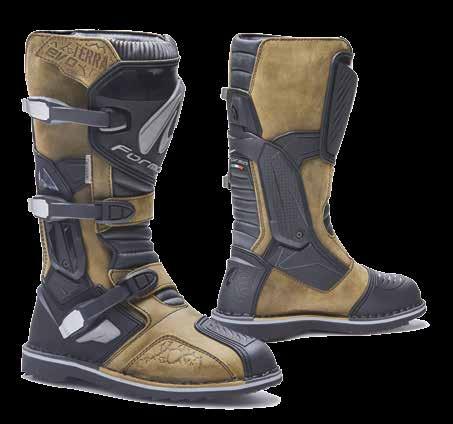
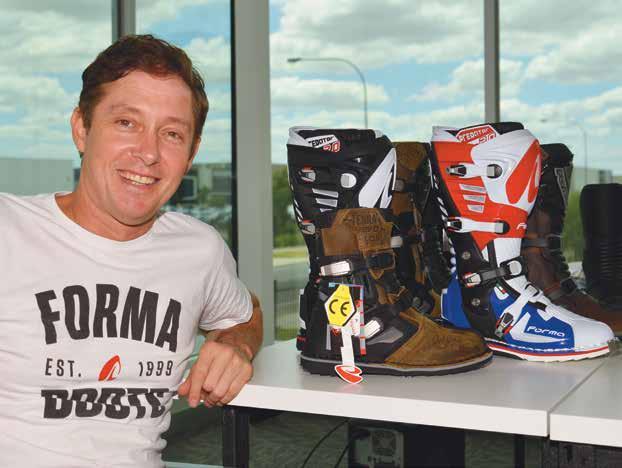
Above: Darren Waite splits his time managing Forma Boots in Australia and the US.
good adventuretouring boot should follow a similar, softer design with significant heel protection to absorb the hard-surface impacts. Most adventure/road ankle injuries and fractures aren’t caused by twisting, but from the severe-impact energy spike transmitted when a rider highsides and lands on the back of their heels. So the sole density and level of ankle protection become critical factors.
on the road, which can be considerable.
But there are some good-quality soft boots, and they do their job well.
Darren Waite splits his time between Australia and the US managing Forma Boots, and he’s spent a lot of time researching and developing boot technologies.
“The problem we have with adventure riding is, off-road, we need more rigidity in the boots to offer better off-road protection. You’re looking at frontal impacts where you don’t want the boot to fold up,” Darren told us. “But we also need to consider comfort and the amount of time adventure riders spend
“We have to try and blend the two technologies into a 50/50 boot that’s going to be suitable for the ‘average’ adventure rider. We need to take a soft boot like our Terra Evo, but give it a rigid sole for structural strength, so if there’s a frontal impact the boot’s not going to fold up on the rider. At the same time, it’s going to have some level of road protection, too.
“If you pick up any brand of MotoGP boot, the boots the fastest guys in the world are wearing, they’re a soft boot with significant protection in the heel,” Waite continued. “Ideally we believe a
Forma’s Adventure boot is a popular adventure-touring boot. It’s a soft boot, and if you’re riding off-road it’s the wrong boot. But I don’t care what anyone says, if you ride mostly on the blacktop, you need a softer boot for protection.”
Something all three of our experts put forward was the buyer doing the right kind of research. Go to the websites of the boot manufacturers. You might be surprised at the detail and specifics you find there. It’s good, solid information specific to each brand and each model, and if you realistically sort out in your mind the type of riding you do, the brand websites will steer you to the boot that will give you the best service.
Below: Adventure riders will usually look for compromise between a boot that’s soft for comfort, but has good structural strength. Forma has the Terra Evo. u
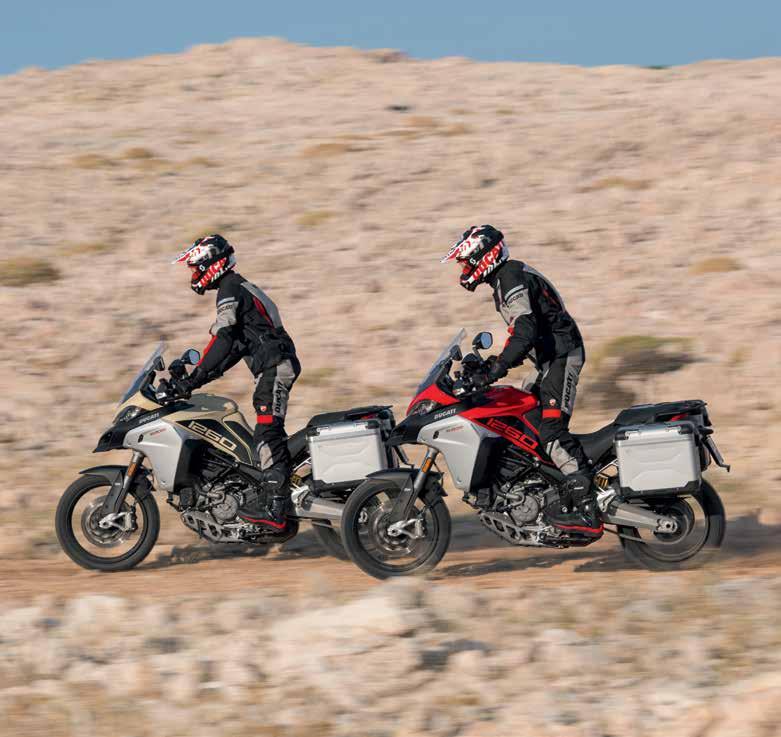
Avoid simply travelling. Exceed your boundaries with the Multistrada 1260 Enduro, the new Travel Enduro from Ducati. Thrilling performance is guaranteed thanks to the substantial torque supplied by the 1262 cc Testastretta DVT engine, always at the ready. Redesigned ergonomics ensure comfort and control in all conditions. A high-res dashboard with new graphic interface allows you to make simple and intuitive use of the numerous adjustment options, for a configuration to best suit your needs.
No destination will seem far enough on board the new Multistrada 1260 Enduro. Let yourself go beyond your boundaries.
The other things all the boot experts said was how important it was to try the boots on and walk around the store. Not only try the boots on, but, if possible, try them on with your actual riding gear. All three had seen people try boots with different socks, only to find the fit wasn’t as comfortable with their actual riding socks, or they’d kitted up for the next ride to find the pant legs wouldn’t fit over or under the boots, or the knee protection wouldn’t sit in the right place, or numerous other individual quirks.
We learned so much sitting and talking to the industry top dogs we couldn’t possibly fit it all in these pages. We heard about different construction methods, stitched and glued soles, long and short boots, shanks and lasts, and even how the material used in making buckles is carefully considered. We’ve skimmed across some very long discussions to try and bring you the important highlights, but there’s a huge amount we haven’t included here. Ankle protection is a hot topic in adventure-riding circles, and although we didn’t mention it specifically here, all three experts agreed on its importance and included it under the general heading of ‘protection’. Assess the ankle protection when you’re weighing other factors like crush-, impact- and abrasion protection. The best thing we learned was for riders to be honest and sensible in assessing the type of riding they do, and then to go to the manufacturer websites for solid, specific information to guide them in their choice.

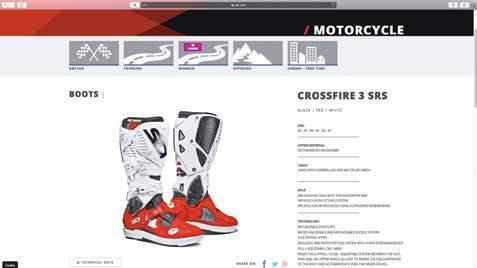
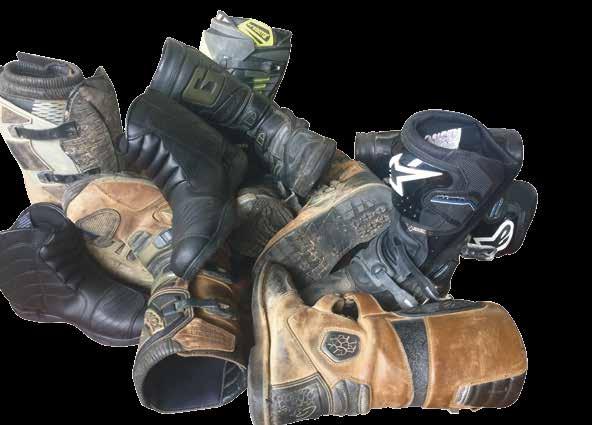



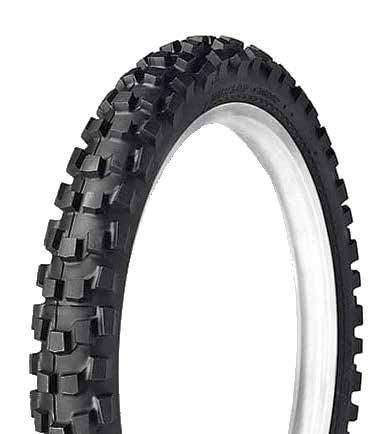
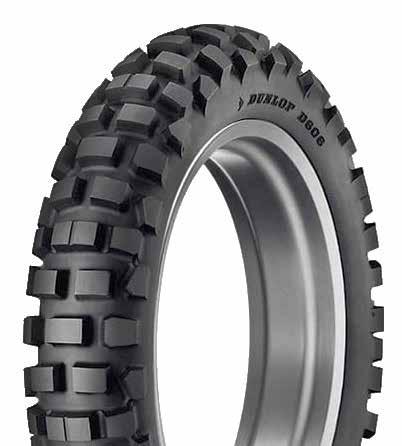
At the same dry weight as the legendary DR650, a fully set up Hardkits Husqvarna or KTM is ticking the boxes for many.
Hardkits has been refining its aftermarket rallye set up for KTM’s 690 and Husqvarna’s 701 for a while now. The new Series 3 kit is a ball-tearer.
Australian owned and manufactured Hardkits – ‘HARD’ stands for ‘Horizon Adventure Rallye Designs’ – has come a long way since it kicked off eight years ago. Designer and manufacturer Darren ‘Big Dog’ Wilson has listened to customers and the kit has evolved into this, the Series 3, with the most noticeable inclusion, the genuine 450 Rallye clear screen.
Initially the Hardkits design was intended to fill the void left by the KTM 640R Adventure in 2007 as customers flocked to the 950 and then the 990 and 1190, all exceptionally good bikes that filled the gap.
More than 12 years has passed since then and the once mid-40-year-old owners who had stepped onto the larger adventure bikes are now between 50 and 60 years old. The flame still burns strong, and they still want to tackle the trip of a lifetime. The steep, stone-strewn hills, the rocky river crossings and the sand dunes of central Australia are still calling to be explored and defeated.
But the back, body and muscles of those riders aren’t what they used to be, and they don’t want to lift 250kg of bike and luggage after a fall.
At the same dry weight as the legendary DR650, a fully set up Hardkits Husqvarna or KTM is ticking the boxes for many.
Experience counts
As mentioned, the average age for the rider of a Hardkits bike is between 50-65.
Wilson says, “We’re dealing with guys who are very experienced when it comes to riding and adventuring. They know what they want, usually down to the finest detail, and they know what works for them and what doesn’t.
“We have guys who’ve built their bikes specifically for a ride across Australia –Perth to Byron – others for The Canning, others for around-the-world expeditions and others for multiple long-weekend trips,” explained Dazz. “I get a kick from
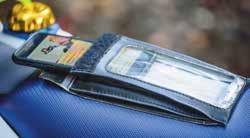
working with, and learning from, such a diverse and knowledgeable bunch of guys.”
Unlimited possibilities
With every new bike purchase there’s a list of accessories each rider wants to bring the bike up to the adventure spec they’re chasing.
Probably the two most common mods adventure riders chase are aimed at weight reduction and extended range, but experienced owners know the importance of making the bike suit their needs. Things like footpegs for standing over long distances, lowering footpegs or raising the seat height so they can ‘snap’ to their feet quickly, handlebar risers for a better standing position, more comfortable seats with extra padding for long days, suspension tuned to handing the conditions with fuel and luggage as part of the package, GPS navigation...it’s a huge list. The accessories market is so diverse that a seasoned adventure rider can now build the ultimate adventure bike.
A Hardkits kit on a KTM or Husky single has proved to be an excellent starting platform, especially for those looking for a lighter alternative to the one-litre and 1200cc powerhouses.
Do it all
With the incredible growth of organised adventure tours and rides, the Hardkits bikes with the new generation of silkysmooth, twin-balancer-shaft engines in
Top right: An excellent alternative to the 1200cc powerhouses.
Below left: A seat pocket can hold a phone, earplugs and some emergency cash if required.
Below: Bar-end weights and balanced wheels reduce vibration.
Right: The most noticeable inclusion on the Series 3 kit is the genuine 450 Rallye clear screen.
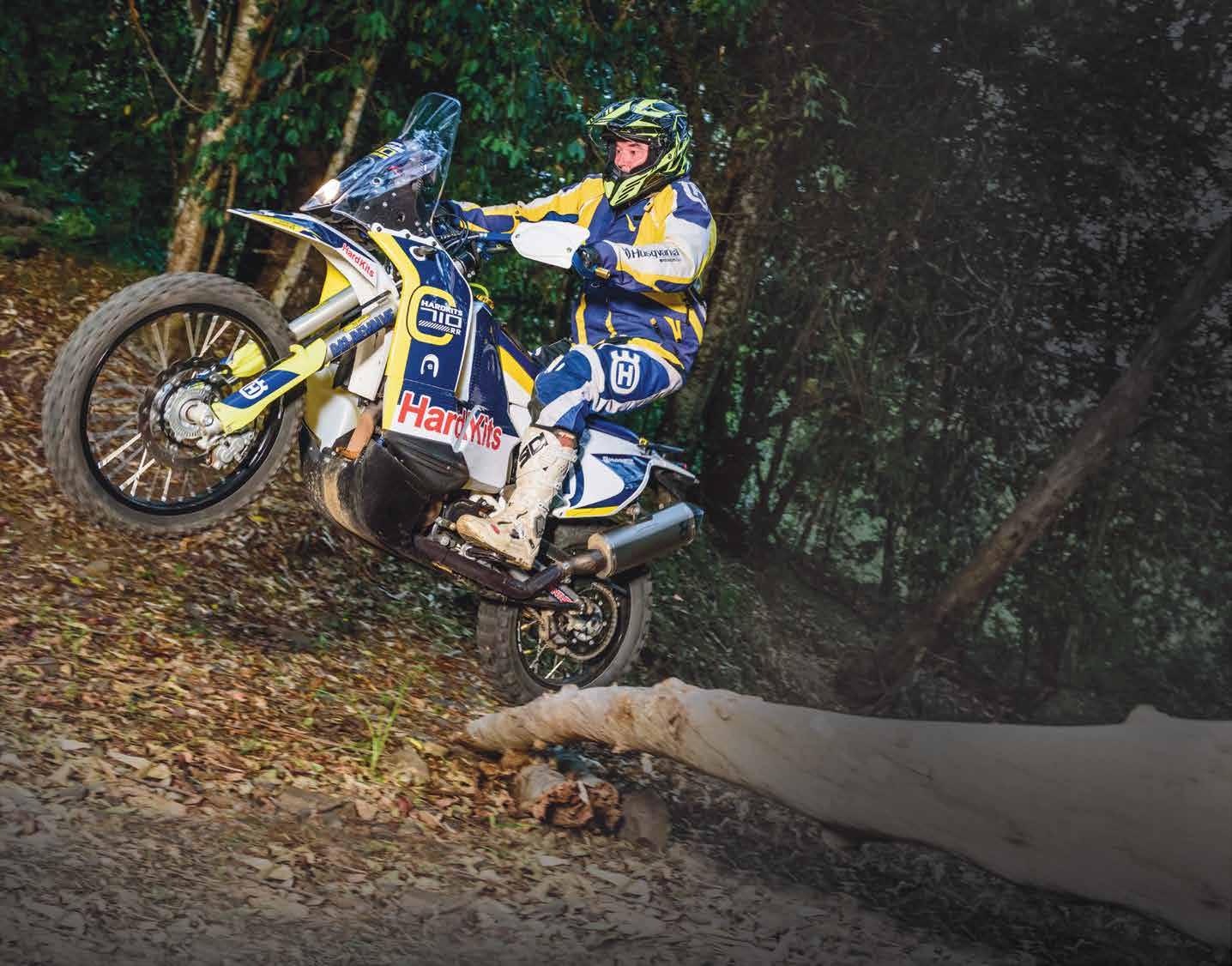
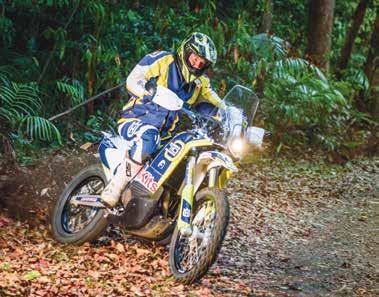
the Husqvarna 701 and KTM 690 are more than up to the task of eating bigkilometre days, comfortably sitting on 110kph to 120kph all day, every day. And when the track gets ugly the benefit of low centre of gravity compared to other bikes really starts to shine. Tracks and conditions that make riders cringe on bikes in a lower state of readiness are tackled with confidence and excitement. Having more than 30 litres of fuel on board, and a range of over 600km, gives a whole new dimension to adventure riding. Worrying about fuel capacity becomes a thing of the past. u
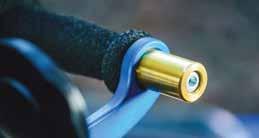
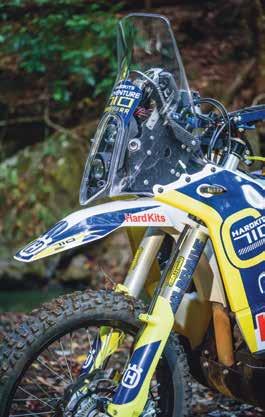
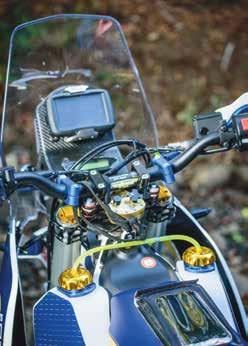
As mentioned previously, the Hardkits concept has taken many cues from the genuine rallye bike design.
The twin, front, nine-litre tanks carry fuel low and central for optimum balance and weight distribution, creating the need for a low-slung exhaust. Even though the front tanks are designed and placed for ideal weight distribution, airflow to the radiator was also included in the design brief and the result is maximum airflow. The bashplate protects both the motor and rider’s feet, while the bike remains slim between the
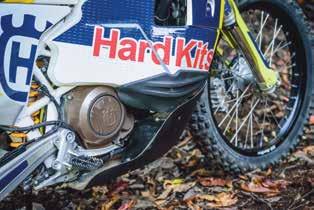
rider’s legs for sitting or standing.
The Hardkits demo bike shown here has been showered with off-the-shelf accessories: ceramic-coated header to reduce heat, wider footpegs, custom seat cover, raising the seat by 36mm in the middle and making it wider for highway comfort, and there’s even a pocket to hold a phone, earplugs and some emergency cash if required.
There’s an extra dust light fitted on the rear guard, billet fuel caps all round, higher-bend bars as well as foam rallye grips and Barkbusters with fold-in mirrors. Control is helped by a Scotts steering stabiliser and isolated sub mount, and bar-end weights and balanced wheels all add to reduce vibration. The gear lever has a small extension for added clearance to the low-slung header pipe, and to top it off, Öhlins suspension front and back.
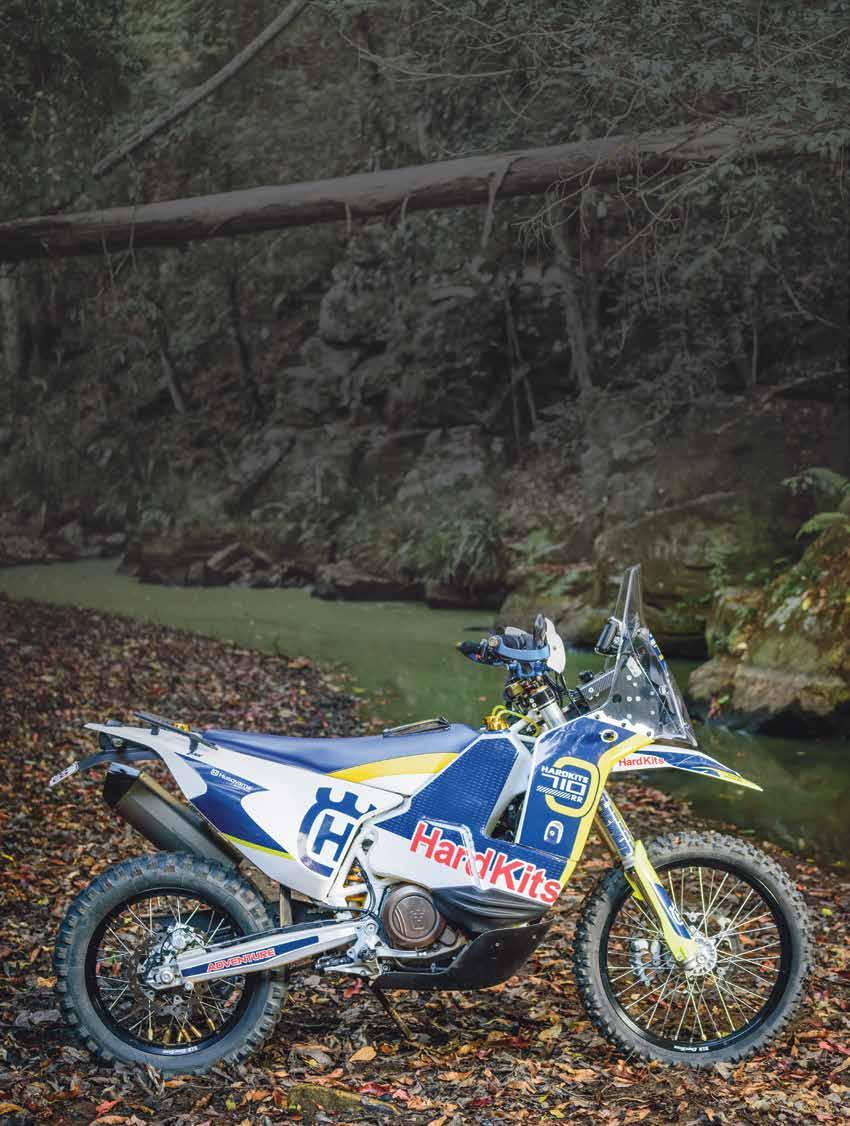
Far left: The genuine 450 Rallye clear screen gives excellent vision around the front of the bike and shelters the rider on road stretches.
Cockpit detailing is awesome.
Left: Bigger, stronger footpegs for standing over long distances.
Below: The Hardkits concept has taken many cues from the genuine rallye bike design.
A GPS takes care of navigation, and the clear screen mentioned earlier makes a huge difference to the rider’s view of terrain around the front of the bike. It all adds up to a well-balanced and very capable adventure mount.
The Hardkits’ bikes open a whole new Horizon of Adventure with Rallye Design – see what we did there? – capable of cruising down a dirt road or to the most extreme destinations on anyone’s bucket list.
Check one out, you won’t be disappointed.
Log on to www.hardkits.com for detailed info and heaps more pics.
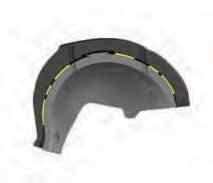
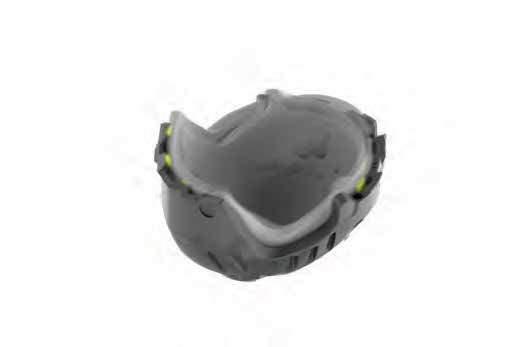
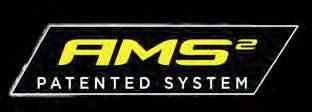





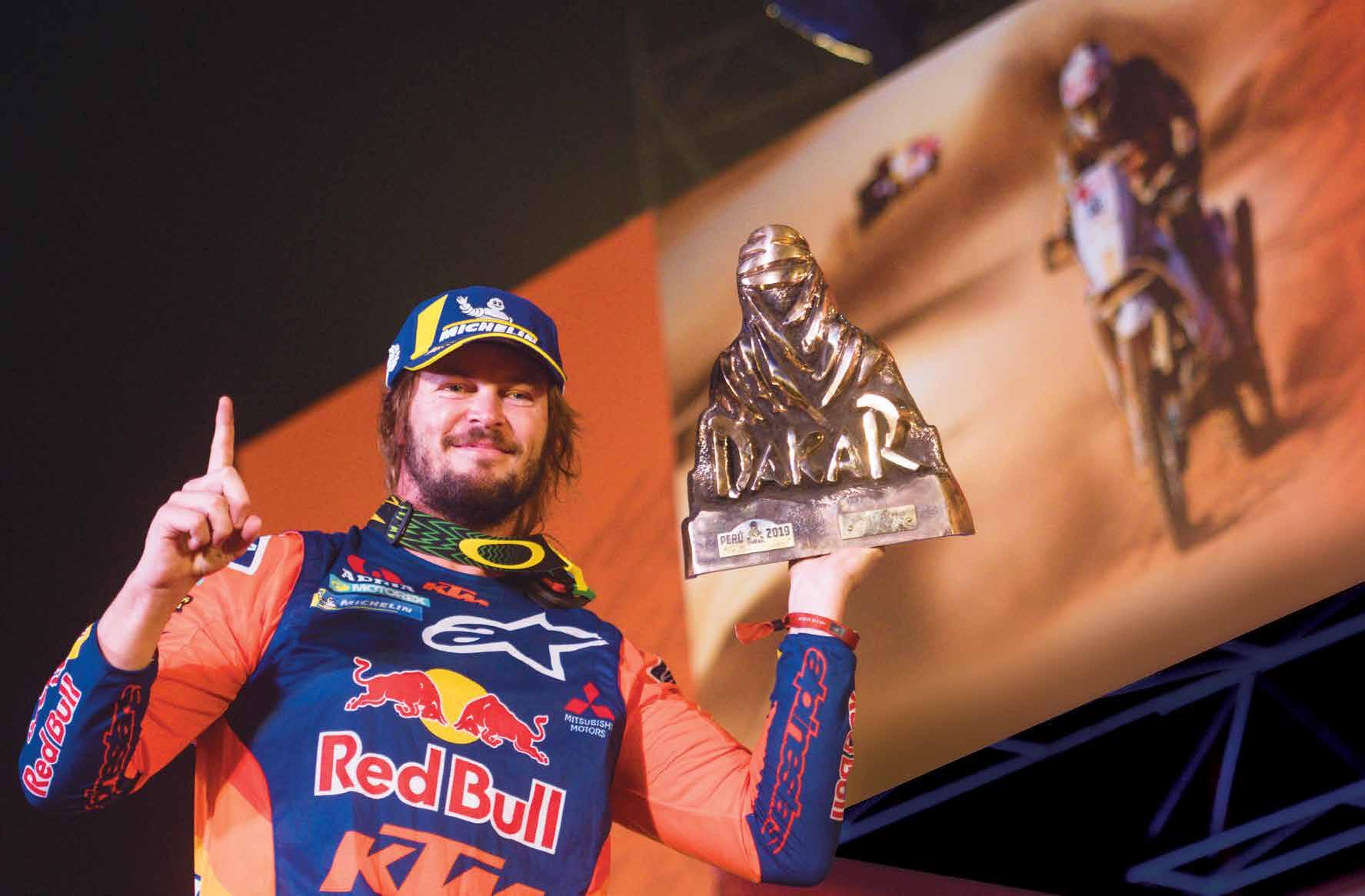
Gold Coast-based Toby Price has taken his second Dakar victory and his first FIM world championship. He currently holds the record for the most Finke wins. At 31 he’s surrounded by opportunity.
Adventure Rider Magazine was lucky enough to speak to Toby after his first Dakar –and podium finish – in issue #10, then again after his first win in issue #17. Sitting down with him this time felt like a catch up.
AdvR: Even though you’re recovering from surgery after the scaphoid repair, is it a bit like holiday time to be sitting in your own home in Australia?
TP: One hundred per cent.
There’s no feeling like being in Australia. As soon as the plane lands on the tarmac here in Brisbane it already feels like home.
AdvR: What’s your forecast recovery time?
TP: I’m guaranteed three months off a bike. Off a pushbike. Off everything.
The scaphoid just doesn’t get good blood flow to the bone. It takes time.
AdvR: So where does that leave you for defending your FIM Cross-Country Rallies World Championship in 2019?
TP: I’m probably going to miss the first round, so my hopes of defending that title are pretty much dashed for this year. But having won the world championship in 2018 and
That’s a little bit hard to take at the moment, but the doctor said it can be anywhere up to nine months. At this stage we don’t know how that bone’s going to heal. I worked it over pretty damn decent in the Dakar. I was only a few days off my wrist collapsing at the end and I was lucky to make it through to the finish line. We’ll wait and see.
u
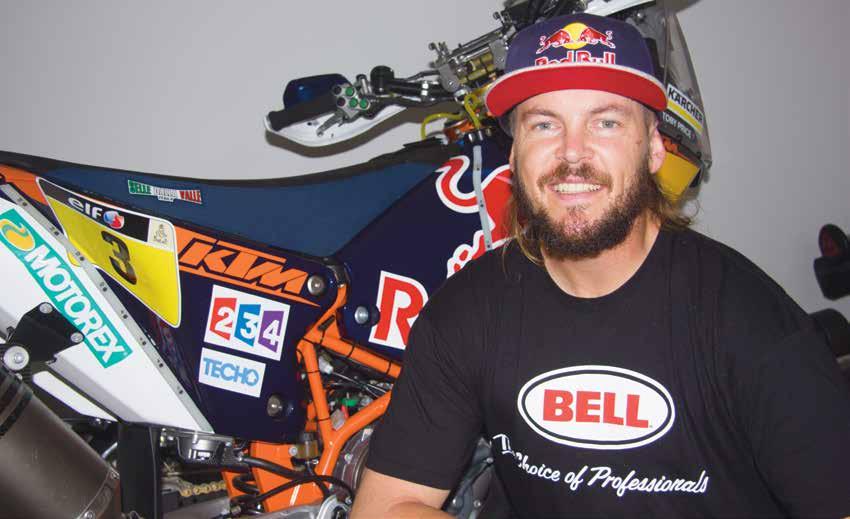
Dakar straight after, I’m over the moon. I’m stoked with that. I didn’t think those two would even happen, and to have them around the same time, around the same year basically…it’s an amazing thing to sit back and look at these two trophies.
It’s all been worth it.
AdvR: What do you have planned for your three months rehab? What will you do with your time off?
TP: Everyone expects that while I have an injury I’ll sit at home, but it’s nothing like that. I’ve got a lot of sponsors I’m very lucky and grateful to have. These are the times where those people are keen for me to do sponsorship appearances and… AdvR: Magazine interviews?
TP: (Laughs) Magazine interviews, radio interviews…it never slows down. Whenever I’m not on the bike there’s always something else that can be done to fill in the time. We’ll do a couple of trips to Sydney, a couple of trips to Melbourne, just promotional trips and see sponsors and things like that.
AdvR: How will you look after your fitness during the downtime?
TP: It needs two or three weeks to recover from the stress of Dakar. I’ve passed that. I’m starting to feel like I’m getting my head back and now the wrist is the biggest hold up. I can’t do any
training because I’ve got new cuts and sutures in my wrist and my hip. My hip feels like it’s a junk heap at the moment. Once I get the stitches out, the doctor can say when I can get onto some things. It’s not going to be riding a motorcycle or mountainbiking. It’s going to be a lot of time inside a gym, probably starting with stationary bikes. Once the hip calms down it’ll be stair climbers and things like that, just to keep the cardio going.
my own house and my own bed.
AdvR: Is there anything special you do to your Dakar bike? Your mechanic Joe, who’s been with since you joined the factory team, seems to have the bike well sorted, but is there anything personal you ask for?
TP: Not really.
We’ve got so many options we can choose from. For sure I’ve adjusted the frame a little bit to suit me. My frame’s a bit more rigid, just for those high-impact, hard hits, and I think my footpegs are about three- or four-millimetres lower.
The X-Tourer D-Dry® Jacket combines vers and all-weather protection in a unique 3-la ment. The perfect choice to enjoy the riding journ round. The removable and packable 20 000mm D-Dry® membrane provides protection in When things start to heat up, remove both liners maximum ventilation. Oversized ventilation panels on the chest, sleeve and back allows for cool air t rider
Then it’ll be whatever I can do to keep my strength up without using my right wrist. There’s always plenty to do. There’s nothing you can get away with.
AdvR: Any helicopter riders after the win this time (see issue #17 – ed)?
TP: Not as yet.
But in all honesty there’s nothing random or very weird about my bike. Anyone who rides on the weekend, just for fun, could easily jump on my bike and probably wouldn’t notice any difference to other Dakar KTM customer bikes.
It’s just KTM has a good record with keeping the things on the track and running, which is the main thing. AdvR: Honda’s Ricky Brabec looked pretty peeved about his mechanical failure.
TP: For sure.
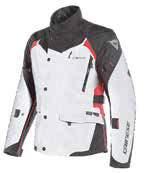
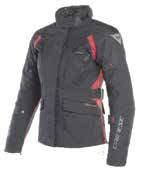
CASSONS PTY LTD - AUSTRALIA
P: +61(0)2 8882 1900 F: +61(0)2 8882 1999 enquiries@cassons.com.au www.cassons.com.au
NORTHERN ACCESSORIES LTD - NEW ZEALAND E: sales@northacc.co.nz - W: www.northern.co.nz
That’s another thing I have coming up. I think KTM and Red Bull in Austria want to do a party to say thanks. Right now I’m just loving being back in
“I’ve got new cuts and sutures in my wrist and my hip. My hip feels like it’s a junk heap at the moment.” u
E: enquiries@cassons.com.au www.cassons.com.au
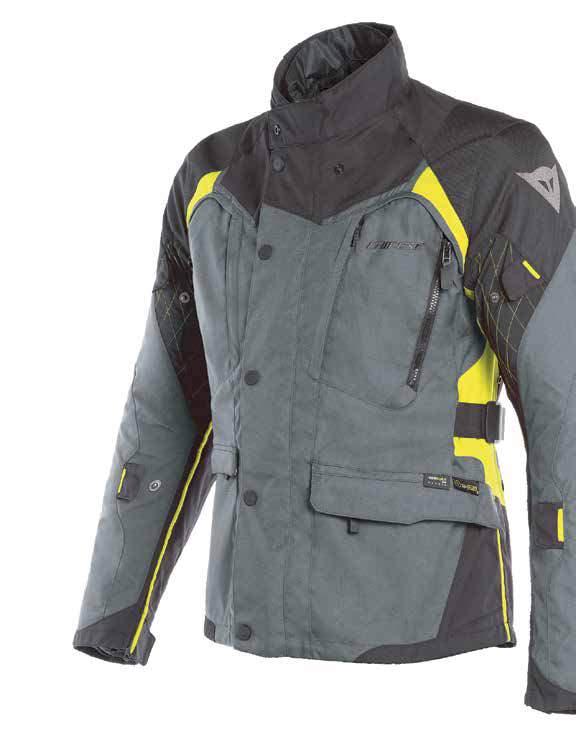
But that’s just what the Dakar is. At the end of the day it can happen to us at KTM, too. It’s just racing. It’s been hard for him. think he was most upset at having the same issue two days from the finish two years running. When that happens you’ve already been through hell and you’re on your way
NORTHERN ACCESSORIES LTD - NEW ZEALAND sales@northacc.co.nz www.northern.co.nz @cassonsaustraliamotorcycle
NORTHERN ACCESSORIES LTD - NEW ZEALAND @cassonsaustraliamotorcycle
Cassons Australia Motorcycle
Cassons Australia Motorcycle
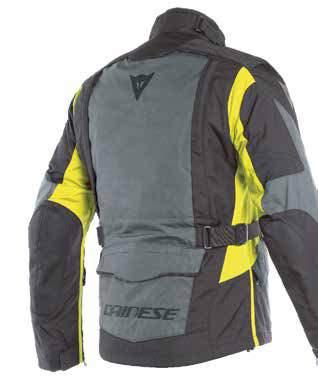
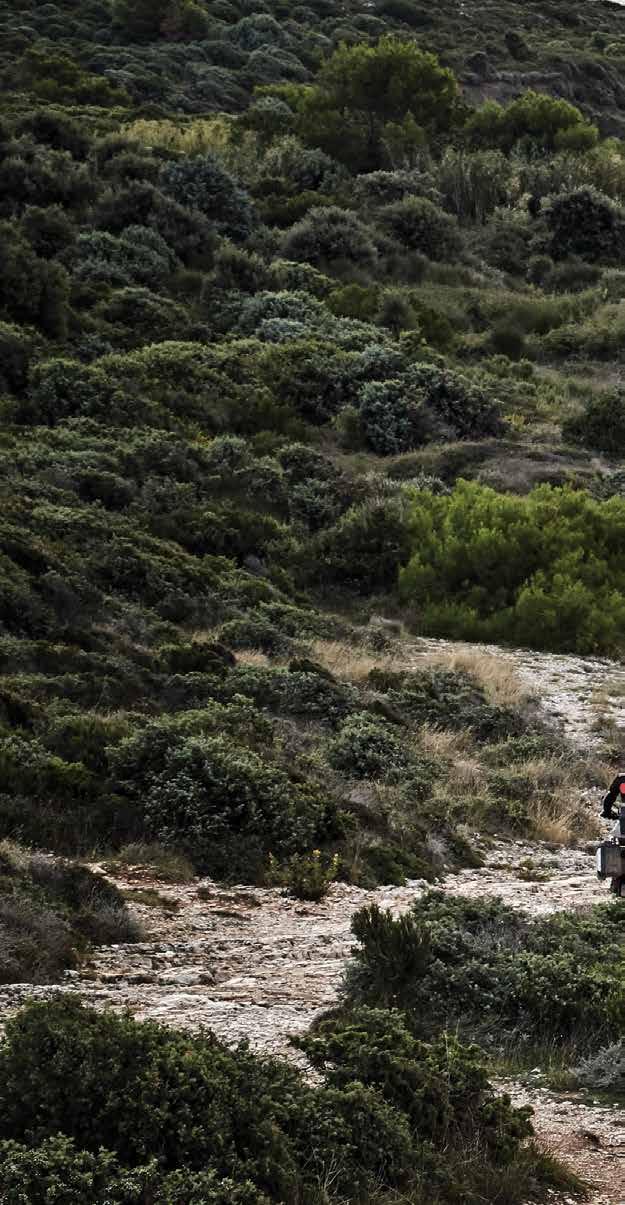
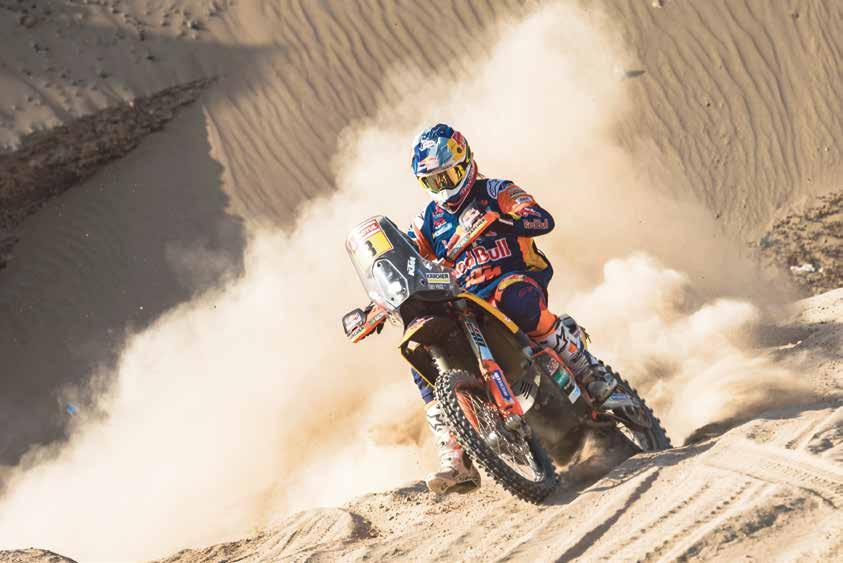
back to try and get out of there. That’s where it hurts a little bit. Especially for him. He was in the lead and on a charge and showing us he’s a force. He’s going to be a strong one for next year, for sure.
AdvR: You were in good shape. At one stage you were in sixth, and we thought, ‘Gee. If he was dead-set healthy, that’s about where we’d like to see him to maybe be in the top two or three at the finish.”
TP: A hundred per cent!
At the end of each day I was sitting in the best place possible to be starting the next day’s stage, and that was in the back of my mind.
wish I’d been 100-per-cent healthy, because with the wrist I had it was definitely not an easy task. I had to really dig deep to find something to try and hang on and ride for the whole day.
AdvR: Were you using painkilling injections?
TP: No injections or strong painkillers are allowed. I could take a couple of Panadol, which basically does nothing, and probably gives about half-anhour of comfort in the morning. But we were riding anything up to 12 hours each day. Nothing was
going to get me through that.
Every day I made it back to the pits I was thinking, ‘Is it really worth it? My arm’s killing me. I’ll pack up and head home. That’s enough.’ But then I’d look at the paperwork and go, ‘I’m in the best place possible!’ I couldn’t give up then, because I knew if I could keep myself in that position for the next day was going to
be in the best place possible again. It just happened. It just started snowballing. My team manager, Jordi, kept saying, “You can quit, but you’ve got the best opportunity and a chance to win this race. It’s up to you.”
So the helmet would go back on and away we’d go again, wide open. AdvR: You and Ben Grabham both have
u
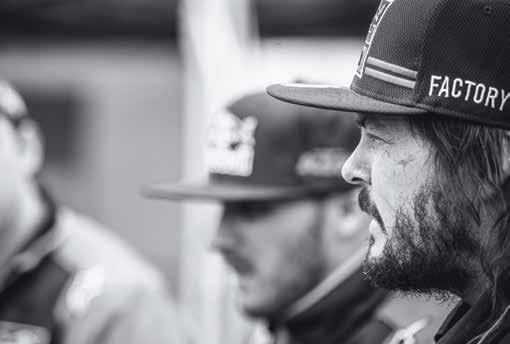
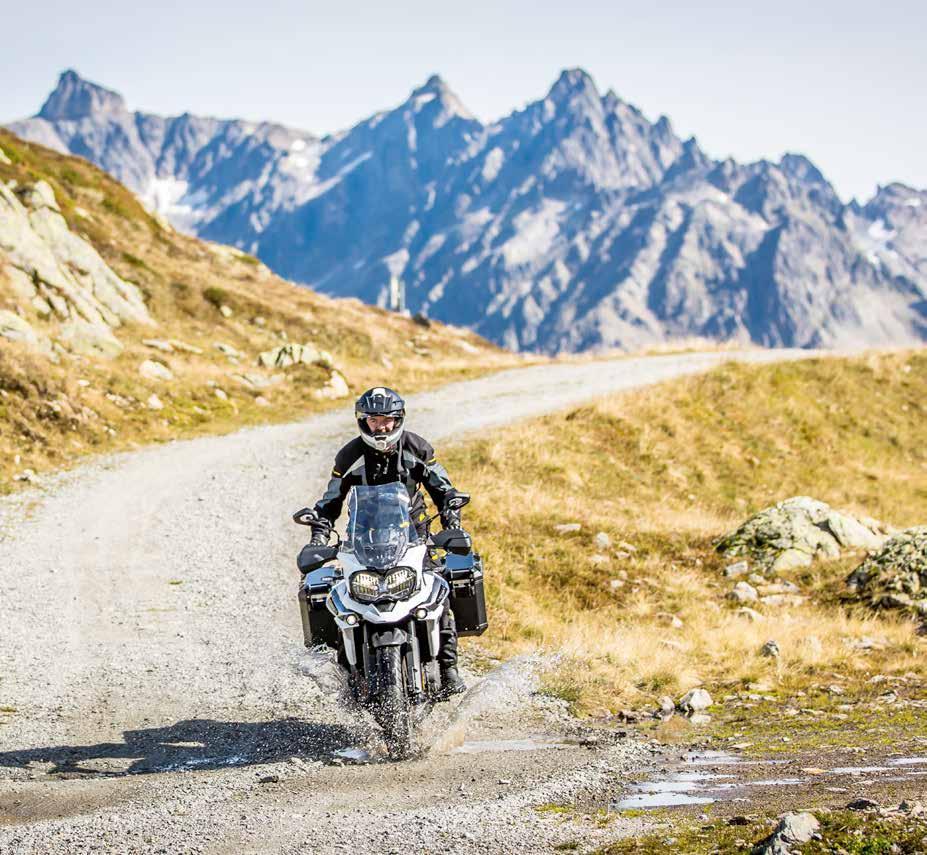
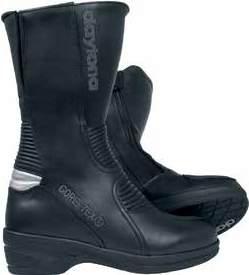
The
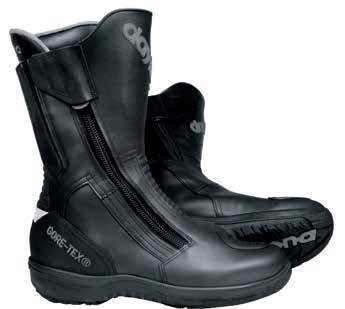
an incredibly high tolerance for pain. Is Ben an inspiration to you in that regard? When things are bad, do you think back to what you’ve both been through?
TP: For sure.
I’ve always known Grabbo to be one tough bloke.
going to drive as many cars and Can Ams as I can, and I just try and jam-pack my year full of everything. I like to have fun.
At the moment I’m laid up and the doctors won’t let me do anything. I’ve just got to take it a little bit easy with this injury and make sure we get it right so I can get longevity out of the whole two-wheel career. For such a small bone, it’s one that can bring everything to a stop.
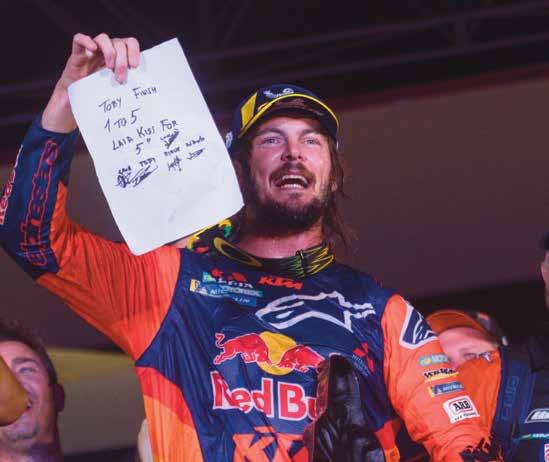
When you’re in a lot of pain yourself, you look back at all the worst times you’ve had and go, ‘I’ve been a lot worse than I am at the moment,’ and you just try and gee yourself up and get back out there and go again. At those times I think back to my broken neck and Grabbo’s broken back.
AdvR: How is it being world champion? What does that change for you day-to-day, race-to-race, and looking at the next 12 months to two years?
TP: From day-to-day it doesn’t really change too much.
For me it’s a rad trophy to have on my shelf and a rad gold medallion to say I’m a world champion, but for myself, it doesn’t change. It’s the same race schedule: five rounds of the FIM Cross-Country Rallies World Championship again this year, and then Dakar again in January 2020. It’s all pretty much full gas and wide open. I’m still doing all the same things. I’m still
As soon as you’re going to have a crash it can register that in milliseconds and puff you up like a Michelin Man, and it stays puffed up for about a minute. If you can get back on the bike it’s a bit of a mission to ride for the first 30 or 40 seconds, but the system they have, and the technology they’ve come up with, is unreal.
AdvR: We all want to know: is there any chance of you and Laia Sanz having kids? We’re all busting to see how fast those kids would be.
TP: (Laughing) I’d like those chances to be good, but I don’t think so, especially with the haircut. She left me with a ponytail at the back, but it’s still a mullet, so I can still claim that.
For me she’s a queen, and you always greet a queen by kissing her on the hand, so that’s what I did. Plus, her boyfriend was there beside her. I was in no fighting
“ I’ve been able to win it once, but to win it twice was twice as hard. So I’m expecting the third one to be three times as hard.”
mood with my right hand in the shape it was in (laughs again). He’s a good dude. It was just a joke while we were all sitting at a table. It was just a bit of fun. Then suddenly the whole thing made national news in Spain and everyone was talking about it.
I have to be very gentle with the thing and look after it and try and make it work.
AdvR: Will you match Cyril Despres’ five Dakar KTM wins?
TP: I’ve been able to win it once, but to win it twice was twice as hard.
So I’m expecting the third one to be three times as hard.
The boys are putting on a good push and we’re trying to keep that KTM streak going, which is cool. We’ll aim for another three to get that five, for sure.
AdvR: How did you find Alpinestars’ new Tech Air jacket?
TP: I wore it in a lot of training and some of the world-championship rounds. The thing’s absolutely amazing.

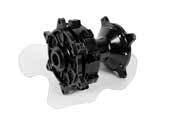
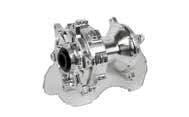
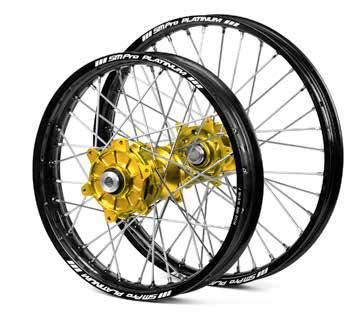
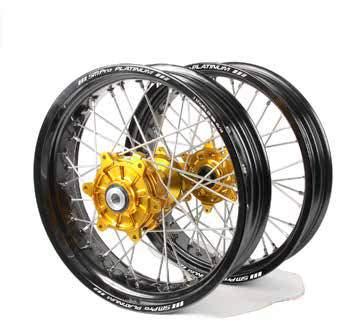
AdvR: Did you think the kiss/haircut bet was likely to come off?
TP: I never doubted her at all to be in the top 15, but I was hoping my wrist was really going to be bad, and then by day four or day five I’d have packed up and been on a plane home anyway. So when she was inside that top 15 I wasn’t going to be anywhere to be seen to have the haircut.
I was going, like, “Yeah, nah. I’ll be safe. It’s all good.”
I was 90 per cent sure Laia would be inside the top 15. She’s an amazing human. What she does on a motorcycle, it’s unheard of. just didn’t think I’d be there at the finish to have to worry about it.
u
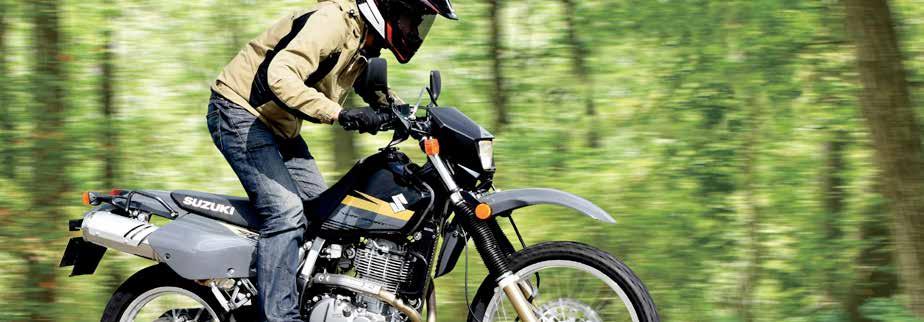
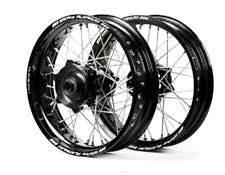
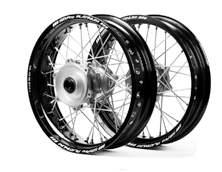
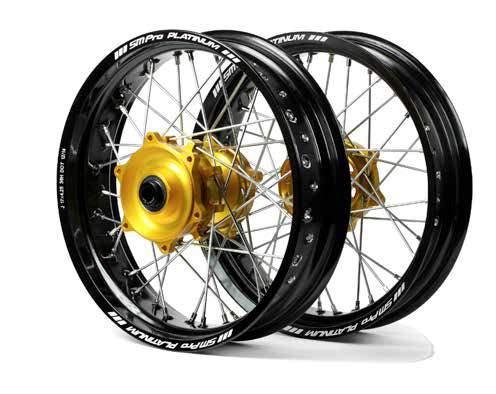
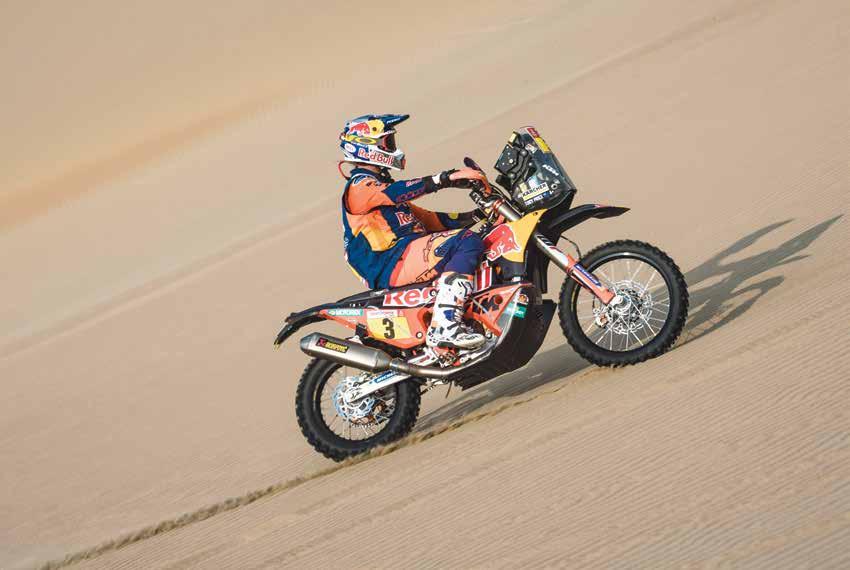
AdvR: She has nine Dakar finishes. You haven’t got that.
TP: Exactly. She’s one of the most amazing females I’ve seen.
I’ve seen this race break grown men. I’ve seen men in tears during Dakar. When days get tough, like when my wrist was on fire, I’d think, ‘Shit. Laia’s out here doing this stuff.’ That would help me keep going. We get along really well. There’s always good banter, so it’s awesome.
AdvR: Is the iron-man double on this year?
TP: It depends on this wrist.
said to myself when I crossed the finish line at Finke last year, “I’m happy with that. That’s two-wheels at Finke done. Finished.” I had the record number of wins and it was all good. But then, come October or November, the plan to go the double starts again. I just don’t listen to my brain sometimes. It’s definitely in my plans. I put the entry in for the bike, but it depends. A threemonth recovery would give a couple of months to try and be organised for the bike. But if recovery takes six months, that takes me right up to the Finke date. I’ll see where I’m at in three months time.
For sure the truck will happen at Finke, because in six months the wrist’s going to be kind of back together. I’m in a madeup brace at the moment, and I can make a brace to suit the steering wheel and I’ll be able to hang on.
But we’ll wait and see. It’s a bit early to tell.
I definitely want to do it again.
through all the desert racing and in the Dakar and the world championship, I’ve got everything I wanted to win and do. Now it comes back to wanting to win more Dakars and world championships and just keep doing it.
On top of that, for the future, we – the team – are just trying to see if can race Dakar in a car.
That’s definitely not an easy task. Those seats don’t become available too often. To try and get into one of those cars takes big, big, massive budgets. To hire one of the Peugeots they’re running at the moment is over a million euro, not including having to pay damages after 10 days of carnage.
That’s a burning desire though, to end up in one of those things in any of the teams running near the front.
I’d love to win a few Trophy Truck races in the US, too.
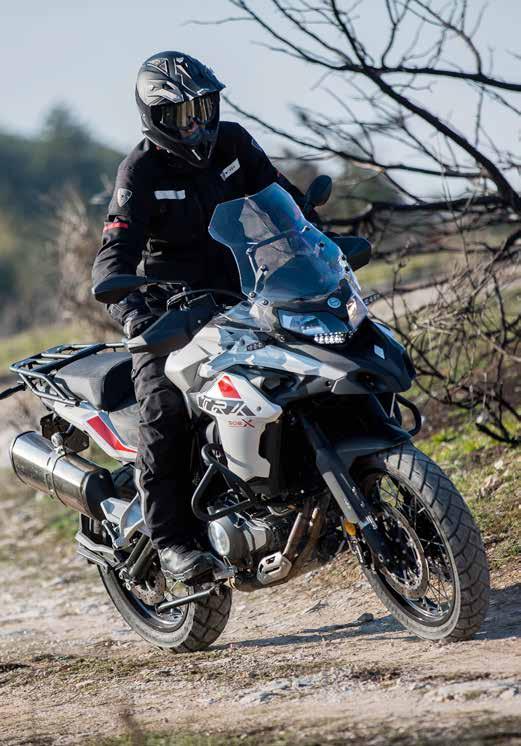
AdvR: You’re a world champion, you’ve won Dakar twice and been on the podium twice more, and you hold the record for Finke wins. What’s left for you to do?
TP: That’s it. Basically now if I hung my boots up tomorrow, I’d be 100-per-cent happy, for sure. With what I’ve been able to do
“But then, come October or November, the plan to go the double starts again. I just don’t listen to my brain sometimes.” u
For sure I’ve got another five to eight years left on two wheels, but I want to start trying to pave the way a bit for four wheels. Two wheels isn’t going to last forever. I’ll go for more Dakar wins and world championships and see where the body’s at.
AdvR: You’ve achieved so much that there
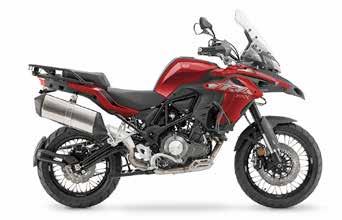
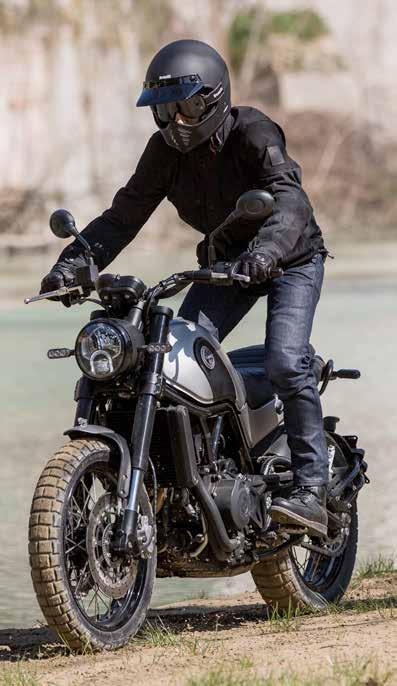
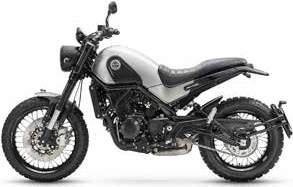

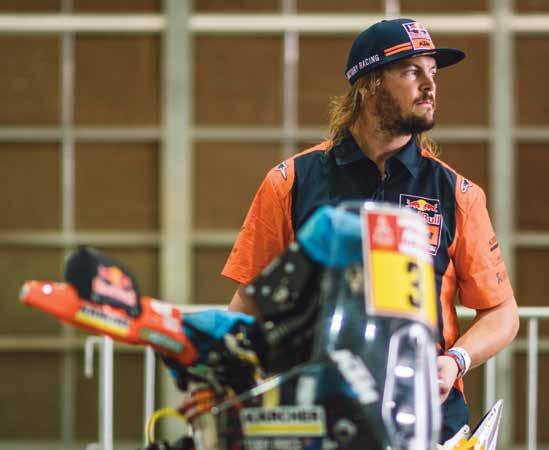
can’t be too many riders in the world who could offer credible advice. But you’re also moving in circles where those very few riders who have an even more impressive CV than yours are available to you. Who’s your mentor at the moment?
TP: To be the rider, to be the person that gets the wins for the team, comes from the people behind the scenes.
Inside KTM there’s guys like team manager Jordi Viladoms. He raced Dakar for 10 years. He’s like the team’s manager/ mentor/coach. We always go to Spain, just outside Barcelona, and train at his house. He’s a big mentor for us. But there’s guys on the KTM team who have 19 Dakars. They’ve been there pretty much from the get-go and been through every single KTM win. They tell us ways to do things that make it a bit easier, and show us how to prep things in the campers and trucks and so forth. I’m always listening and always trying to take in some information I hadn’t heard before. Even if I had heard it, it’s always good to hear it again.
AdvR: When we spoke to you before your first Dakar you were worried about coping with the navigation, and several times since you’ve mentioned how important it is. Do you feel you have the navigation wired in your mind now?
TP: The road book isn’t easy to read, but we’ve been able to work our way around it.
From day to day it can just change so much. When Barreda got stuck in this
we could’ve seen the easy access roads. But we didn’t have clear air and he went straight on, down a cliff and into a rocky ravine. He got stuck and it finished his race. He wasn’t injured, the bike was good, it was just that shit area location, and being up there in that fog and not being able to see where the track went.
So it doesn’t matter how good your navigation is, something simple like that can still take you out of the race.
But we’ve worked it out. We’ve been doing well with it. We can definitely show we’ve got speed while navigating, so I’m happy.
AdvR: Did you have Quintanilla covered on the last section? If he hadn’t crashed, did you feel you would still have won?
year’s event, it wouldn’t have mattered if you’d had a road book right in front of you. You couldn’t see the track. You couldn’t see anything because of the fog. When the organisers drove through there it must’ve been a clear day. The course plotters must’ve gone, “There’s an easy access road here, an easy access road there, and you get on this road to cut across to the top of the mountain and
“To be the rider, to be the person that gets the wins for the team, comes from the people behind the scenes.”
then you’ll hit a waypoint and you can cruise down the mountain and you’re out of there.”
It sounds so simple.
I’m sure as hell if I went back up there right now and it was open and clear, that’s what I’d see. But when you’re on the bike and you literally can’t see three metres in front of you, your goggles are streaming with water from the moisture in the air, and you’re trying to pick your way through the fog…
I think when Barreda got close to the waypoint the arrow in the roadbook just pointed straight. If we’d had clear air
TP: I felt like I still had him covered. That last 100km it was about how bad my wrist was, and I knew I was going to make it twice as bad. I was prepared to go hard and swing off the bike and cop whatever damage was done to get the win, but Pablo stopping definitely lifted the weight off my shoulders a bit. It’s never good to see how heavy that crash was.
I didn’t see it with my own eyes. I only saw the helicopter footage when I got back at the end of the day. That was a hard hit and it could’ve happened to me and put me out of the whole race. Even after I passed him there, laying on the ground, I still had 95km to do, and it could’ve happened to me even if I was just cruising and trying to make it to the finish.
AdvR: Is there a team benefit from living on the Gold Coast?
TP: Not really. My main contract is with KTM Austria and the Aussie KTM factory team is based down in Sydney. I’m not making a shift to go over there. I love being here in Australia.
I’d love to maybe make a move to the US for a few years and just live over there, but I also think I’d get over it pretty quick and want to come back.
AdvR: Is racing Trophy Truck anything to do with thoughts of living in the USA?
TP: For sure, it’s a bit of drawcard. I have a couple of good friends there and some good connections that’ll let me drive their cars and trucks. But at the moment my main priorities and goals are with two wheels. While ever I can race dirt bikes
I’ll keep myself based here in Australia, I think. Australia’s always home for me and I love coming back here.
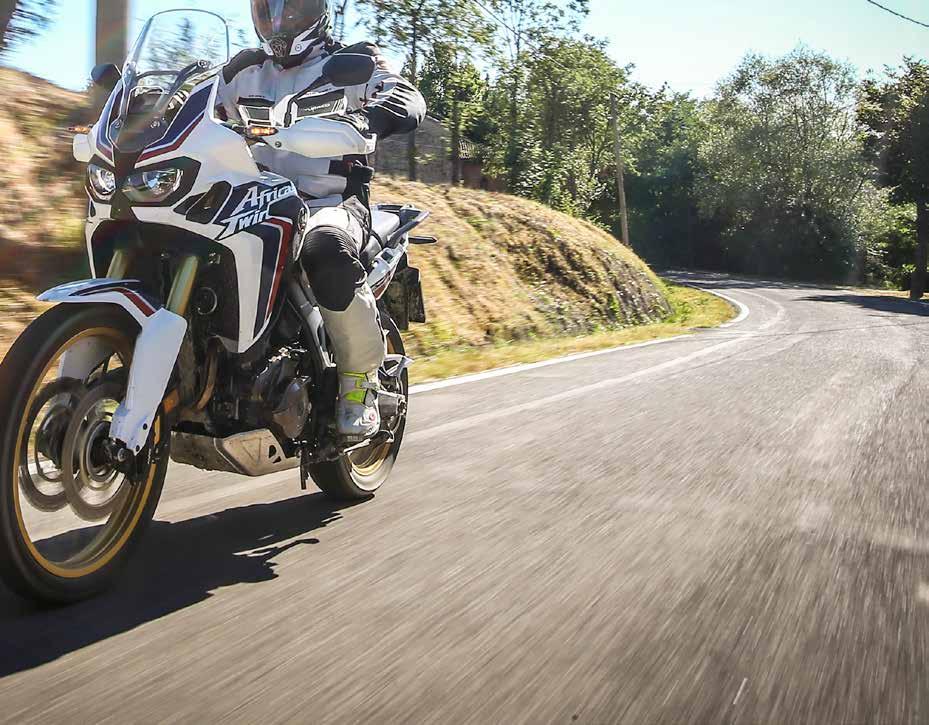
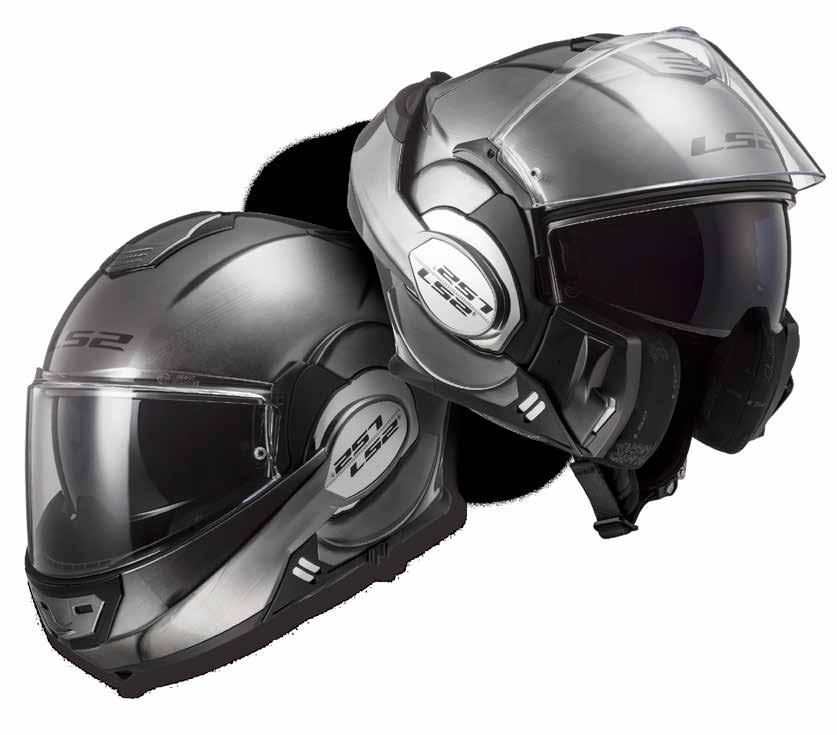

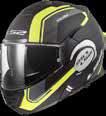
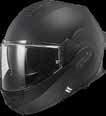
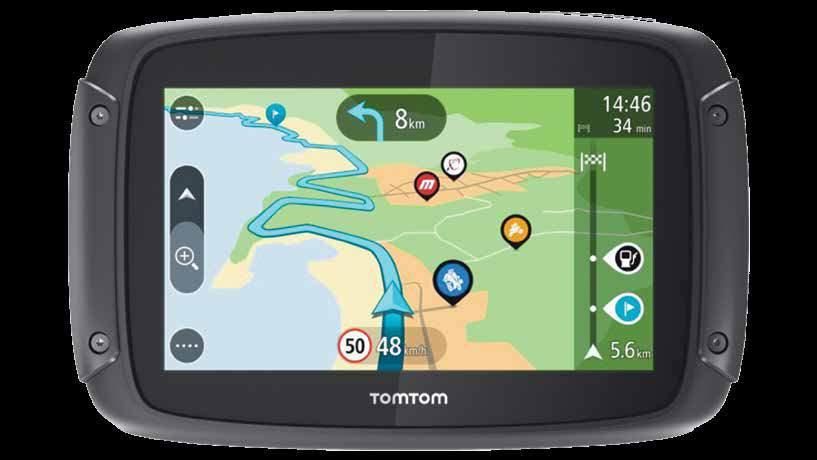
Who picked up the TomTom Rider 550s we gave away on our way-more-interesting-than-everyone-else’s Facebook page? Read on to find out…
We were belting along, having a ball with the TomTom Rider 450 and 550 the folks at TomTom had given us to try out, and we were telling anyone who’d listen how good they were. We even told TomTom how good we reckoned they were. We navigated all over like mad buggers, loving the convenience of the wireless updating and the fact we could actually use the software without wanting to punch ourselves in the face with frustration.
Then the TomTom folks said, “Seeing as you like them so much, why don’t you give a couple away. Then your readers can see how good they are, too?”
First we thought they wanted to give away our two – a 450 and a 550 – and we went all quiet. But then we realised those champions at TomTom headquarters meant two brand, spanking new ones!
So we were In Like Flint (the 1968 blockbuster starring James Coburn. Not the dumb-arse flick that couldn’t even get the name right last year).
Liked!
Anyhoo, we had one of the tech-savvy girls in the office (she’s got an iPad and everything) do a Facebook ‘post’ saying we were giving away the two units, and asking people to tell us why the deserved to win one. Next thing we knew we were smashed with heartbreaking stories from the navigationally challenged, all desperately crying for help. Some were funny, some were sad, and some…well. To be honest, some didn’t try all that hard. Responses like ‘giv me 1 u bstrds’ were quite correctly ignored.
After going through at least a squillion entries, two very deserving winners were chosen. Here’s their stories…
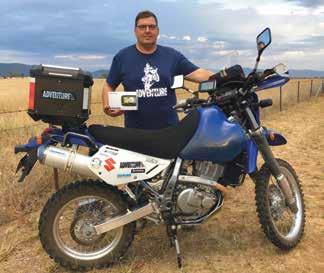
ReadinG, 50, TaMWORTH, nSW.
Reado was already a happy TomTom owner, and his entry made it clear he was stretching out to help other adventure riders enjoy life. Whooshka! He was in. He received his Rider 550 and told us:
“I’ve had a TomTom car GPS for a long time, and I’ve used my TomTom account to do updates but not access MyDrive to create routes. I found creating routes with the TomTom software to be especially easy on a bigger-screened computer and nearly as good on a tablet or phone. It’s great how the route created on any device simply syncs straight to the Rider 550 wirelessly and you’re ready to go.
“The Rider 550 has a really clear screen and the interface is easy to use. It’ll be great to plan routes, track rides and share them via Bluetooth or GPX files.
“Last night I was planning options for a ride to Bright in Victoria for the AuStrom Birthday Bash. The TomTom Rider 550 will make this planning so much better!”
Good on yer, Eric. You’re a top bloke, and we hope you have a ball with the new Rider 550.
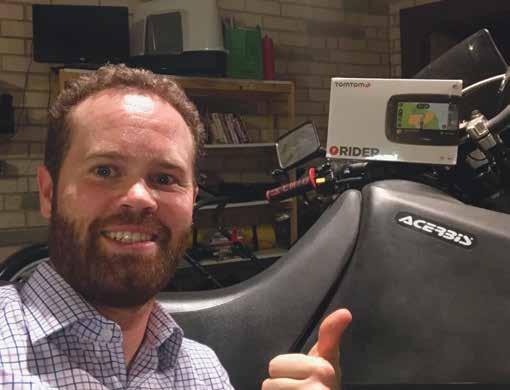
Aidan’s story of woe had us nearly in tears. He dumped his beer supply! Our bottom lips are quivering at the thought even now. He got lost, too.
After a day like that, we thought the least we could do was line him up a new GPS. At least he wouldn’t have any trouble finding his way home in future, we figured.
“It was just one of those motorbike camping trips that went wrong,” territoried Brightee from the nations’ capital. He told us the story all over again, but this time filled in some of the gut-wrenching detail. It was a saga of triumph against overwhelming odds. He lost a thong in the river as well as dumping his beverages, almost untasted. But he soldiered on, in true adventureriding style, until he got geographically confused trying to get home.
“I was in the mountains and managed to get myself lost on a forestry road. I spent about an hour going round and round in circles trying to find the right road to get back out again.”
Aidan hadn’t had a chance to fit the TomTom when we spoke to him, but he was dead-set rapt with it. Big props to you, Brightee. Next trip, hit the ‘home’ button on the TomTom and you’ll be as right as rain.
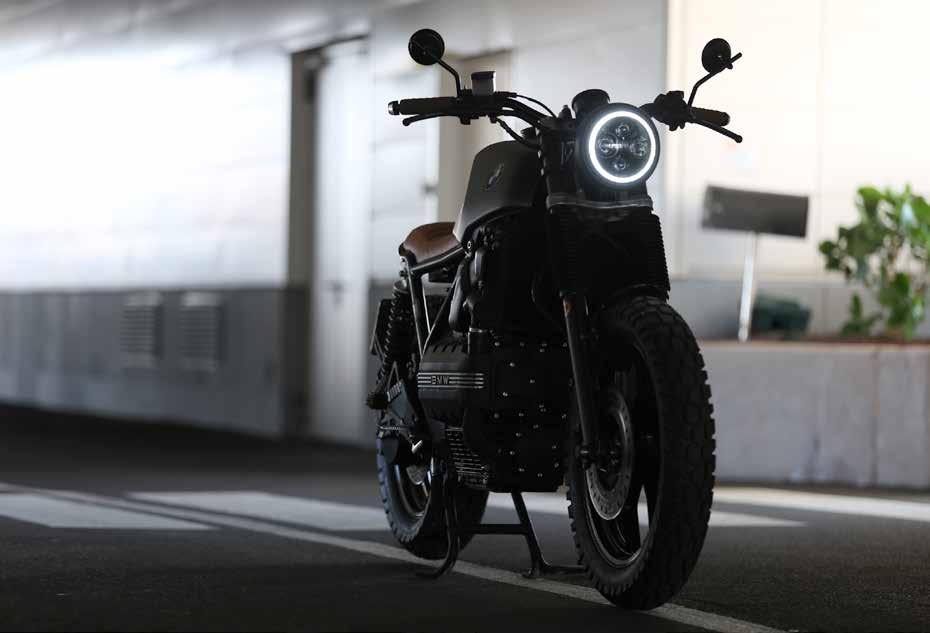

Mineral-rich Mongolia is awakening and the time is right to experience that magnificent vast and silent land as it is, rather than what it will be in the not-too-distant future. Michael Burton and Mid Life Adventures took a group to ride across the empire of Genghis Khan.
u
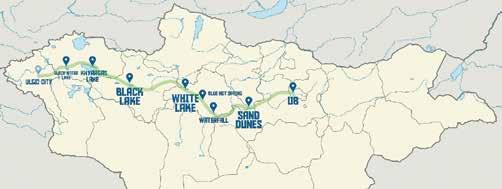
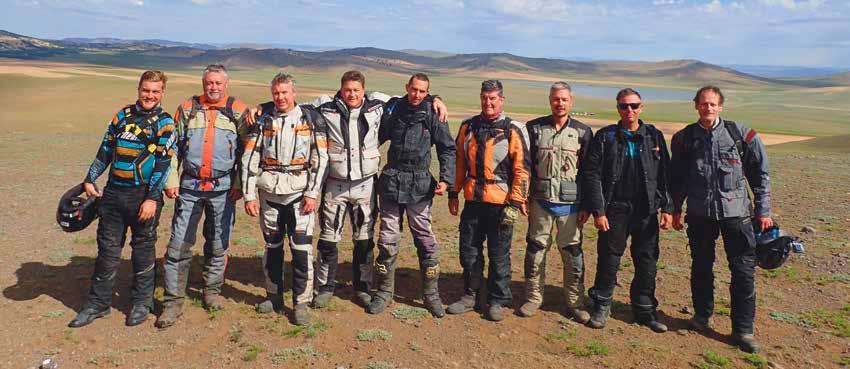
The world has changed significantly since I started adventure riding nearly 22 years ago. But preparing for this trip across Mongolia and the experience gained would be exactly as it was when Genghis Khan ruled that nation. I had little doubt, if we were to make the same journey in 20 years, the difference would be that the showers would work and the toilet wouldn’t be a hole in the ground in the middle of the steppes…and we’d be riding electric bikes, not firebreathing KTMs and Huskies.
UN likely Mongolia is on the move. The capital city, Ulaanbaatar, is starting to become a city of skyscrapers as the Chinese infiltrate from the east with treasury loads of Yuan to establish a foothold, just as they’re doing in many other nations. Outside of the city though, the nomadic way of life remains the domain
of humble, welcoming families who treat Mother Earth with dignity and respect.
This was the Mongolia we 10 adventurers had come to see, and before long the eager young Austrian ponies were on the dirt heading southwest across the steppes, past the armoury and platoons of the United Nations who use the area as training grounds, to the overnight camp at Elsen Tasarkhai, part of the Mongol ELS sand dunes.
We arrived in the early evening to a welcome, warm, thirst quencher, a great meal in the dining ger and a hot shower.
On only the second day of the ride we all felt as though we’d been away from our loved ones for a month. We’d spent a few days in walking the Great Wall and taking in other Beijing highlights in China before crossing to Mongolia, but we hadn’t jumped on the bikes until we arrived in Ulaanbaatar. That made it seem as if we’d been away even longer.
The dunes echoed with the sound of rev-limited EXCs, particularly from one
Austrian, on an Austrian, who pursued the ‘unusual’ noise from his engine while the rest of us waited for the ‘pop’.




After a photoshoot with hunting eagles and a banquet lunch at a local pub we passed through the ancient city of Karakorum and were soon in deep, green valleys. The incoming rain filled the creeks which crossed our route and tested out the electronics on the modern machinery. Fortunately the rain skirted our camp and allowed the ‘Slaughter Of The Lamb’ ceremony – our dinner – to be the main event for the evening, followed by an incredible light show in the western sky. Some chose to cast a line in the river rather than watch the butchery, but with little angling success.
Above: From left: Rob Moffett, Bob Moffett, Mike ‘Goldie’ Golden, Neville Kelly, Ben Pope, author Michael Burton, Lars Hyltoft, Dan Ballantyne and Siggy Strauss. Below: Sandy tracks and grassy fields became skid pans.


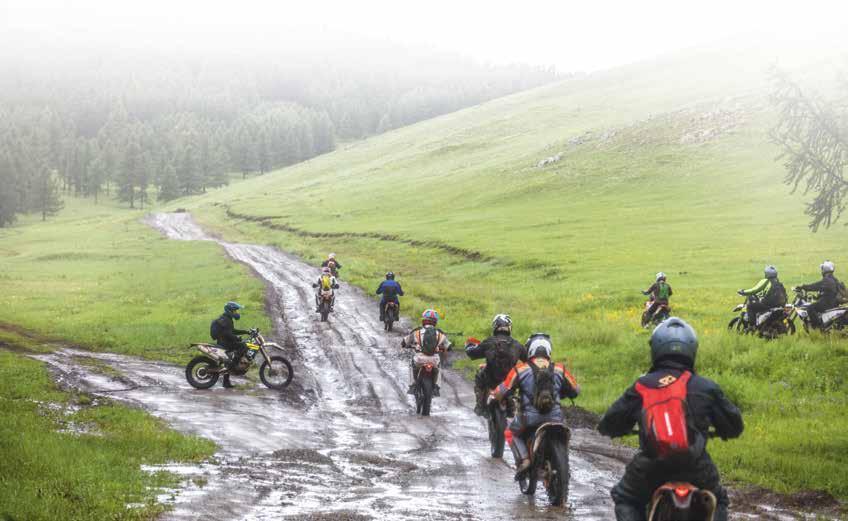
u








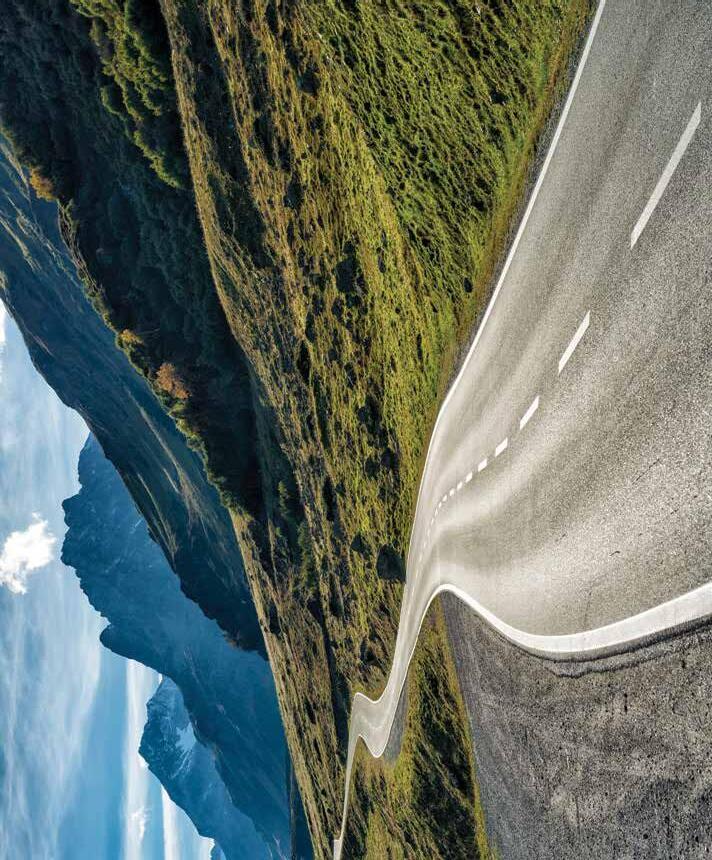
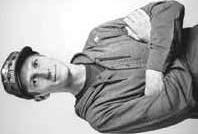
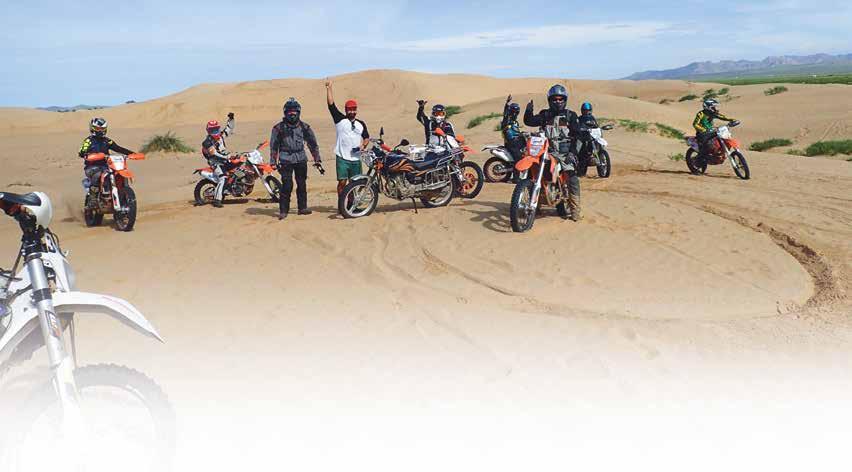
The stopover at the Ulaan Tsutgalan waterfall on the Orkhon River, a UNESCO World Heritage site well attended by tourists, gave one of the guides the opportunity to show his piloting skills as his drone buzzed within spray distance above the cascade.
The previous evening’s storm had added a new dimension to the ride.
Sandy tracks and grassy fields became skid pans and trickling brooks became raging torrents, one fierce enough to dislodge Tony and cause instant death
to his Austrian mate. While the crew attempted to revive the dead, the rest of us sat in the hot springs enjoying not the medicinal herb tea of the area, but rather hops and Cuban cigars.
It was a fitting way to end the day.
As the skies transformed from deep shades of grey to brilliant blue, the riding style changed, becoming more aggressive as the tracks dried. Ben found just the right black, muddy puddle to launch a premeditated move into the middle, roosting the black porridge metres into
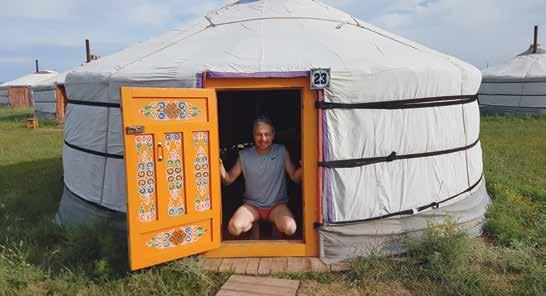
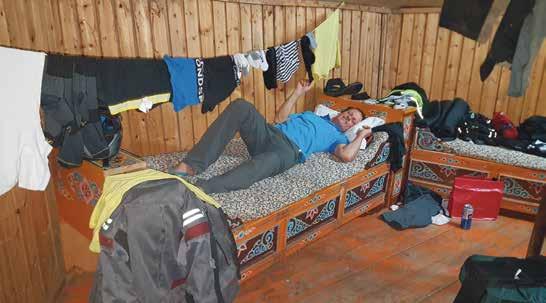
the air and landing on Yours Truly following behind.
An early stop in a local town where black-market traders sold from shipping containers gave us a chance to stock up on treats before we lunched, again on ‘fatty’ meats, at the Serpent Head Rock, a tourist hotspot where the riders attempted archery, a ‘yonnie’ throwing contest won by the tour operator, and a ‘tame’ jaunt on two of the more attractive llamas proudly led by their herder. Arrival at the White Lake in the late afternoon allowed time to climb the adjacent rocky lookout for a magnificent view over the camp and the lake as the sun settled down for the evening.
With early-rising German tourists crowding the showers, Mike ‘Goldie’ Golden hit the lake for a scrub. I don’t think the soap even touched his skin before he turned brittle with the cold. This was a transport day and the knobby tyres didn’t make for a comfortable ride, so we were glad for the opportunity to get off the tar and into the deep sand surrounding Telmena Lake. It was our overnight camp, and the image of Dan’s head sticking out from the remote dunny still brings a laugh.
Our tour leader had clearly been working out in preparation for the Naadam Games and threw down the idea of a wrestling match. The challenge was quickly taken up by WA gentlegiant Nev and lead rider Boggie, only to be declared a draw after several rounds of competitive grasping,
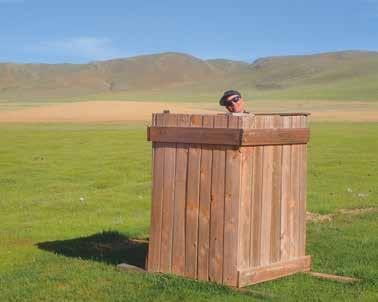
Above: The image of Dan’s head sticking out from the remote dunny still brings a laugh.
Below: The effect of the 12-per-cent Bear beer quickly kicked in and the wrestling concluded as warriors stumbled and fell.
gasping and groaning like two wounded sumo wrestlers. The effect of the 12-per-cent Bear beer quickly kicked in, on some faster than others, and the wrestling matches concluded as warriors stumbled and fell with little assistance.
The next day was the biggest – 400km – and an early start meant early lights out…if there’d been any lights. Fortunately the summer days in Mongolia are long, with the sunrise around 5.00am and sunset after 9.30pm. It was just as well, as the next day Nev’s bike refused to co-operate, providing inconsistent fire to the belly of his KTM. The rocky ground also took its toll on the support ’Cruiser’s tyres.
With the spark problem traced to a loose terminal (after MLA’s mechanic dismantled half the engine) and the tyres repaired, it was full steam ahead through the deep sand to Khyargas Lake, the biggest in Mongolia and, as we quickly found out, a home for many species of fish, some which ended up on our breakfast plates after a successful 15 minutes with a spinner.
Suckers
Everyone was feeling great the next day as we headed back through the sand dunes around the lake towards our final destination of Ulgii, 350km to the south, tucked away
u
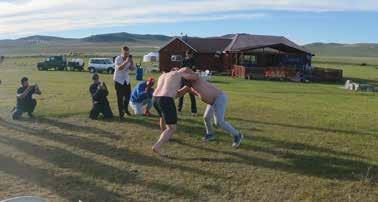
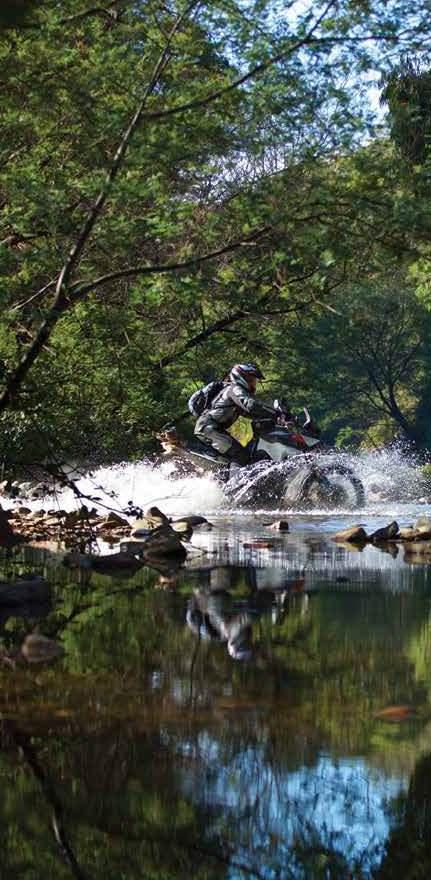

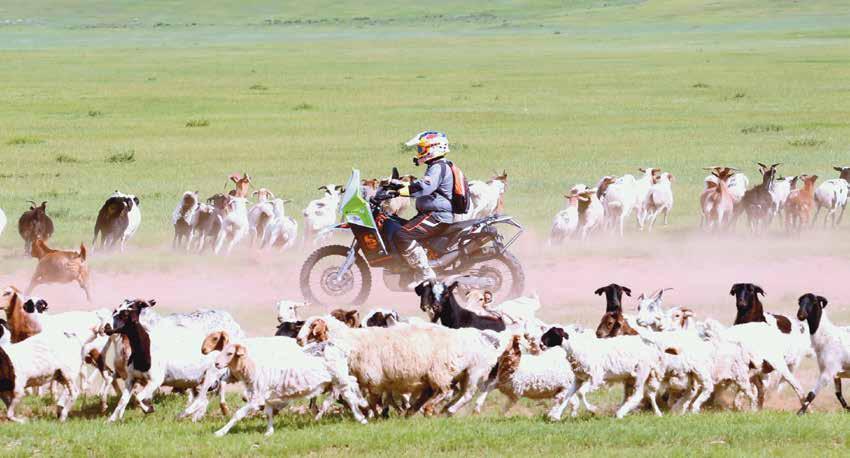
between the borders of China, Russia and Kazakhstan. Everything was going along smoothly until I realised my tethered camera was no longer tethered. It meant either forgetting 2100 photos of the trip and moving on, or backtracking 10km to the likely spot where the last photos were taken. I was elated at finding the red case of the camera glittering in the sunshine and half buried in the coarse sand on the lake’s shore. The backtracking in deep sand meant excess fuel use and an engine expiry, and that resulted a 40-minute delay and late arrival in to the Eagles Nest Hotel.
It also meant a delay in the evening’s first warm beer.
A better name for the hotel would’ve been The Mosquito’s Nest. The suckers waited at the door for feeding time and we were dinner.
The plan for the rest day in Ulgii was to take a short ride to a nearby valley to locate Aisholban, the female star of the The Eagle Hunter, a docco which tells of a young girl who rescued an eagle chick and trained it to hunt. We found her and her nomadic family in the late after-
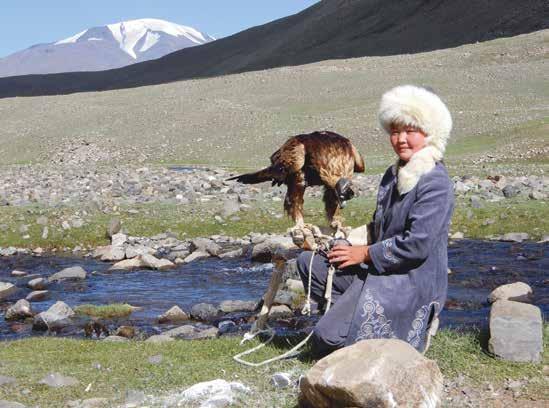
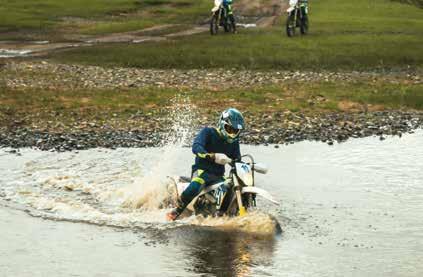
The games are Mongolian wrestling, archery and horse riding, and are held throughout the country during midsummer. From a distant past the Naadam festival gathered the nomadic and local people not just for competition but also to barter, sell goods and gossip. The activity is in and all around the central stadium and is embraced by the whole nation.
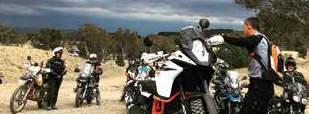
noon, much further up in the valley than we expected, with the help of another nomad. It left us with a tough, 30km ride through bone-jarring rock. Riders slalomed skilfully but recklessly over and around the rocks in a triumph of temperament over common sense.
The unexpected banquets in the valley, first with the directing nomad and second with Aisholban’s family, almost put an end to Bob Moffett’s birthday celebratory dinner, complete with birthday cake, which had been arranged in the ger of a Ulgiiarian native. More than one of us would’ve been content to drink the warm beer at the hotel among swarming mozzies instead. But a team is a team, not a collection of individuals, and off we went to engage in banquet number three for the arvo.
That day marked the end of the ride component of the adventure, but not the end of the tour. A two-hour flight back to the capital had us at the gates of Ulaanbaatar Stadium for the Naadam festival – The Three Games Of Men.
We had experienced the best of Beijing, ridden across Mongolia east to west and attended the second-oldest games in history, The Naadam festival. During the course of our adventure we were welcomed wherever we stopped by the Mongolian people who were helpful, friendly and as warm-hearted as their vast valleys. Land-locked Mongolia is a fascinating country and the motherland of the great Genghis Khan who built the mighty Mongol Empire back in the 13th century. It’s a vast and historical land with thousands of years of ancient culture, and has existed and thrived thanks to its heroic and patriotic ancestors. We had had the pleasure of travelling through the pristine landscape for 10 days, and the nomadic herders still depend on nature for survival, and the wide-open spaces, untouched wilderness, fresh air and water are cherished dearly by the nomadic Mongols.
It can be a challenge to ride, but for those of us who made the effort, it was an adventure of a lifetime.

Outside the main cities the landscapes are still respected by the Mongolians.
Mid Life Adventures offers likeminded ‘explorers’ who are not into racing point-to-point the opportunity to tick items off their own bucket lists. The goal is to provide unique life, culture, gastronomic and ride experiences, and it’s about the journey not the destination.
MLA is not a commercial tour operator, it’s a facilitator supported by offshore affiliates who supply accommodation, machinery, nourishment and support to give unique experiences at an affordable price. See more at midlifeadventures.com.au
core adventure training intermediate adventure training
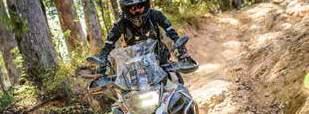
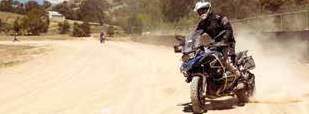
cornering masterclass
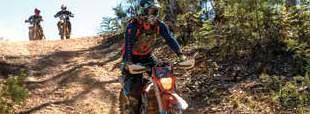
hill attack masterclass sand masterclass
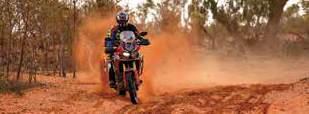
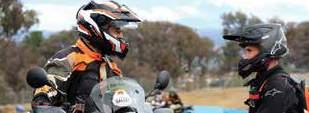
desert preppers academy adventure rider academy
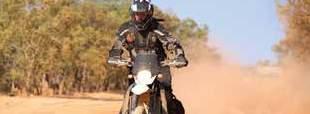
the most comprehensive adventure training curriculum in Australia
for course locations, dates & bookings visit
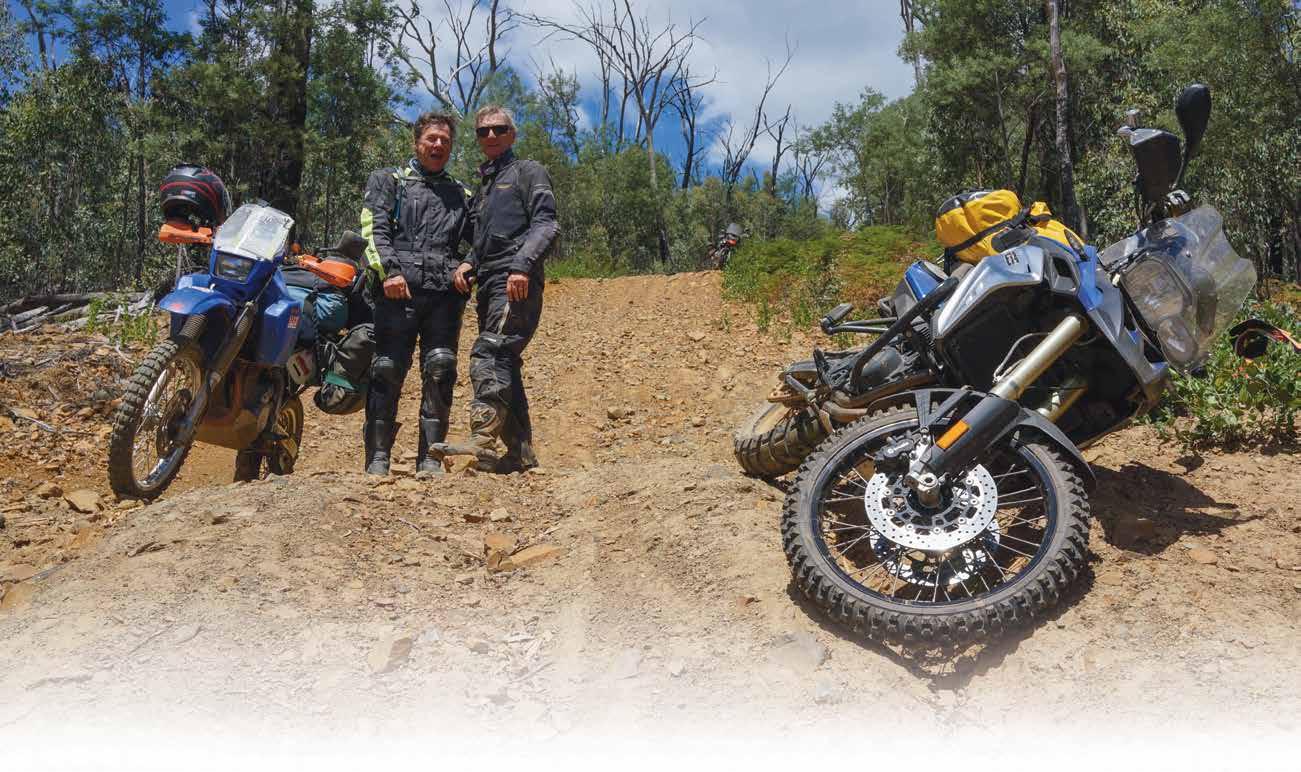
A steep downhill is nothing to laugh about, but Rod Taylor and a couple of mates could still smile after a tough descent.
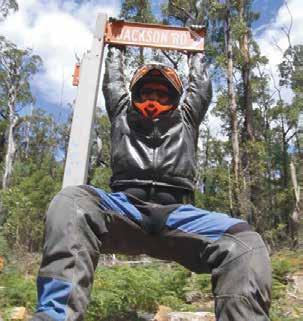
Stopping.
It’s one of the leastappreciated activities on a motorcycle but it’s one of my favourites. The recommended procedure usually ends with one or more feet on the ground holding the bike upright.
It’s a good theory, but by the time I realised I was in trouble it was too late to do much about it. A few minutes earlier we’d been tearing uphill, having a ball. We were getting a bit of air jumping over the erosion mounds which reminded me of my younger days riding enduro. They were fairly modest jumps by comparison, but a heavily laden Triumph Tiger XC800 is not
really designed for that sort of work and the rear suspension was bottoming out, even with the heavy-duty aftermarket spring. When Dave turned left at the top of the hill wasn’t too fussed. It looked like a moderately tricky downhill. What we didn’t know was it was one of those nasty bastards that get progressively steeper the further you go.
My rear tyre was somewhat shaggy and running too much pressure. Normally if you can see a landing area you can let the bike run and pull it up at the bottom, but this hill went forever and I had no idea
where it would end. The faster I went, the more out of control I got. I tried to pull it up on the slightly flatter ground before the erosion ruts, but it wasn’t enough. It became clear I was about to launch the bike into the shrubbery.
Steep hill? Yep. Bumpy with gnarly ruts? Yep. Sharp rocks at the bottom? Bring it on.
There’s nothing so life-affirming or sphincter-loosening as the realisation you’ve just become a passenger. You know you’re going down. You’re going to suck dirt and the only question is, ‘What’s gunna break?’
Dave had managed to pull up his DR650 just ahead, luckily giving me a bit of room. I shot past with wheels occasionally pointing in the same direction. Later he told me he was thinking, ‘Nice. Show-off.’
What he didn’t know was I’d hit Pucker Factor Five and was amazed I was still upright.
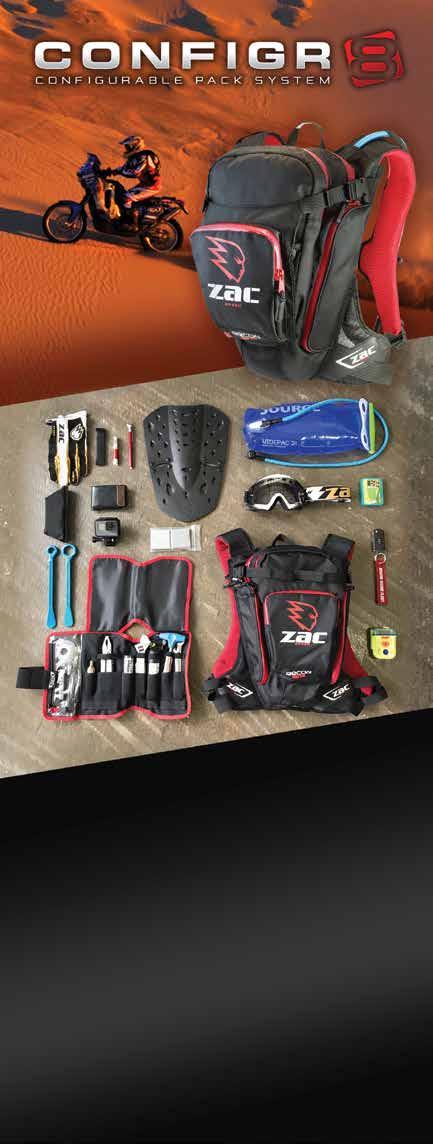
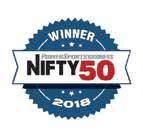
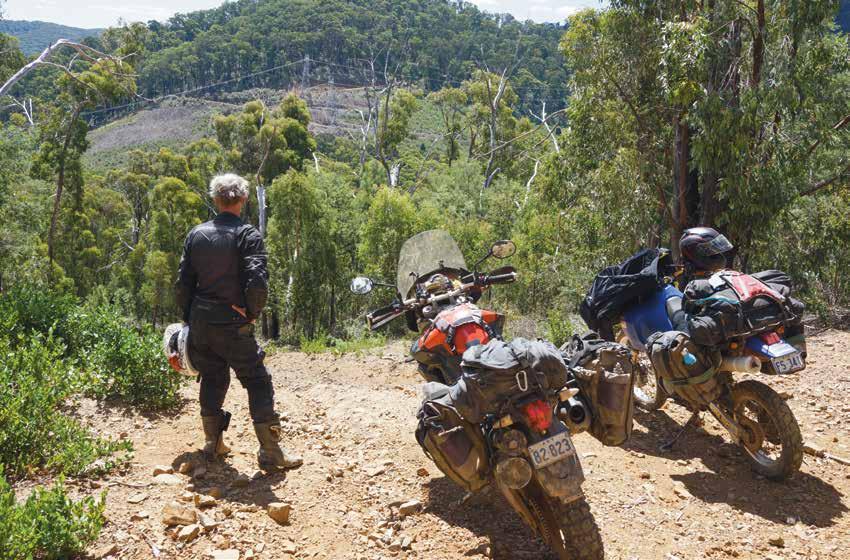
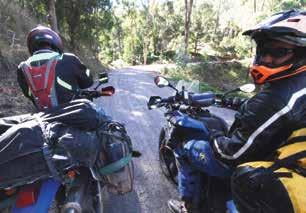
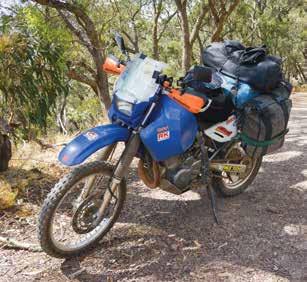
The next erosion rut was it, I’d decided. Graceful or otherwise, I was going to stop. When I did plough into the ground it wasn’t too bad. It was untidy, but nothing was broken and it gave me pause to praise modern protective gear. Then Craig came past, obviously also in trouble, but still upright.
‘Curse you, Jackson,’ I thought. ‘Curse your frilly pink knickers*. You can’t show me up’.
The Tiger waggled its wheels at him as he went past.
He made it to the next erosion rut and nearly managed to pull off the regulation stop procedure. Just over the ridge was a row of axel-deep ruts and he was teetering, almost holding his bike up. I made my next mistake, which was to run down to give him a hand. It was a dumb idea because I could hardly walk down this hill, let alone run. I tumbled and slid another 1.5 kilometres.
Top: Contemplating the inevitable.
Above left: Oh-oh. Dave was having trouble reading his map. He was supposed to be the nav man.
Once I’d untangled my body I scrambled to help him. It may not have been dignified but at least wasn’t on my arse.
“When I did plough into the ground it wasn’t too bad. It was untidy, but nothing was broken. ”
Meanwhile, back up the hill, Dave’s DR had flicked him off the high side.
Anyone who’s ever highsided a bike will know its one of the most violent ways to exit short of hitting something. It catapulted him into the dirt, leaving him with a badly injured knee and twisted shoulder. It wasn’t good, but he could still walk and ride, even though he was in a lot of pain.
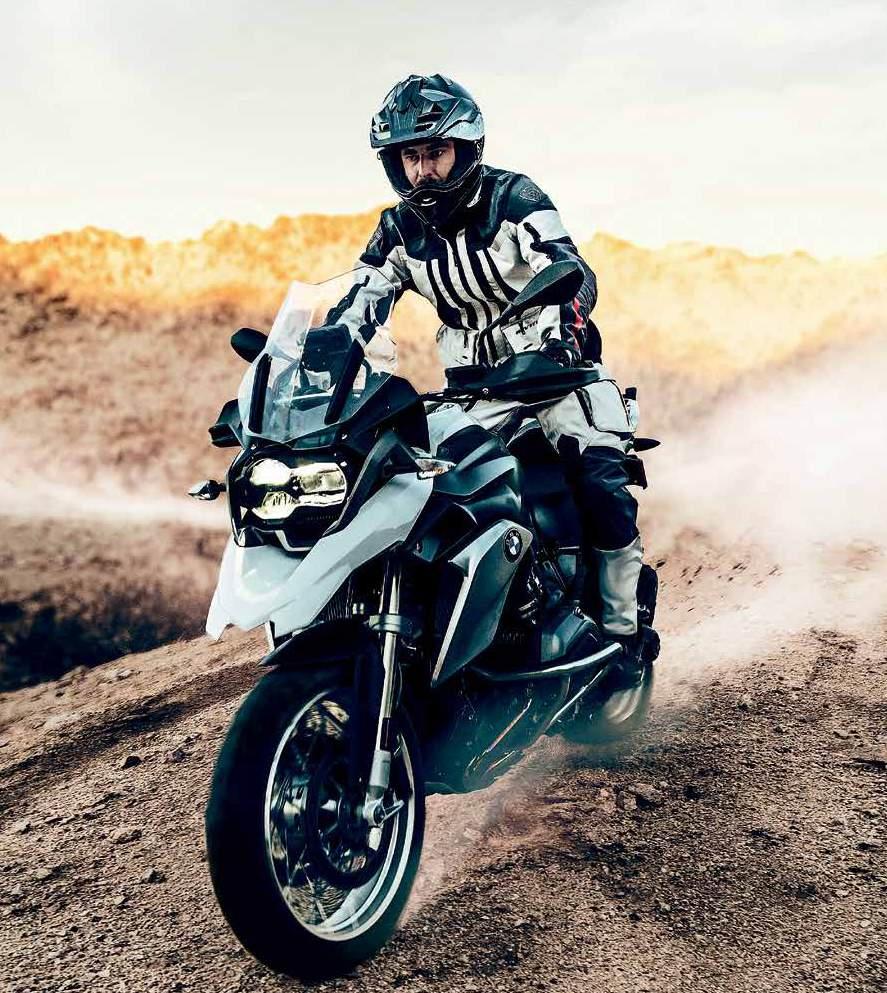
When Dave drops it, you know it’s bad. Mind you, it might’ve helped if he’d been running a proper knobby on the rear.
Left: Dave was famous for the pile of stuff he packed on his DR. u









He’s also famous for the pile of stuff he packs on to the DR. Truck-tyre levers, an inflatable doll (we suspected), a bar fridge with six-packs (we forgave him!) and, handy in this situation, an overhead projector and whiteboard (possibly). With the bikes semi-settled it was time for what the military call a sitrep: a situation report. Luckily no casevac (casualty evacuation) was needed. We held a meeting and did a full SWOT analysis and some strategic planning.
“When we got to the bottom it was like, totally, “Boo-yah! Look at us! ”
Reading the minutes later, I saw we’d slipped into speaking what looked like German, with phrases like, “Well this is a fair bitchovar cahn hill.” Our bikes were strewn over 200 metres and the road descended into…somewhere. We couldn’t tell where, but we were heading into a valley with steep hills on all sides. The worst-case scenario was we’d have to try and ride back up the hill.
Getting down to the bottom of the hill actually wasn’t that bad once we sussed out the method. We’d sit the rider on the bike, legs paddling and engine off. We used the front brake (duh) and feathered
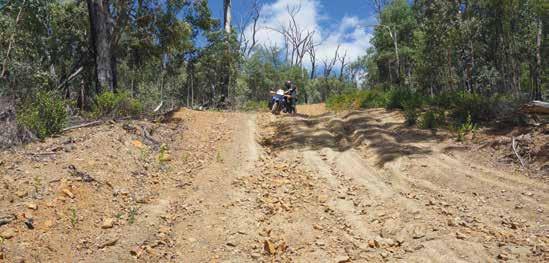
the clutch to slow the rear. Two blokes were boat anchors holding the back and catching the bike if it tipped, and we steered into the gullies to keep us straight. It was so steep and slippery that both wheels were locked most of the time.
It wasn’t stylish but who cared? We did it. And when we got to the bottom it was like, totally, “Boo-yah! Look at us! What a team, backing each other up!”
Teamwork…it’s a great feeling when it works.
Afterwards we reckoned it could’ve been done solo as long as the heavy bike didn’t get off balance.
Dave and I recovered at the bottom while Craig did a quick recce to see if we could get out again. Onya Craig. A couple of hundred metres away was a left turn and an easy ride out.
Dave’s version of the story is bit shorter than this one. His runs something like: “Balls like watermelons! Brains like gnats! Hearts like tigers and bodies like, well, in my case, a rag doll! I’m still gripping
the bars in my sleep! “Farrrrrk!”
Having done it, I’d say the whole thing was a top experience, except Dave had made a hash of his knee and his shoulder was dodgy. That forced him to leave early and miss – you guessed it – another hill. The next one had sand. Deep sand.
There was more fun to follow, but the bummer was missing our other Dave on his DRZ400 because he’d been dropped even before he started. Literally dropped, that was. A stroppy alpaca walloped him in the knee. Too bad it was running hard hooves on the back instead of an underinflated knobby.
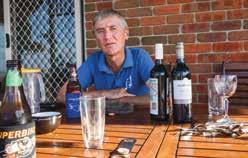
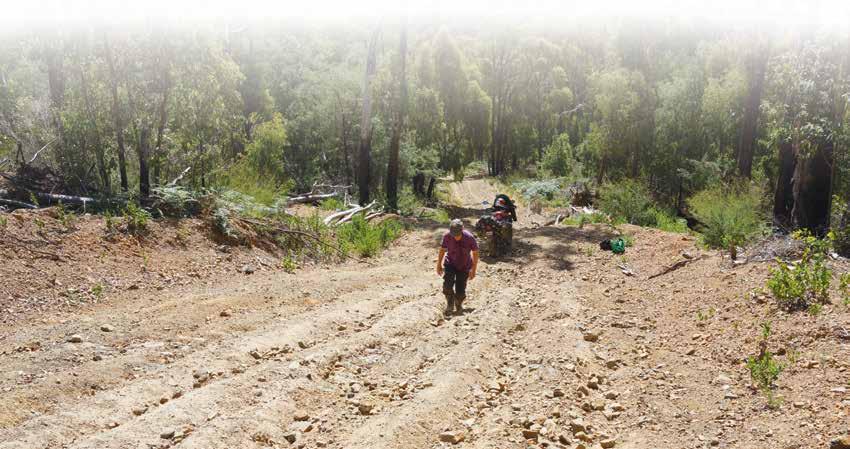
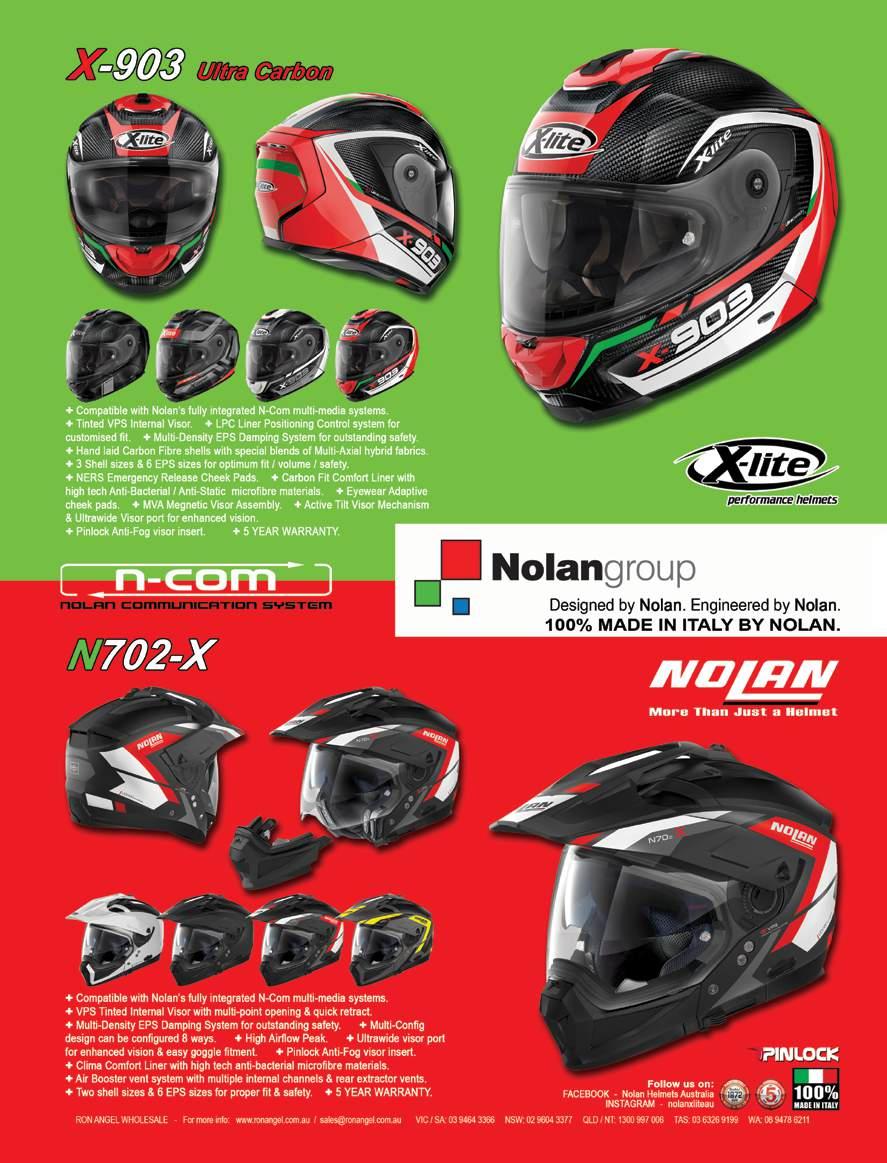
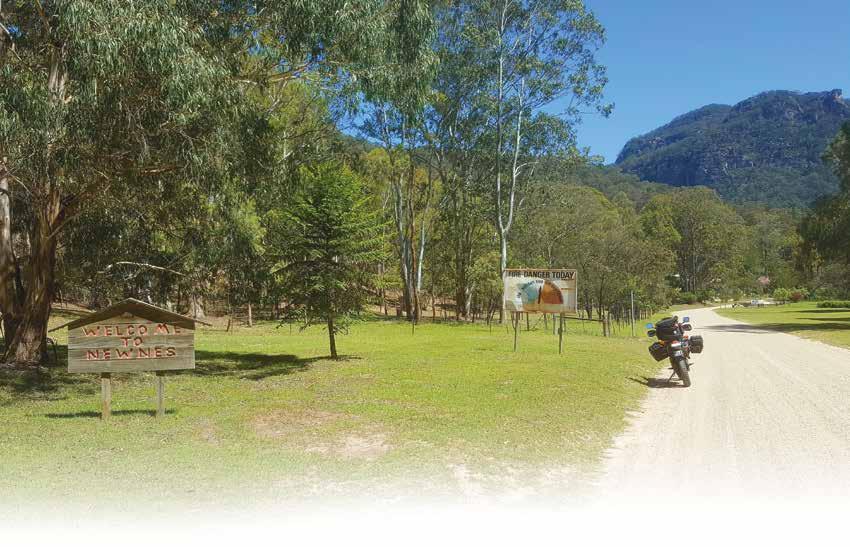
Bob Wozga packed his camera, grabbed his DR650 and headed into NSW’s Blue Mountains to absorb some history from a couple of small towns: Newnes and Portland
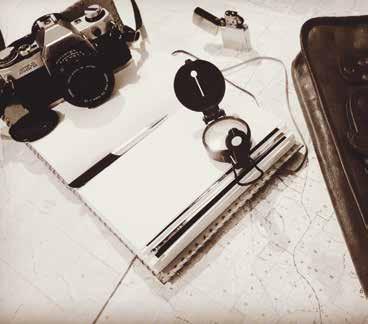
gricultural centres grew on the backs of squatters and selectors. People came to the towns with dreams of making a comfortable living for themselves and their families. Some towns flourished and remain today as thriving settlements along highways and rail lines, while some faded away and are now only remnants of shops or chimney stacks on the side of the roads.
Other centres had their genesis as ‘company’ towns that sprung up around an industry: timber or steel mills, coal, shale, gold and silver mines, or even limestone for cement.
With the prospect of escaping the unemployment and poverty of the cities, people flocked to these company towns. They thrived, creating their own industries for carpenters, plumbers, brick makers, bricklayers and boilermakers, just to name a few. Sometimes the towns became sustainable enough to cope with downturns, and sometimes the towns folded when resources ran out.
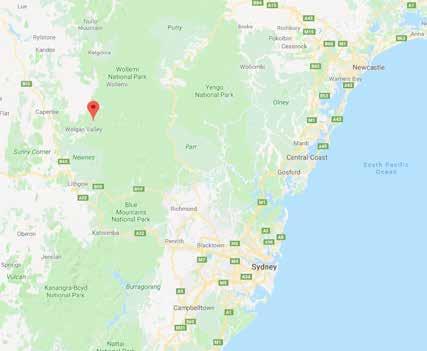
With the discovery of shale in the Wolgan valley, about 100km northwest of Sydney, in the early 1900s, a town was set up by the Commonwealth Oil Corporation and named after its chairman, Sir George Newnes. Construction of the shale works began in 1906 and the results were used for the first time in 1911, producing kerosene and oil. Petroleum was a byproduct and discarded. For its time, Newnes had a reasonable population of 800 and the company invested funds to build a 50km rail line to link Newnes to the main railway line near Bell. It ceased major operations in 1912 and came back to life shortly during the depression. The major works were finally relocated to Glen Davis in 1938. The rail line has long been abandoned and the surviving rail tunnel is now renowned for its glow worms.






Ready for endless miles of riding in
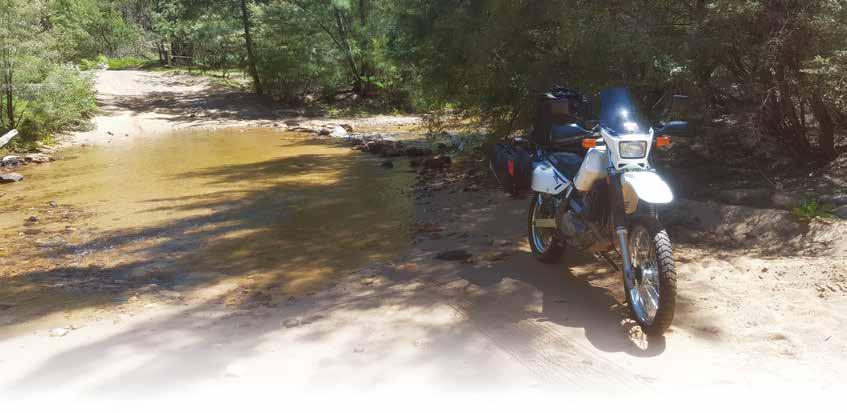
Riding west from Lithgow and taking the Mudgee turnoff leads to Lidsdale.
A petrol station and group of factory units sit on a corner overlooking the now closed Wallerawang Power Station, and a road sign points in the direction of Newnes and the Wollemi National Park, 36km further along Wolgan Road.
Interestingly, Charles Darwin stayed at Wallerawang House in 1836 when he visited and described the countryside and wildlife. The houses are well maintained with an air of optimism, and the town’s clearly not ready to give up. Smokeless chimneystacks rise from the ground under the defunct power station, while gum trees paint shadows on the bitumen in the morning sun and flocks of birds rise from grassy fields as the single-cylinder bike thunders past.
The road is in good condition and will get better in the near future. Works funded jointly by Emirates and the NSW Government will eventually have bitumen from the foot of Wolgan Gap to the low-level causeway near the entrance to the Emirates Spa Resort.
A few kilometres in, just before a bend with a vista overlooking the valley, a barrage of road signs warn of winding road, low-speed advisory limits and falling rocks. It was a bad situation for a person who likes taking photos.
Walled in by sandstone cliffs and hidden from the main highway, it was reminiscent of riding into the nearby Capertee Valley. The road was newly surfaced, narrow in most parts of its three kilometres, and still needed an eye out for fallen rocks, cars coming in the opposite direction and for the idiots who stopped in the middle of the road to take selfies. Mind you, once down the bottom, the desire to race back up,
just to ride down again, was strong.
Only the last nine kilometres is still unsealed. It’s a short run on dirt, but well worth it.
Blue skies, the sound of cicadas and a high-fire-danger sign welcomed me to Newnes. Old rail carriages on the side of the road were a reminder of the past settlement.
There are two good camping grounds with basic facilities and which are spacious enough for people not to camp on top of each other. One campsite is located just past the pub. The second is located over a river crossing that leads to ruins of a factory site and track to the glow-worm tunnel. Clear mountain water in the river crossing makes the depth deceiving and soft sand can catch a rider out.
Remnants of the rail line can be seen through the undergrowth along the track, and hand-laid boulders have been positioned to cater for the rail line, now covered in ferns. A short stroll from the parking bay leads to the factory remains where ghosts walk among the ruins and the wind whispers through the trees.
Littered among fallen branches and dried leaves, rusted boilers and steps leading to nowhere, fragments of buildings now taken over by eucalypt trees and shrubs give an air of a dystopian world. As I walked back to my bike, I turned to the sound of rustling in the undergrowth and a goanna climbed a brick wall. Its tongue flickered and head turned, surveying the site it had inherited.
For all the dreams and labours, and promises made and lost, evolution reared its head and the town slowly died.
Sixty kilometres away, through Wallerawang, is Portland.
Famous for its cement works, Portland was declared a town in 1902, the year the first cement works in Australia opened.
As legend has it, it was the town that ‘built Sydney’. The Commonwealth Portland Cement Company Ltd was registered in 1900 and closed in 1991.
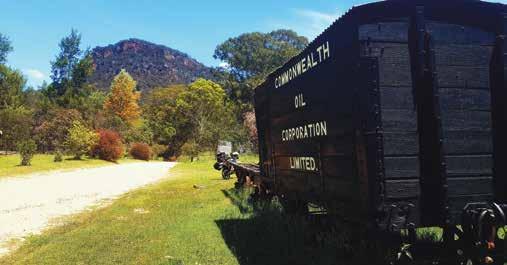
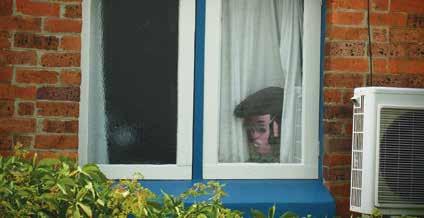
Not letting the closure of the cement works demoralise the town, a Sydney signwriter, Ron Bidwell, and locals had the brilliant idea to spruce up the town and bring in visitors by recreating vintage signs on the walls of buildings: Arnott’s Biscuits and His Masters Voice next to the ANZAC Memorial. Flag Ale on the wall of a pub. Adverts for famous black-andwhite movies on the walls of the Crystal Theatre. More are to be found walking around the town.
All this while Elvis watched the street from someone’s window.
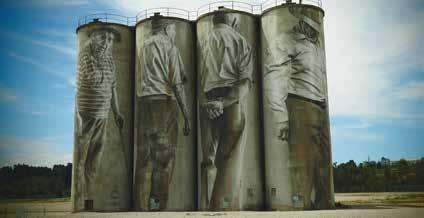
The highlight is the silo paintings by Guido Van Helten at the old cement works.
For someone who can’t draw a stick person properly, these paintings of an old man, covering the height of the silos, is really something to see, and photos don’t do them justice. Sitting on a curbside bench, a local took a rest from his walk into town and watched the cars go by.
Asked about the murals he said, “It has helped the morale of the town. A recent gallery opening brought in 70-odd people, which isn’t bad for a town that few people have heard of. People like living here and don’t want to see the town wither away.”
The main employers are Mt Piper Power Station and local coal mines.
With forethought and an act of defiance to Darwin’s laws of evolution, the town is re-inventing itself to give it its best chance of survival.
Newnes is an intriguing place to visit. You need at least two days to enjoy and explore the surrounds, and the ride in is laid back and well worth the trip, even if it’s just to kick back by the river and take in the serenity.
Places like Portland are all around us. Not all adventures are on dirt roads. There’s still lots to see and learn by traveling through unheard of towns.
Top left: Is he caught in a trap? He can’t get out.
Top
The
in
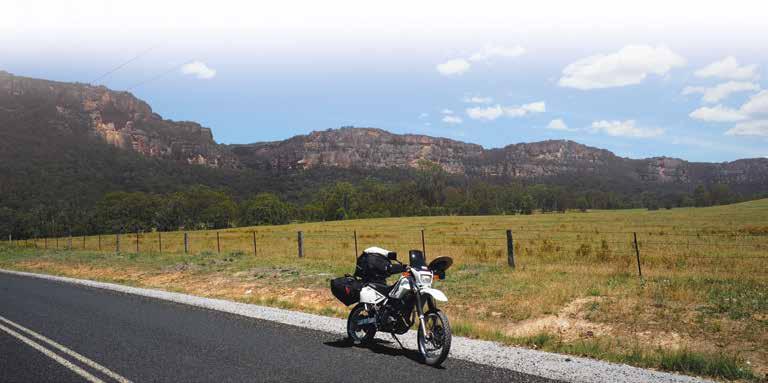





Triumph calls it a ‘modern classic’, and there’s no doubt the styling of the new Scrambler 1200 is pretty damn sexy. We thought it was an inner-city image bike, but Triumph encouraged us to ride and rate the bike as adventure mount. Hmm.
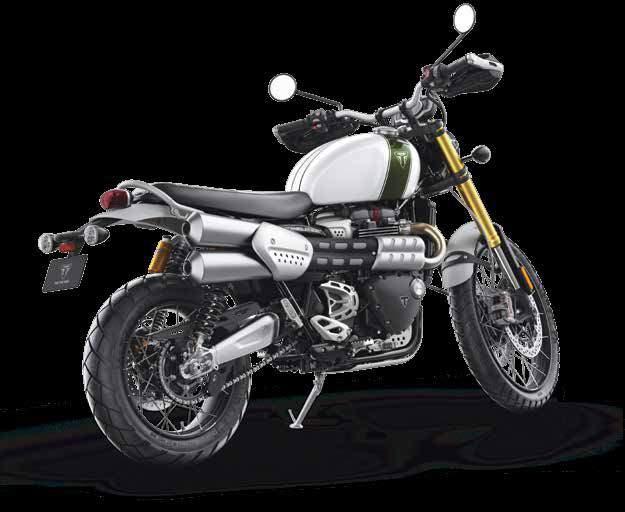
Below: The Scrambler
is a rider’s bike off road. It rewards someone who’s able to grab it by the scruff of the neck and muscle it around.
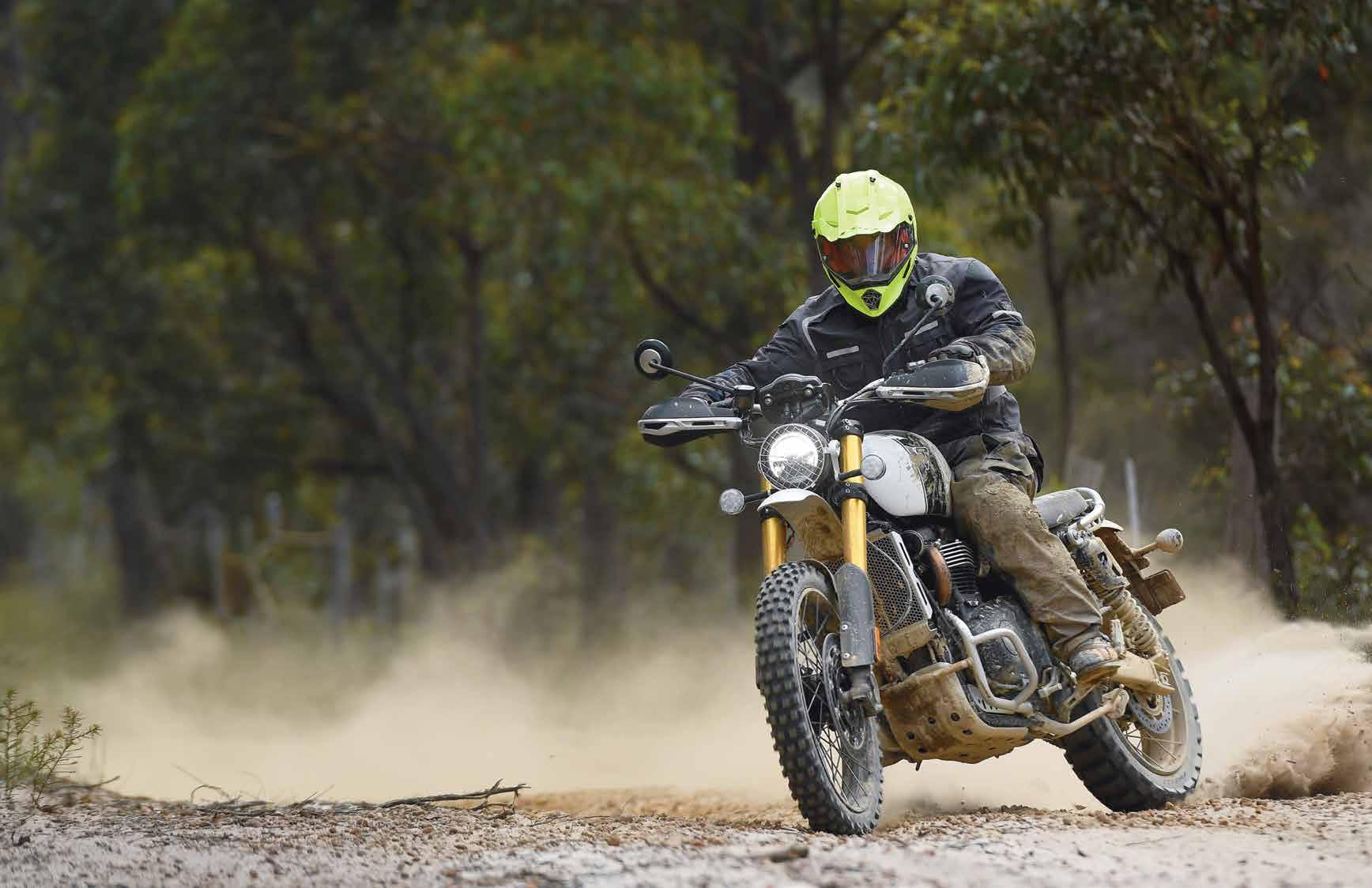
This bike was one of the most interesting we’d ridden in quite a while. The six rider modes, TFT instrument bank combined with a 1960s look would make a wheat-shot-slamming environmentalist’s man-bun wilt with desire. It’s even a twin-shocker. But those two shocks are Öhlins.
‘What should we do with this bike?’ we wondered, sipping a non-alcoholic beverage at Bells Beach Brewing, an entirely appropriate venue to launch a bike like this one.
“Ride the beejeesuss out of it,” said Triumph. “The same as you do with all our bikes.”
We shovelled in another mouthful of pulled-pork, took a long draft of our lemon-lime-and-bitters and thought, “All right! This is looking very promising.”
Top shelf
There’ll be two versions of this bike: the XE and the XC.
The XE is the top-of-line model. Compared to the XC – which wasn’t available in Aus when we rode the XE, but probably is now – it has a slightly higher seat, an extra riding mode, cornering ABS and traction control and heated grips. Both models also offer as an option an integrated GoPro operating system so the camera will run from the on-board controls and TFT screen via a phone app.
We rode the XE, so keep that in mind.
Looks are a big part of what this bike is all about. The best thing we can do there is direct you to have a look at the images. Triumph makes no bones about using the Paul Newman connection with regard to its Scrambler range, and we reckon, in or out of the city, the Scrambler is horn and pretty much defines the classic scrambler look.
You make up your own mind.
Mechanically, the 1200cc, liquid-cooled parallel twin is a punchy outfit.
Power output isn’t astonishing –89hp – but 110Nm of torque delivered at only 3950rpm makes the bike feel as
u
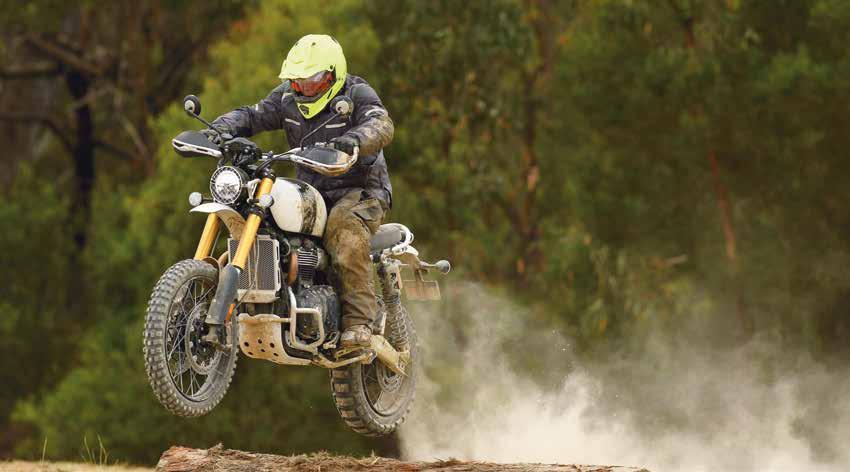
grunty as a sexually frustrated wild boar. It definitely gives the bike character. A six-speed box and assisted clutch transfers that grunt via chain to the rear wheel, and it seemed to us the motor and final drive, as a unit, was a stomper.
Forks are a pair of gold, Showa upside-downers with compression adjustment on one leg and rebound on the other. Of course, the big talking point for the more mature riders was a pair of fully adjustable Öhlins, one on each side of the swingarm, just like ‘the old days’.
Instru-mental
Six rider modes seems like a lot to us. Probably too many. But once we started trying to push the bike a little off road, the modes came into their own.
Just stay calm while we try and say this right: the Scrambler 1200XE isn’t an easy bike to ride fast off road.
On the road the thing is as solid as a brick. It holds a line like a fisherman desperate not to lose his first marlin. All that torque and excellent braking allows pushing the bike hard into bitumen turns and braking very late indeed. In Sport mode, thanks to the cornering ABS and traction control, it also means cracking the throttle open early and not worrying too much about the road surface.
On the asphalt the Scrambler 1200 is a very beautiful thing, even for riders of fairly limited on-road ability, and for a commuter and weekender it’d be brilliant,
Below: A twin-shocker, and Öhlins to boot. We went straight to our happy place. Bottom: Detailing on the Scrambler is really beautiful. Small things like this clamp on the front of the tank add a great deal to the look and feel of the bike, even though it’s only decoration.
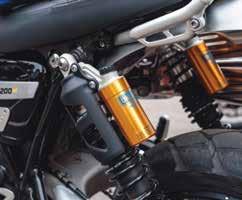
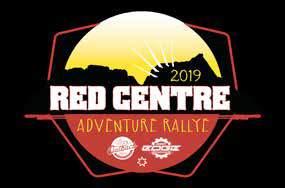
especially thanks to Triumph keeping the seat height comparatively low.
Off-road though, unless the rider has a bit animal about them, the bike will take over and things can get scary.
Throttle response seems very quick and direct. Just thinking about twisting the throttle a little has the rear swishing about all over creation. In the Road modes the bike will almost come to a stop on a loose or rough surface. It’s just too difficult to wind the throttle on without the traction control intervening.
We thought we’d be clever and select Rain mode, which gave a more gentle throttle response, but despite the spectacular TFT screen and fairly straightforward menu, we couldn’t set up the Rider mode – the mode which allows personal settings to be selected and stored – where we had the throttle setting for the Rain mode and traction control off.
So that was a bit of a bummer. It can probably be done, but we couldn’t figure it out in our short time with the bike.
The modes included Enduro and Enduro Pro, and although throttle response was still sharp, we settled in and enjoyed those two modes a lot.
Here’s the bit we’re busting to tell you all about.
The suspension on the Scrambler
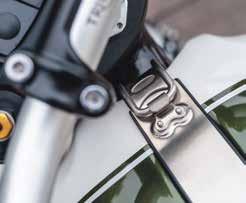
1200 was old-fashioned fantastic. We spent a bit of time setting up the bike because the test area Triumph supplied was quite technical. The bike felt compact for a 1200 and the seat height was low (hooray!), but the Scrambler is still a smidge over 200kg and that motor had some serious poke we wanted to enjoy. The clutch was light and silky smooth, the gearbox was direct and changes felt great, and, best of all, Triumph tech Cliff Stovall was on hand to spin spanners. We cut laps and fell off…a few times, actually. In the water. In the rocks. On log crossings.
By about morning smoko we weren’t looking too good, but we were loving life! We were loving it because every time we rolled the bike up to Cliff and said, “It’s hopping/stuttering/washing out/ whatever,” Cliff would listen to our description, bump a clicker on a fork leg or the shocks one way or the other, and we’d go back out for another lap with the bike clearly feeling different. Not only different, but it reacted to changes in the way we expected. By lunchtime we felt we had the big
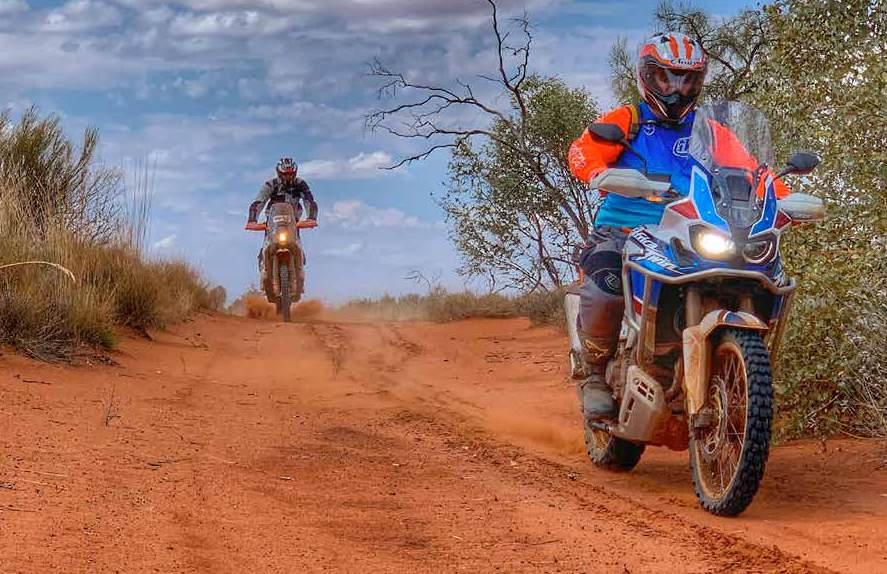
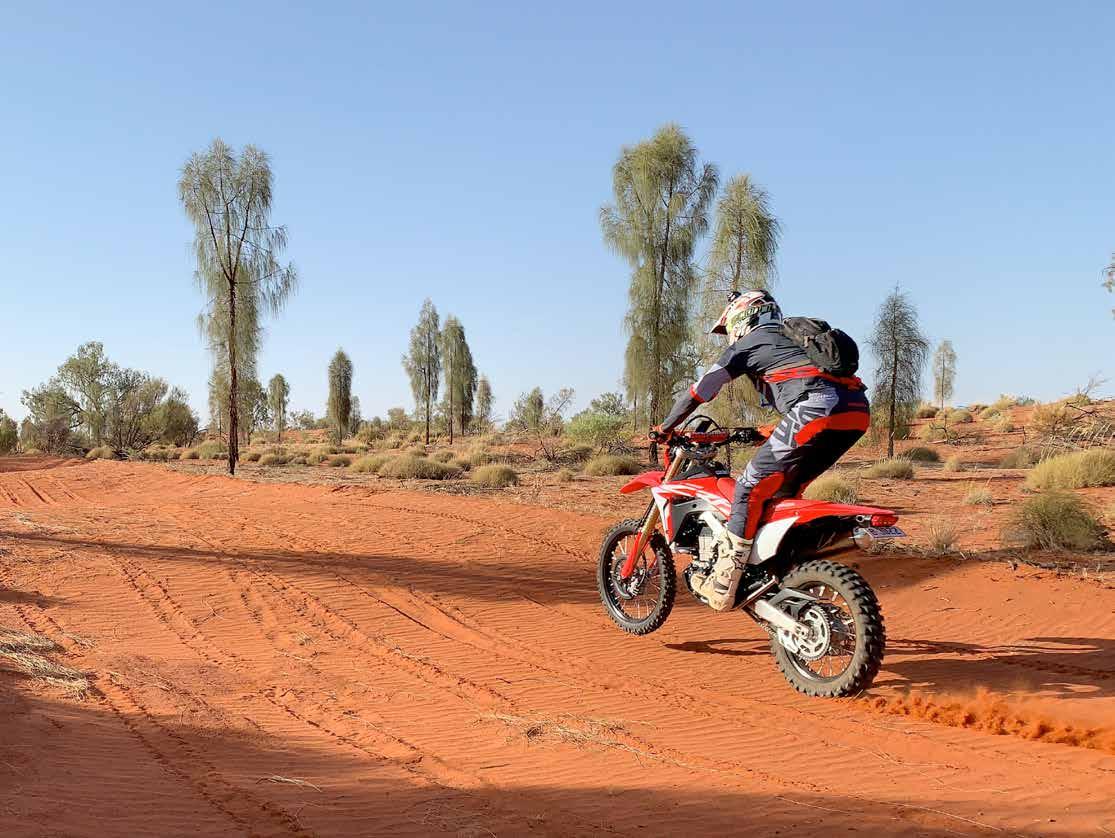
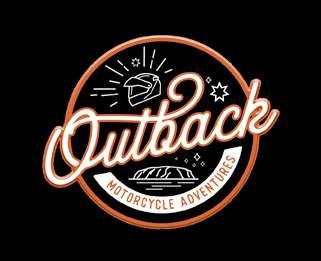

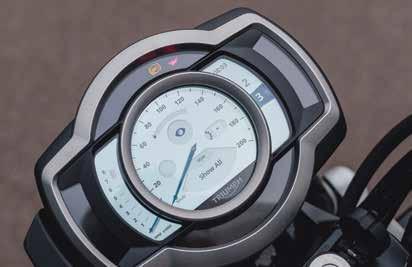
Triumph almost dialed and were having a ball. No funny algorithms or compromises, just honest, good suspension components tuned by someone who knew what they were doing. We don’t recall bottoming out front or rear at any time during the ride, and we can’t remember ever being able to say that about a bike with electronic suspension. It wasn’t just us loving it. The bike responded in the best possible way. Our riding smoothed out considerably, we stopped falling, and by the time we pointed the thing at some deep sand it was like a thoroughbred let loose on a smooth track.
Seriously, the suspension was one of the major high points of the Scrambler 1200 for us.
Is it? Or isn’t it?
So is it an adventure bike? It certainly could be. Triumph offers a couple of ‘Inspiration kits’ for the Scrambler. One’s called the Escape kit and includes panniers, handguards, LED fog lamps, a ‘grab rack’ kit, centrestand and a small screen. The other kit’s called the Extreme kit, and features a
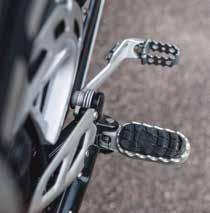
high guard and some protection and so forth.
We’d be very keen to try an Escape-kitted example. While the Scrambler 1200 isn’t as forgiving as, say, Triumph’s 1200 Tiger, the experience is much more raw. The Scrambler is much more a rider’s bike, if you know what we mean. We liked it a lot. We’re not thinking the Scrambler will be all things to all riders, and the long-distance crew in particular will probably find the overall package unsuitable – the seat alone is a problem long-distance. It’s quite thin and hard, and the windblast gets fatiguing fast.
But mechanically there’s not much this bike won’t do, and for riders who like being able to handle a bike with some muscle – as opposed to having a heap of muscle tightly controlled by electronics – the Scrambler 1200XE is a grunty thrill of a motorcycle.
And we can see the pleasure in that experience in a big, big way.
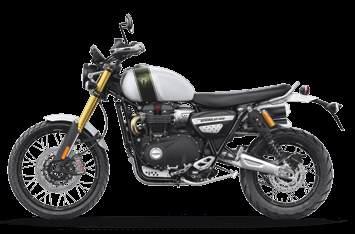
Web: www.triumphmotorcycles.com.au.
Engine type: Liquid-cooled, eight-valve, SOHC, 270-degree crank angle,
parallel twin
Capacity: 1200cc
Bore x Stroke: 97.6mm x 80mm
Compression ratio: 11.0:1
Maximum power: 90PS (89hp) at 7400rpm
Maximum torque: 110Nm at 3950rpm
Fuel system: Multipoint sequential electronic fuel injection
Exhaust: Brushed two-into-two system with brushed high-level silencers
Final drive: X-ring chain
Clutch: Wet, multi-plate assist
Gearbox: Six-speed
Frame: Tubular steel with aluminium cradles
Swingarm: Twin-sided, aluminium, 579mm long
Front wheel: Tubeless 36-spoke 21-inch x 2.15-inch aluminium rim
Rear wheel: Tubeless 32-spoke 17-inch x 4.25-inch aluminium
Tyres front/rear: 90/90 21, 150/70 R17
Front suspension: Showa Ø47mm fully adjustable USD forks. 250mm
wheel travel
Rear suspension: Öhlins fully adjustable piggy-back RSUs with twin springs. 250mm travel
Brake front: Twin 320mm discs, Brembo M50 monoblock calipers, radial master cylinder. Switchable cornering ABS
Brake rear: Single 255mm disc, Brembo two-piston floating caliper.
Switchable cornering ABS
Length: 2325mm
Width (handlebars): 905mm
Height without mirrors: 1250mm
Wheelbase: 1570mm
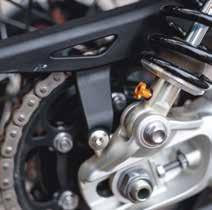
Seat Height: 870mm
Fuel tank capacity: 16 litres
Dry weight: 207kg
Top: Believe it or not, that’s a TFT screen. The ‘theme’ can be changed, and there’s a big swag information beautifully arranged to suit the modern function and keep the classic look.
Far left: Rubber inserts in the footpegs can be removed without tools.
Just grab one end and ease those suckers out.
Left: Clickers! Hallejuah!




After an auto accident in 2017, Ian Goldsworthy feels he may be not so much lucky as blessed. His first ride after the accident was a celebration.
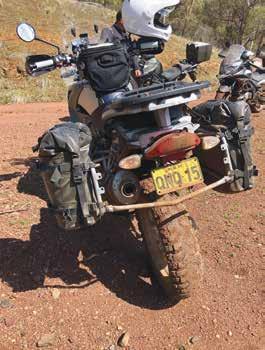
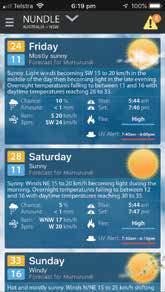
My neck was fractured at the C7 vertebrae with some damage to the C6 as well.
It’s funny how something that happens in a microsecond makes you assess what’s good and what’s superfluous. Laying in the ambulance in a neck brace I knew:
8 God was not yet finished with me here on Earth
8 My wife and children are the best things that had ever happened to me
8 Work is a means to an end, and
8 Motorcycling is a way of life. I wasn’t going to allow my injuries to dictate to me.
It took a little over five months to be able to pull my helmet on and gingerly go for my first ride after endless painful physio.
The call went out to the usual suspects, from which I got five bites: Ryan (‘Barno’) on his red V-strom 650, Craig (‘Finn’) on his fire-breathing 1190, Mal and Garry on 650 V-stroms, and Scott (‘Scotty’), on his 1200 Tiger. Me and my trusty old BMW R1200GS made six – all capable riders and willing to take the Friday off work.
The plan was to ride to Nundle and stay at one of our favourite country pubs, The Peel Inn. The route was to take in some of the area’s best gravel roads as well as some curvy tar roads.
“Just how much dirt is involved on this ride, Ian?” I was asked.
The enquiry came from Garry.
I had to measure my response as I didn’t want to unduly alarm him and I knew he’d be able to smell crap if it was dished up.
“There’s a little bit of dirt, mate,” I offered, “but no single-trail enduro stuff. These are roads I’d happily drive a sedan on.”
What I didn’t say was it would have to be someone else’s sedan for me to do that. u
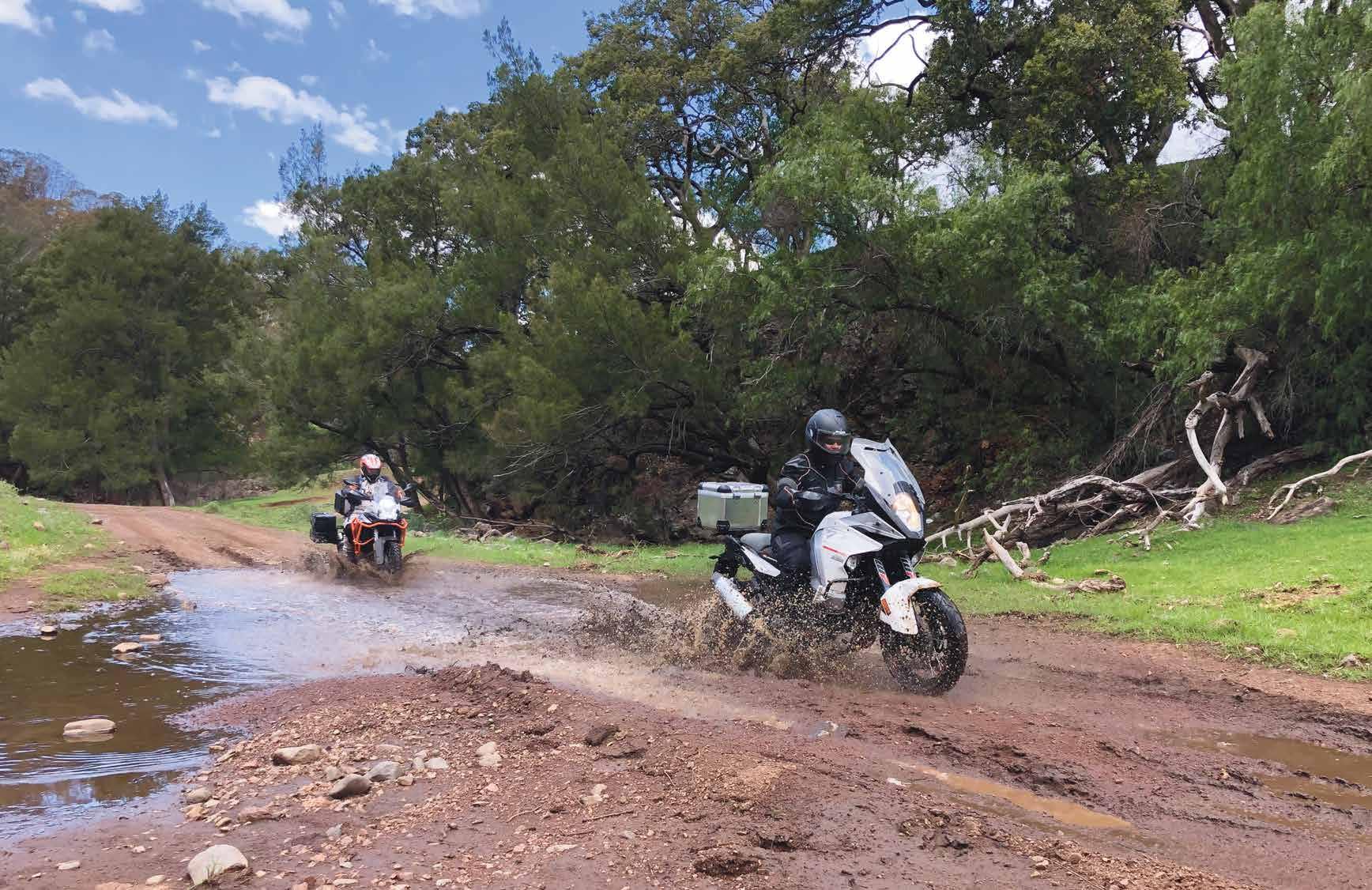
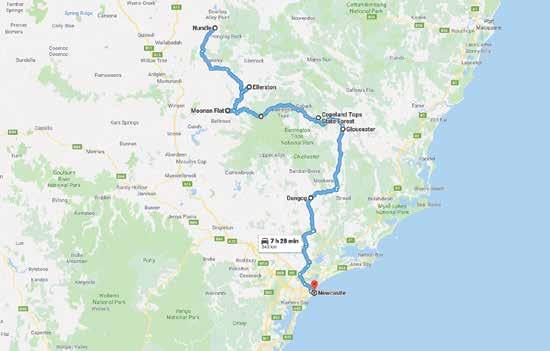
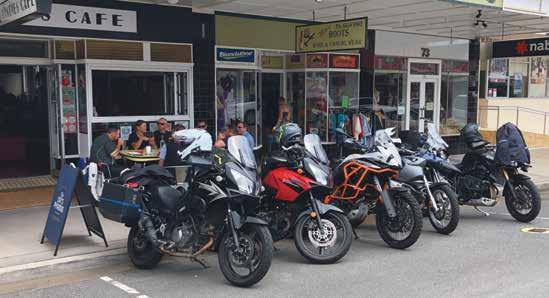
So it was set. We met for a 7:30am getaway and the weather forecast, after a couple of torrential rain days, was looking pretty well-planned, too.
Leading up to the ride Scotty informed me some good friends of his were super keen to come along. They lived in Gloucester and would join us there. So married couple Trent and his 1290 and Kelly on a 650GS were also part of the adventure. The group had grown to eight. admit to significant nerves and worries at being on the gravel again for the first time in over 18 months. Despite being packed and ready five days early, I discovered at the pub on the first night I hadn’t packed any spare pants. I had only my riding gear. I owe thanks to Finny for the loan of his spare boardies.
As the day approached I felt slightly better at the thought that if I did bin it, at least the neck brace I’d been wearing since the accident would help prevent my head rolling off my shoulders.
We left on time, and after a trip across Newcastle in rush-hour traffic we were finally at Heatherbrae and Scotty hared off in front. Unfortunately for Scotty was taking the group via Dungog, and on a more swervy, scenic route to Gloucester. A quick phone call on the headsets had it sorted and Scotty agreed to meet us at ‘Roadies’, one of our favourite coffee shops, at Gloucester.
The group was moving well, and by the
time we hit Dungog to regroup I thought this had probably been the easiest start to any of the trips I’d organised. Then Barno stepped off the mighty V-strom and complained of some power issues. I thought it seemed something electrical was breaking down under load. Barno reckoned it was a fuel problem. We pushed on to Gloucester to maybe check in with one of the mechanical shops there.
“ I still had concerns it was an electrical problem, although the presence of rust-like ‘stuff’ around the filler neck under the cap made fuel the more likely culprit.”
We’d made Scotty wait for an hour, sipping latte’s at Roadies, by the time we’d been to the local Auto Pro for some fuel-system cleaner to put into Barno’s tank. I still had concerns it was an electrical problem, although the presence of rust-like ‘stuff’ around the filler neck under the cap made fuel the more likely culprit. With tanks full, including Barno’s octane booster/cleaner, we headed to Roadies to get coffeed up, find Scotty, and to meet Trent and Kelly.
Moving out of Gloucester I had in mind to try and get some photos, and with some judicious use of the right wrist I was at the front of the queue for the climb over Copeland Tops.
After a couple of pics a quick squirt had me caught up and we started climbing toward Barrington Tops, finding the road tarred even further than our last time through. The first dirt wasn’t until the flat area after the climb.
We settled into our comfortable gravel-road speeds and by the time I caught Scotty and Trent we were almost at Polblue. I didn’t spend too much time behind Scotty’s Tiger. Even with his smoothish rear tyre I was having to dodge a shrapnel barrage and I scooted past both he and Trent at the first opportunity.
Something I almost always forget to do when I hit the gravel is to pull up, turn the bike off and restart it with the ABS switched off. This was very quickly jammed back into my memory when I speared straight through the last corner before Polblue and into a grass-filled table drain. Thank goodness there were no big boulders or logs in there, and with the heartrate higher than it should’ve been – and part of the seat jammed where it shouldn’t have been, either –we pulled up at the Polblue carpark to wait for everyone.
At a slightly more sedate cruising speed, this time with the ABS off, we arrived at Dingo Gate where we lined up the bikes
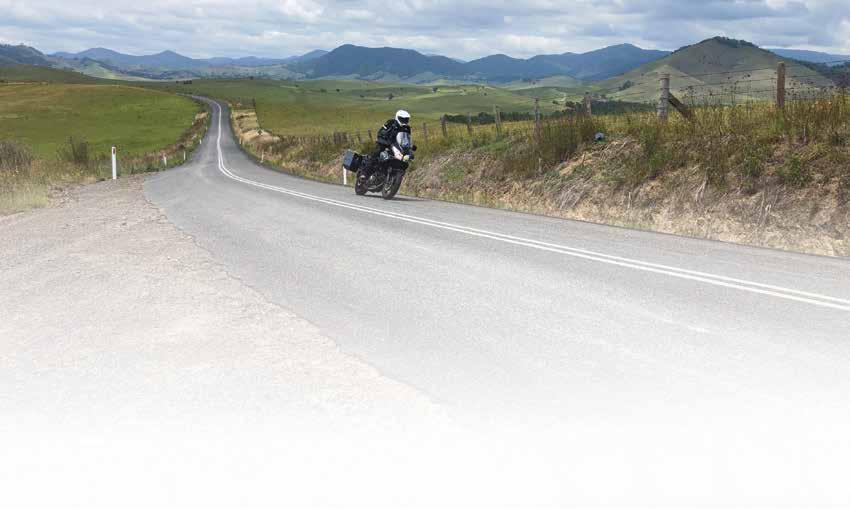
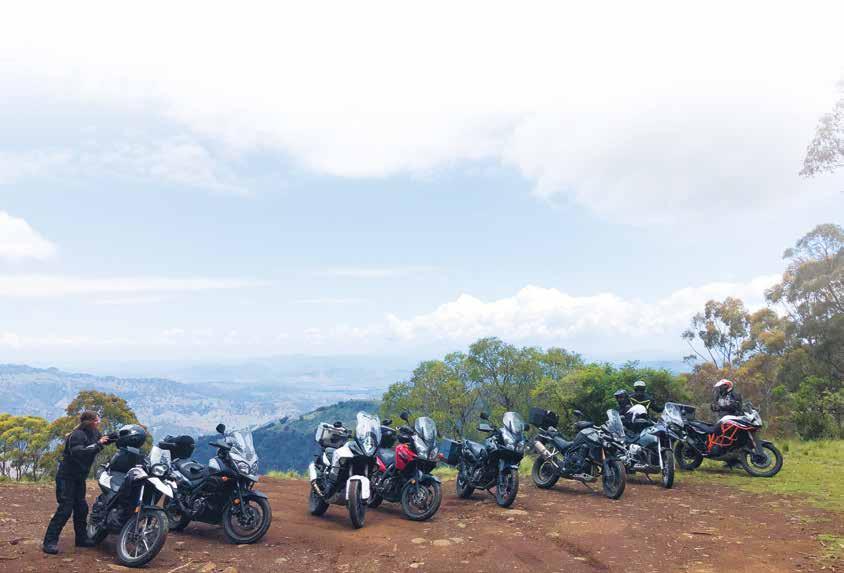
for a posed photo.
The scenery was stunning, and even more so on the descent from the gate. It was a little on the chilly side up there, but I knew it was going to warm up as we descended to The Imperial Hotel at Moonan Flat for lunch.
Everyone was buzzing and happy to tuck into some good food. Trent, Kelly and Garry had quickly become acquainted and comfortable with the other characters.
Next was part of the ride I hadn’t done recently and I was most worried about.
Even though NSW was still technically in drought, the gravel road from Ellerston to Nundle via Barry Station has over 20 creek crossings that can be very tricky when there’s water flowing, especially on big adventure bikes. There had been a torrential downpour in the days leading up to the ride, so I had some concerns.
Slippin’
Pretty soon we were climbing again, past Glenrock and heading towards Hanging Rock. We topped out through the forests after hitting the first slightly skatey part of the whole trip. Barno binned his ’Strom at fairly slow speed, but the good news was it’d been running better. What we didn’t know at the time was
the loose surface was a taste of what was to come.
I’d switched off the bike to wait for the group and I frantically thumbed the starter hared off as they approached. That meant I’d ridden off with the ABS on again, and the first section was a downhill. It very quickly became apparent that, ABS or no ABS, gravity was boss on the descent. What appeared to be a solid surface was in fact the slipperiest and stickiest red gloop I’d seen for ages. Imagine sitting on the back of a cranky cow while trying to slow down on an ice rink. That’s what it was like.
It was at about this time the intercoms suddenly started working and I heard lots of giggling in my helmet.
“What’s going on, Mal?” I asked. “Are you alright?”
“Whoa! Garry’s down (more giggling)!”
“Mal, is he alright?”
“Hahahahaha! Yeah, he is. But I’ve binned it too (more giggling)!”
By the time Barno and I had parked up at the first flat spot, I had just enough time to look up the hill as Garry executed a perfect front flip over the sidewayssliding V-strom, his second stack on the greasy hill. Bwahahahahaha!
Thank goodness it was happening at slowish speed and injuries were to pride
only. We all now had strange-looking, brown, slick tyres, even Finny’s more aggressive knobbies.
The rest of the troupe stayed vertical and we regrouped for some laughs, mostly at the expense of the three Suzuki riders. They were the only ones who tossed it away for the whole trip.
The remainder of the hill had dried out and the rest of the gravel road was good. I’d remembered to switch the ABS off and had raced away on the Beemer when suddenly I heard that strange thunderclap again. A quick check between corners showed Trent’s wide-load 1290 sniffing at my Akrapovic. I had no chance of shaking him and was fully expecting him to go racing past in a shower of gravel, but, ever the gentleman, he was happy to follow at my pace. The thunderous roar from his KTM was intoxicating, and Trent commented, “Loud pipes save lives.” They’re really nice to listen to as well. We headed into Nundle where the air was warmer and the expectation of the first ale at the Peel Inn weighed heavily on all of us. Finny and I left our bikes in the fresh air, thinking maybe it would rain overnight and we’d get a free wash.
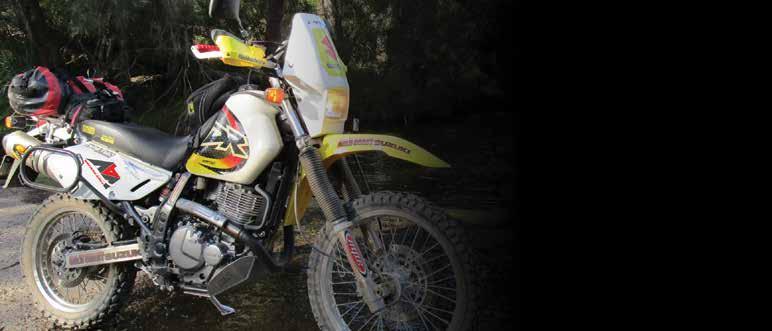
Before dinner a few of us sat up on the verandah outside the rooms and enjoyed the cool arvo breeze. Garry started flashing his leg around showing a little damage from the earlier stacks and I was sorry I’d laughed. Only a little bit sorry.
Rash about gravel
Determined not to be the last one ready in the morning I packed and dressed before another beautiful, Peel Inn breakfast.
By 9.00am we were all on our bikes and ready to go when Scotty commented he may need to stop somewhere to jettison the huge breakfast. Barno piped up, “If you need to go, you should just back it out into my tank. There’s plenty of s#%t in there already.”
Somebody even suggested using my neckbrace as a toilet seat. I didn’t think that was funny at all.
A sedate ride out of Nundle warmed the tyres before hitting one of my favourite roads, the Forest Way shortcut to Thunderbolts Way. I’d been known to maybe go a bit over the speed limit on this section. That’s if there is one through there?
It can definitely be a little squirmy and slippery, and it was on that day. We lined up for another posed photo and I mistakenly informed everyone there was no more gravel until Bulahdelah.
Poor old Finny picked setting number 125, or was it menu four, setting 412?
I can’t remember. In any case his KTM was in full Sport mode and running 150hp and full ABS with minimal traction control on the three kilometres of slippery, deep gravel until we got to the tarmac proper. That might’ve been partly my fault, saying there was no more gravel, and apparently a few years was lost from his overall life expectancy in that short section of road.
“ What appeared to be a solid surface was in fact the slipperiest and stickiest red gloop I’d seen for ages.”
Thunderbolts Way is a mix of scenic, winding countryside which includes smooth, straight sections of tar mixed with swooping bends that beg to be ridden aggressively. Soon enough we passed Nowendoc and eventually pulled up at Carson’s Lookout for a regroup. We set off again, and by the time I’d latched on to the back of Garry’s rear wheel all the chicken strips were well and truly gone on all our tyres. There were huge grins and hoots at the Barrington River bridge while we let the motors tick down and wait for Kelly and Finny. We convoyed into Gloucester and visited Roadies again for coffees before bidding farewell to Trent and Kelly.
To keep the momentum going I shuffled the boys back onto the bikes and headed for a new section of road I hadn’t ridden before.
Roughly parallel to the well-used, and sometimes well-patrolled, Bucketts Way from Gloucester to the highway is a road through Wauk Ivory and Markwell which leads to the north side of Bulahdelah.
The top section is all tar and it’s glorious. The group was down to six and I pulled the boys up just after we hit gravel again. I wanted some GoPro footage of us on the dirt and everyone headed off with me at the back. That was the moment I decided never to do that again. feel truly blessed now that these guys I ride with continually put up with my dust and shenanigans when I’m leading them on dirt roads. I was actually choking on their dust as I rounded them up and it took me another 40km of clear air to hack up the last of the dirt from my lungs. Pottering into Bulahdelah we did a quick poll to find no-one was hungry, so after a fuel up we roosted off toward Bombah Point to catch the ferry over to Mungo Brush. I didn’t realise this particular ferry had a fee, unlike the Wisemans Ferry ferry were used to. By that stage though, we were getting a wonderful cool
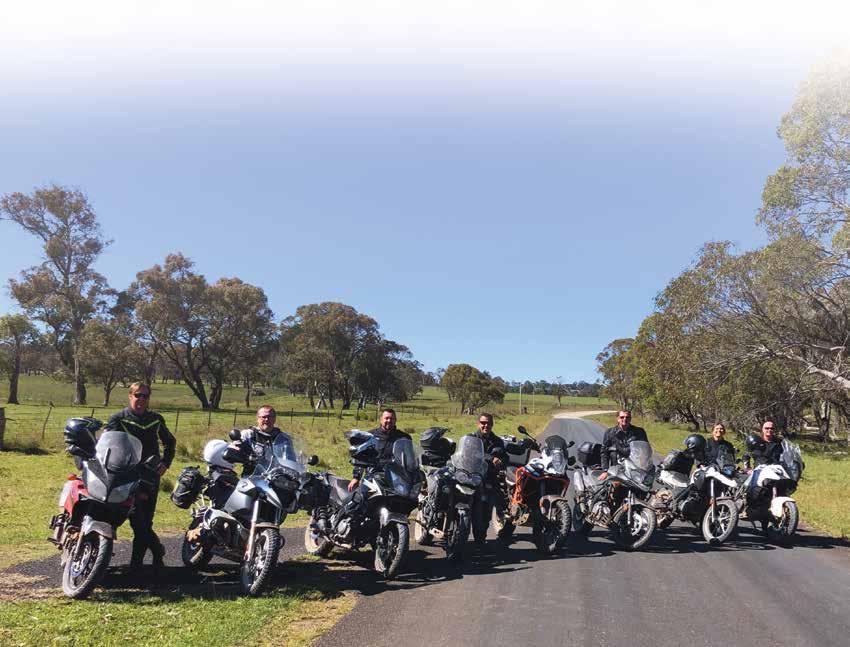
Bottom left: From left: Barno (Ryan), author Ian, Mal, Scotty, Finny’s (Craig’s) KTM – he’s missing because he was the photographer – Garry, Kelly and, last but not least, Trent.
Top right: Poor Garry. That’s what a bike looks like after two trips down the track on its side.
Bottom right: Garry sporting a nice bit of damage.
breeze off the Myall Lakes. It was hugely welcome at just past 1.00pm with the sun stinging hot.
After a short, mind-numbing transport from Mungo Brush down to Tea Gardens we pulled up for what would be our last time at one of the pubs on the river linking Myall Lakes and Port Stephens. After one final brown lemonade and a fish-and-chips snack we formally bid farewell, even though we convoyed on and off together until home.
A good result
It was another awesome adventure and left us with many memories to share. Dirt roads made up about 40 per cent of the trip, and all up, according to the somewhat pessimistic odometer
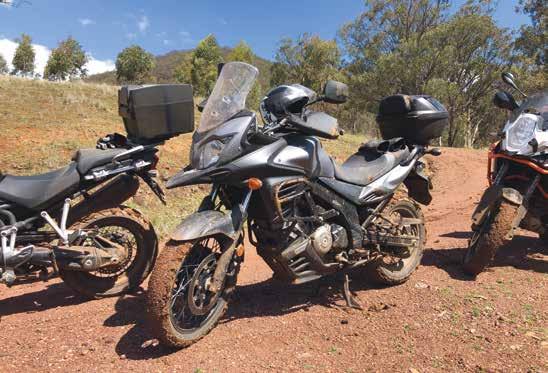
on the Beemer, we covered 694kms over the two days. Though we had four small, low-speed get offs, the only casualties were Garry’s left shin and right boot, which copped a dint that won’t come out.
I’m already thinking about the next weekend ride. It’ll be most likely after summer when it gets a bit cooler, and somewhere down around the Southern Highlands area maybe.
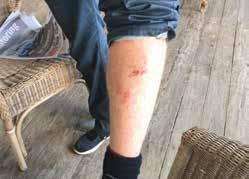
Newcastle riders Damien and Yvonne Harvey recently rode South America’s famous Ruta 40. Starting at sea level, RN40 crosses some 20 national parks, 18 rivers and 27 stunning passes in the longest continental mountain range in the world. Graeme Sedgwick gets very excited at the thought of a ride like that and sat with Damien to get some details.
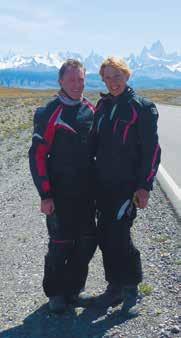
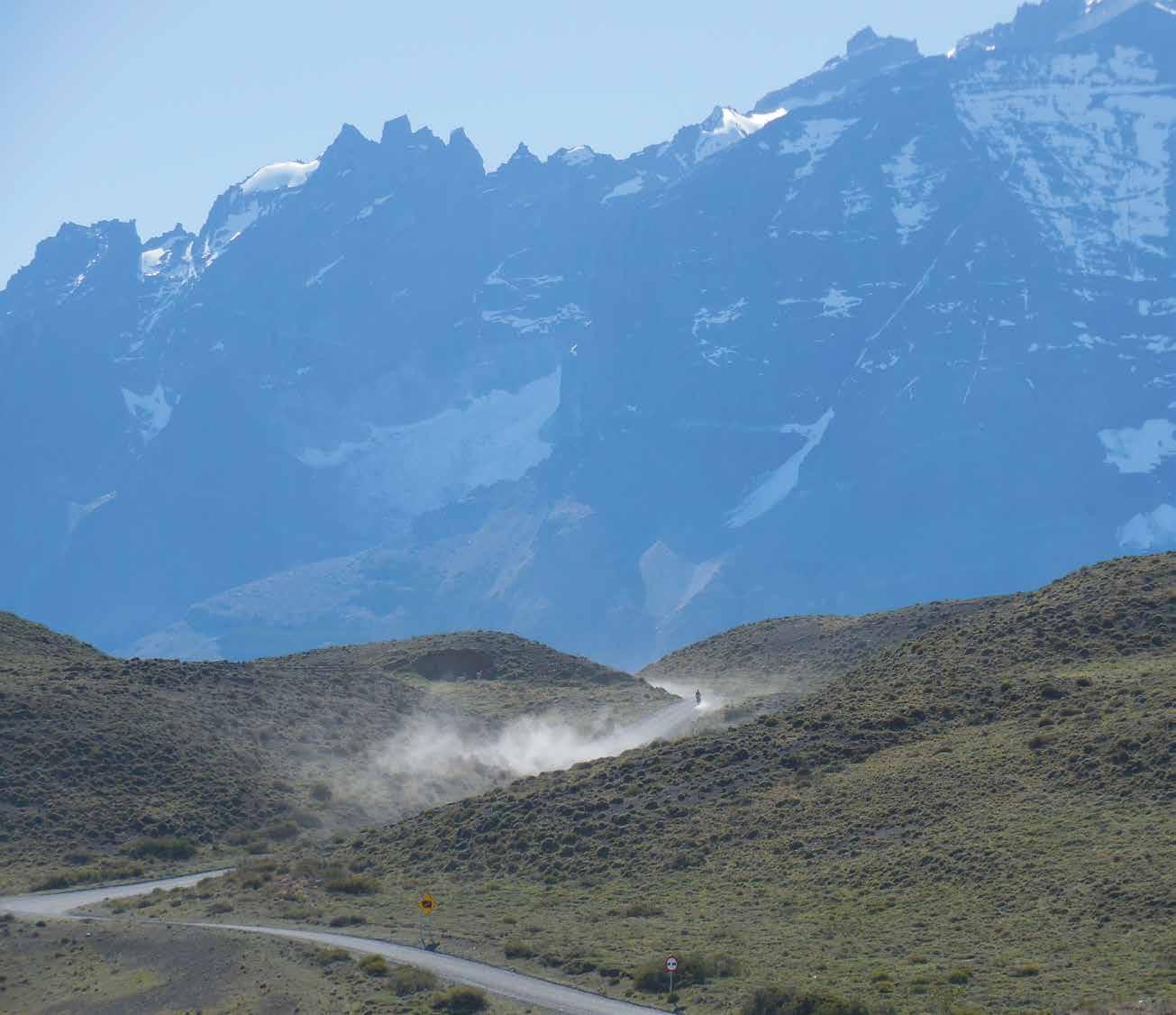
Main: The trickiest part of the adventure was in the Torres Del Paine National Park, about two-thirds of the way through the ride.
Insert above: Newcastle adventure-riders Damien and Yvonne Harvey.
Top right: Ruta 40 was originally a trade route from Bolivia through Argentina and Chile all the way down to Ushuaia at the very bottom of South America.
Right: Perito Moreno Glacier was a stunning and powerful statement of Mother Earth’s power.

GS: Tell us about the adventure.
DH: Okay!
The Ruta 40 has been an iconic route for motorcylists for over 20 years.
Originally it was a trade and access route from Bolivia through Argentina and Chile all the way down to Ushuaia at the very bottom of South America. Riding it was a dream I’d had for many years, having read of motorcyclists travelling its passage.
For those looking for an adventure with scale, Ruta 40 must be high on the list. Things are changing rapidly. Driven by the incorporation of other highways into the RN40, along with tarsealing kilometre by kilometre, it’s slowly diminishing the original adventure forever.
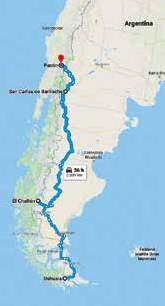
Above: Starting at sea level, RN40 crosses some 20 national parks, 18 rivers and 27 stunning passes in the longest continental mountain range in the world.
GS: How did you approach realising the dream?
DH: While it would be adventurous to embark upon such a ride unguided, we were mindful parts of the route were very remote. Some sections were unpredictable, and it could be very rough and harsh on equipment. After a great deal of research we opted for an operator-led adventuring of the Ruta, principally to reduce risk and downtime in the event of breakdown, and uncertainties in accommodation, food, health and currency.
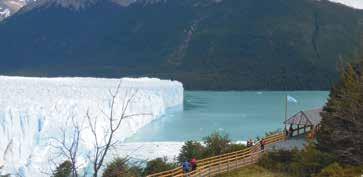



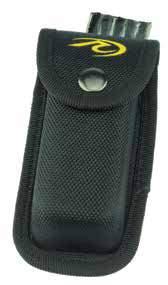

Pliers, rasp, needle insertion tool, knife and 5 pre-glued plugs, all in a handy pouch.
1 Remove offending item from your tyre.
2 Use the rasp to clean out the hole.
3 Thread needle with plug, push into the hole and pull out.
4 Separate the knife from tool and cut the plug flush with the tyre.
The knife slides off the tool to easily cut the plug.
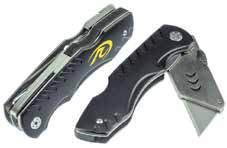
For further information on this and all our products, please check our website for details.
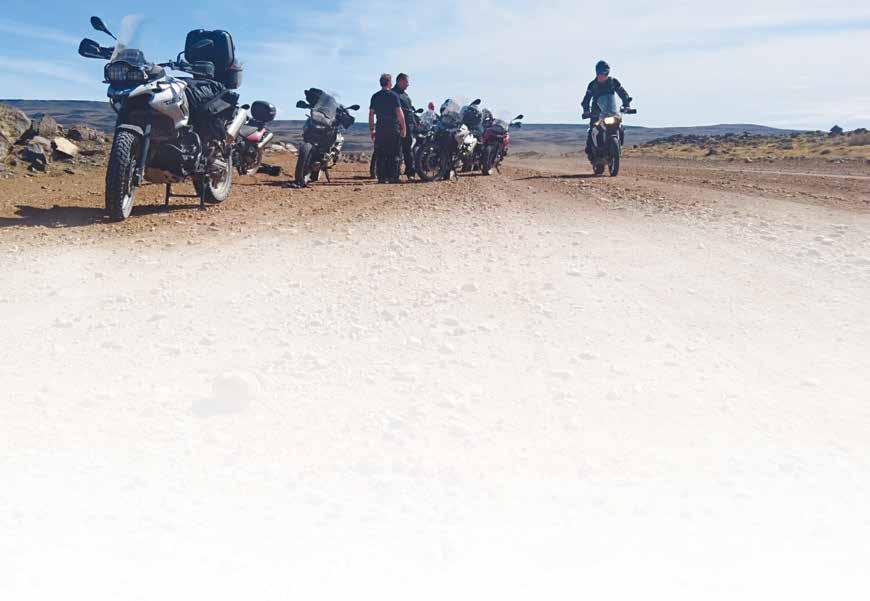
Decision made, we then put all our available spare time before departure into ramping up our technical skills, general fitness and building up our ride-time endurance levels. They were all great decisions as it turned out. In fact, I can’t stress how important it was to prepare physically and mentally for an adventure that mixed often long and arduous days in the saddle which took their toll on body and mind.
GS: You’re both mountain bikers and so have reasonably good levels of general physical fitness. What else did you do to get yourselves prepared?
DH: I need to make special mention of my ridding buddy, Yvonne. Yvonne got her motorcycle licence when she was 17, then didn’t ride during the family and mortgage years, but returned to riding in 2012 on a Honda 750 Shadow. In February 2016 we did a five-day tour of the NSW south coast and through the Snowy. Yvonne hired a BMW F650GS to see what such a different style of bike was like. It was no surprise when she came home smitten with the idea of adventure riding and enrolled in a BMW adventure riding course. It turned out to be an all-female affair and she couldn’t get the smile off her face. The Honda was sold and replaced with a near-new BMW F700GS. Eight months later she tackled the Ruta 40 with me.
How good’s that!
Once we committed to South America,
we spent every available opportunity riding all sorts of roads, I on my older F650GS and Yvonne on her newly acquired F700GS, to build up skill and confidence levels. We practised 180s, 360s, counter steering, riding standing on the ’pegs and so on over the many gravel roads in the Watagans behind Newcastle.
We also pushed ourselves into sand riding. OMG! We dropped the bikes numerous times, and on one occasion dragged them under a fence to avoid having to retrace an otherwise exhaustingly long ride.
Then we hit the gym eight weeks out from departure to build up body strength, fitness and endurance: three sessions per week, including once a week with a personal trainer. It was hard work, to say the least, but worth every moment. When it came to the adventure we had no trouble riding and manoeuvring the bikes and staying alert after hours in the saddle.
Not bad for a couple of 64-year-olds!
As for the reality of the South American loose gravel we’d read so much about, it was eye-widening to say the least, and certainly nothing like we’d experienced in Australia. It’s probably best described as largeish river pebbles that are quite slippery and slushy because they grind against each other producing a powder that acts like a lubricant. It made for unpredictable, soft and heavy riding, even when we were on top of our game.
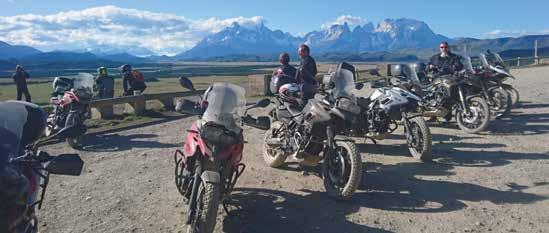
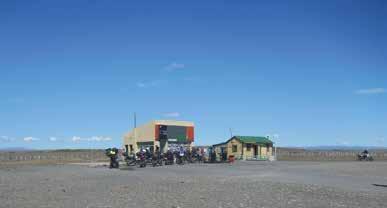
The best strategy was to pick a compacted track, stick to it, keep the speed up and get used to a fishtailing back end.
The crosswinds increased the further south we headed. They can move you around considerably, almost uncontrollably, on the loose stuff. They’re capable of blowing you off a track and down or deeper into the unpredictable gravel.
GS: Which tour operator did you end up with?
DH: Compass Expeditions appeared best-suited to our ambitions, needs and wants.
GS: When did you travel?
DH: We rode in November. The season then was influenced by its lower, fairly dry, average rainfall. In fact, we were lucky it rained on only one afternoon, and it was just showers while we were on tarmac, not dirt.
Thank heavens, because had there been more rain on those dirt roads our experience could quite easily have been horrible.
GS: How did the journey start and what were some the highlights?
DH: The guides put us through a day’s familiarisation on the bikes and there was no mucking about. Within 30km of leaving the expedition’s base we were off the tarmac and up a nearby mountain to the snow line, then back down what was a ‘very average’ combination of dirt and loose gravel. The guide’s objective was to observe and establish our small group’s competence. Skills ranged from fairly expert to timid, and we were comforted to see we were in the middle of the skills pack.
GS: Where was the start and finish?
DH: Our ride, like many, started in the pretty town of Pucon in Chile, about 800km south of Santiago. It’s on the Pacific Ocean, on the west coast of Chile. From Pucon we rode about 3400km to Ushuaia over a period of three weeks, crossing between Chile and Argentina.
Bottom
Below: Fuel only at this South American roadhouse.
Of that 3400-odd kilometres we covered approximately 900km on dirt and loose gravel. It was all do-able once we became accustomed to some very strong and unsettling winds. The trickiest part of the adventure for us was in the Torres Del Paine National Park, about two-thirds of the way through the ride. The encounter remains vivid in our minds with winds at 80kph and very loose, deep gravel, so we really did need to keep our wits about us.
Bariloche, which lies approximately south-east of Pucon among some magnificent mountain lakes, is majestic. You could be forgiven for thinking you were in Europe, it’s so beautiful.
The other awesome scenic area was the road into the town of El Chalten at the foot of Mount Fitz Roy and the Cerro Torre.
The picture vivid in our minds is of the saw-toothed, whitecapped image of Mt Fitz Roy gradually rising over the horizon against a deep-blue sky.
It was one of several pinch-yourself-because-it’s-real occasions.
El Calafate and west to Perito Moreno Glacier were stunning and powerful statements of Mother Earth’s power, scale and proportions. While you’re riding you really do get up close and personal with this giant South American mountain backbone.
GS: Nobody starved?
DH: Absolutely not!
Let’s be totally clear: Argentina is a meat-lovers’ paradise, and quite definitely a vegetarian’s nightmare, as one of our fellow overlanders discovered. And it gets better when you add the red wines into the equation – the Argentinian Malbec and Carmenere variety in Chile are hard to beat.
GS: You’ve recently returned from an overland through Romania, Hungary and Slovakia. How did that come about?
DH: Yvonne said she’d like to see some of Eastern Europe. I replied, “Okay, but how about on a bike?”
We hired two F650GSs from a company in Romania’s capital, Bucharest.
GS: What was your best tarmac-chasing moment and stay?
DH: Transfagarashan Mountain Pass, without doubt, northwest of Bucharest.
It offered large, wide, mountain vistas via a road that’s truly serpentine. Our favourite stays were in the painted monasteries of Bucovina in north-east Romania, and the small Hungarian town of Kecskemét. That’s a great place to stroll, or relax over an espresso, wine or beer, and Lake Balaton, in central Hungary. It’s a waterside holiday destination that’s a world away from our way of coastal enjoyment.
GS: So what’s next?
DH: It’s time to visit more of Australia…on our bikes of course!
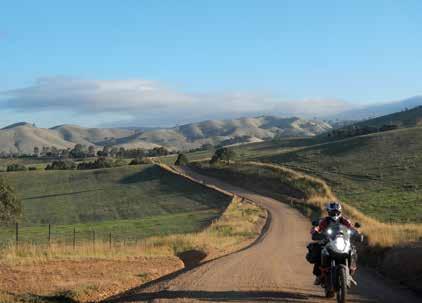
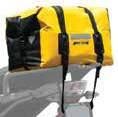
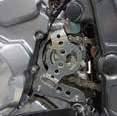
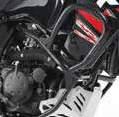
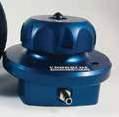
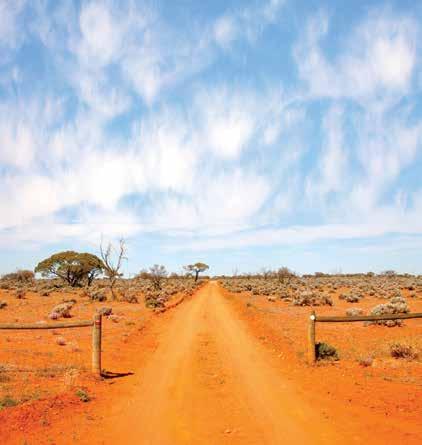

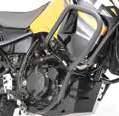
This is what happens when you take a tour of Peru, Northern Chile and Bolivia with a bunch of riders who all share a passion for travel, fun, good food, libations, and of course, riding motorcycles.
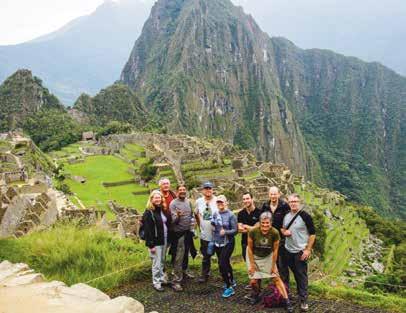
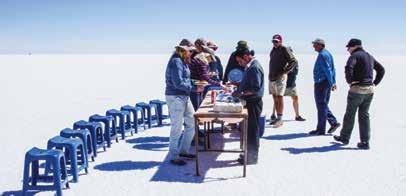
Main: The epic and nerve-wracking Death Road in Bolivia.
Right: Pisco Sours became the team’s Gatorade for the tour.
Below: There was no shortage of photo stops to try to absorb the sensory overload.
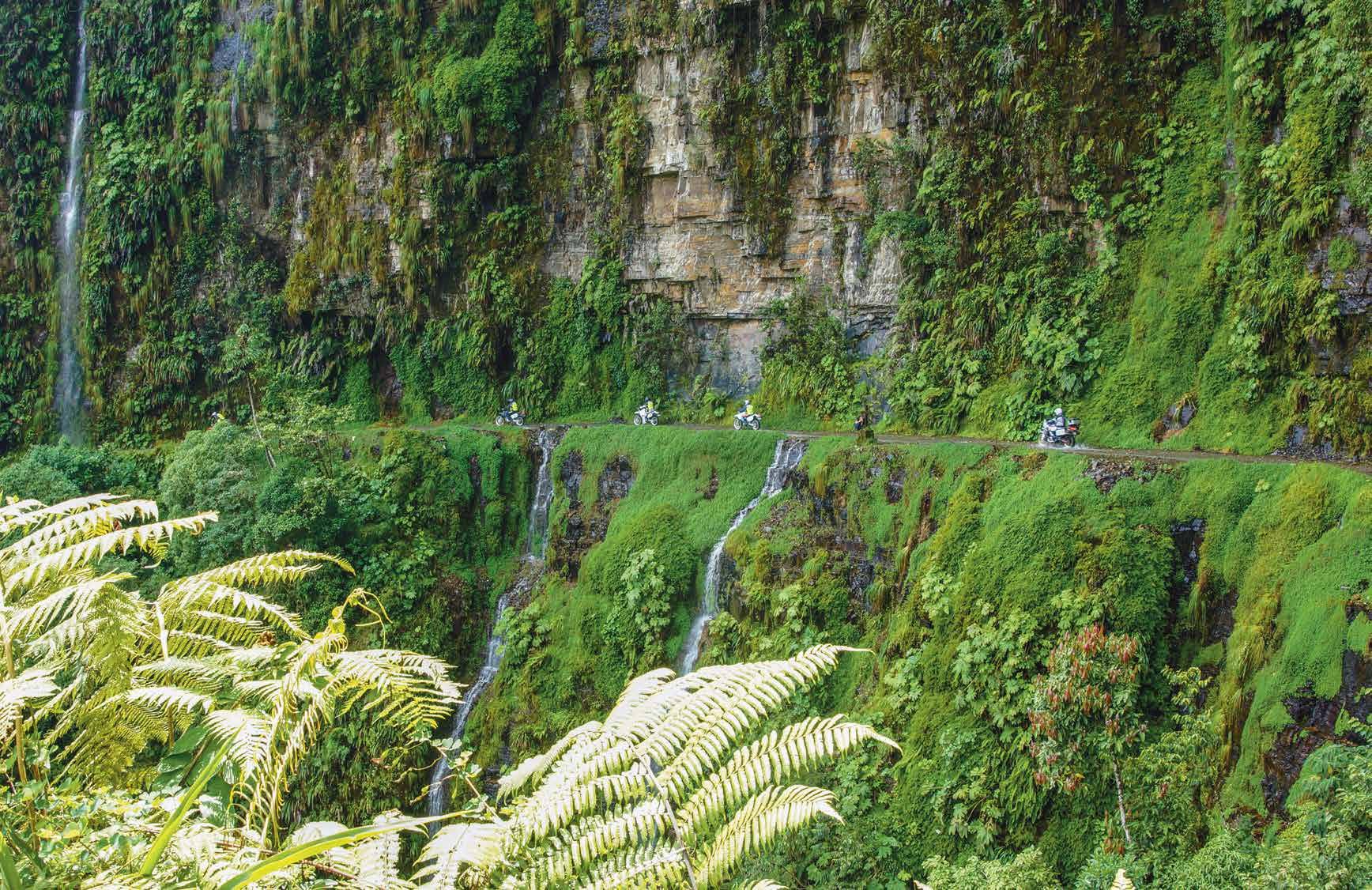
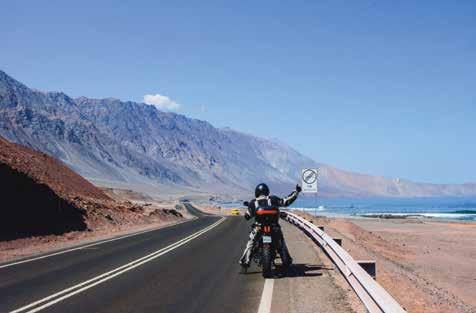
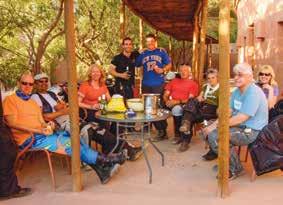
It was apparent from our first dinner together this group was going to get along just fine. Even before the entrée was delivered to the table the die had been cast with a welcome round of Pisco Sours. None declined, and it was a great sign. The cocktail of Pisco (a type of brandy), lemon juice, sugar syrup and egg white became the team’s Gatorade for the remainder of the tour.
Both Chile and Peru claim ownership as the originators of this delicious aperitif, with Bolivia having its own variant, but since the city of Pisco is in Peru, we gave the Peruvians the credit.
“We
cruised kilometre after kilometre of sweeping bends.”
The first day’s ride followed the spectacular Pacific coast of Northern Chile before what felt like a climb straight up onto the Atacama plateau and into the desert.
Riding along the coastal road was wonderful. The ocean was directly on the right and the bare dunes and rugged mountains close on the left as we cruised kilometre after kilometre of sweeping bends.
After lunch and a fuel stop the climb began and the perfectly made road wound its way via switchbacks and meandering ascents up into a landscape that left everyone in awe. I’d never seen such a lack of observable life in a landscape before.
Usually a desert will have hardy bushes or drought-tolerant grasses, perhaps even some gnarled trees along a dry watercourse. But on the Atacama there was nothing but dirt and rock and an unrelenting sun. Apparently there are parts of the Atacama Desert that have not seen rain for the past 400 years – or at least as long as history has been recording such things in that part of the world.
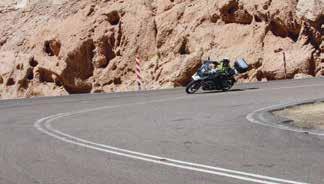
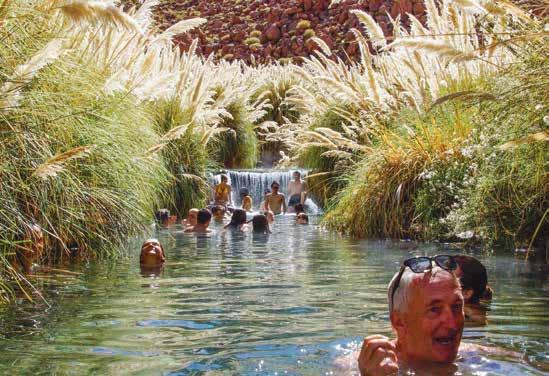
As terrifying and remarkable as the landscape was, we were safe in the knowledge that our bikes, BMW GSs and Triumph Tigers, were reliable and we had our Compass Expeditions support crew as backup if anything went wrong. We also knew there was a very comfortable hotel at the end of our amazing day’s ride in San Pedro de Atacama.
Star struck
A day of sight-seeing in and around San Pedro saw everyone soaking in natural hot springs which flowed from deep under the desert to form an oasis of cascading pools. Some explored the hippy town with its markets and fine restaurants. In the evening, we ventured out to watch the sunset over an incredible, otherworldly, landscape and sip Pisco Sours.
From San Pedro the ride headed further across the Atacama towards Bolivia. The roads were well made, sometimes winding through dry
valleys, over passes through rugged ranges or later in the day across featureless plains surrounded by snowcapped peaks and distant volcanoes. There was no shortage of photo stops to try to absorb the sensory overload.
Our overnight stop was the remote border village of Ollague at the base of the Ollague volcano.
We had been warned the night’s accommodation would be ‘rustic’. It was a basic homestay with bunkrooms and shared facilities, but the spectacular location, picturesque wild-west-looking village and excellent home-cooked dinner more than made up for the lack of star rating. In fact, the simple chicken soup served for starters that evening was hailed as the dish of the tour so far…and we had been eating very well indeed. We didn’t even lack for Pisco Sours as emergency supplies of Pisco and Pisco Sour pre-mix were produced from bags and top boxes to see us late into the evening.
After climbing most of the day, altitude sickness started to affect some of the jolly crew. There were a few green faces in the customs queue the next morning as we waited to cross the Chile/Bolivia border. Luckily the support van was carrying oxygen bottles for just that situation and it made all the difference. Everyone was in good shape as we headed towards one of the many highlights of the tour – the impressive, Uyuni Salt Lake.
While we were at altitude for quite a number of days throughout the tour, this was the only point where the oxygen was required. Although we all felt the effect of the altitude with shortness of breath, lethargy and the occasional headache, most managed to keep things rolling along by staying well hydrated, laying off the Pisco Sours (to some extent) and with either modern medical means or the local equivalent of a cheek full of coca leaves.
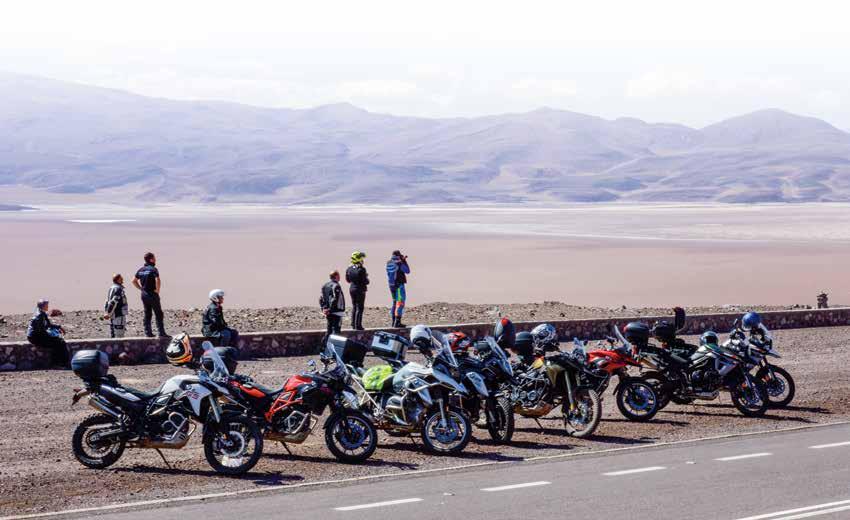
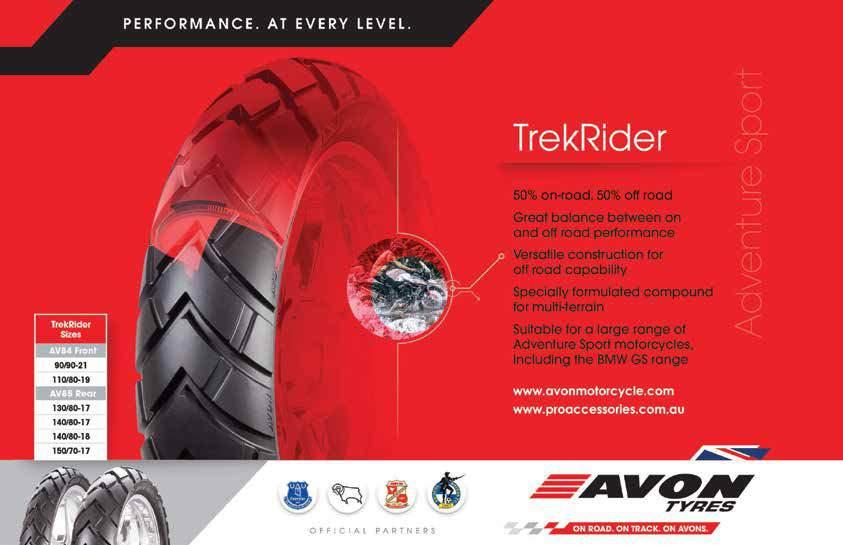

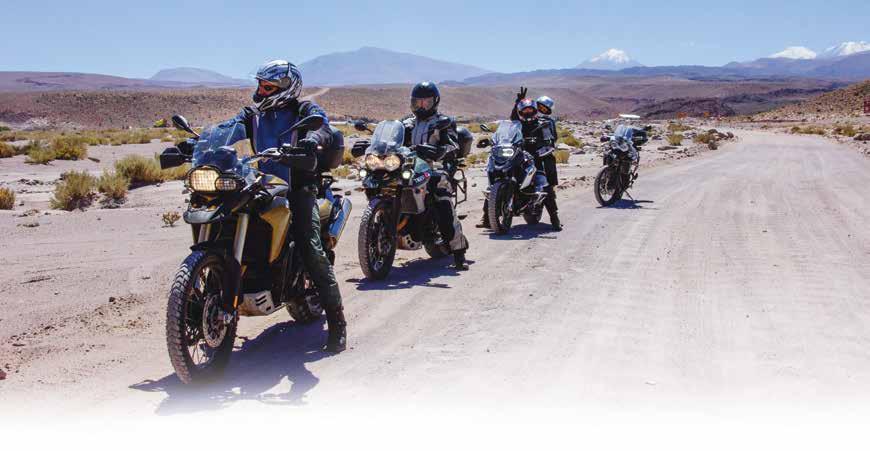
Rough and stumble
Once we entered Bolivia the roads immediately became dirt.
Bolivia is a much poorer country than its neighbours Chile and Peru, and the infrastructure, including major roads, is not well maintained. The local drivers also seem to be less well maintained.
Having said that, if you didn’t mind a well-packed dirt road and could quickly adjust to a defensive riding style, the ride in Bolivia quickly became enjoyable. The scenery just kept getting better. There was only one section of road works that saw everyone diverted onto a temporary track. Deep sand is always a concern on a big adventure bike, and doubly so for those carrying a pillion or with not much off-road experience.
A bruise here and a scrape there, a little cosmetic damage to a couple of bikes and an adventure to discuss over Pisco Sours that evening was the worst of it.
The off-bike day in Uyuni was another gob-smacking overload to the senses with a 4WD tour on to the largest salt flat
in the world, the Salar de Uyuni.
We visited a hotel made completely of salt, including the rooms and the bar, the giant Dakar Rally monument (also made completely of salt) and had one of the most surreal lunch stops that could be imagined.
The salt flat is 11,000 square kilometres, so it didn’t take much to be out of sight of all other people and the edge of the lake. The result was a 360-degree view that showed almost no visible horizon due to the reflection from the salt. We sat in a row on small plastic stools and ate local fried chicken while staring into a most disquieting void. The light and the reflections of sky, salt and water played tricks on the eyes and I was amazed our local drivers didn’t get disorientated while barrelling across the expanse.
Through more salt plains and desert wasteland, weaving through mountain ranges and around smoking volcanoes, we headed towards Potosi, once one of the world’s wealthiest cities. On the way we had a chance to visit, and help, some of Bolivia’s most needful children. Compass Expeditions has been supporting the local school at Chaquilla for many years and guests on Compass tours are encouraged to help out with
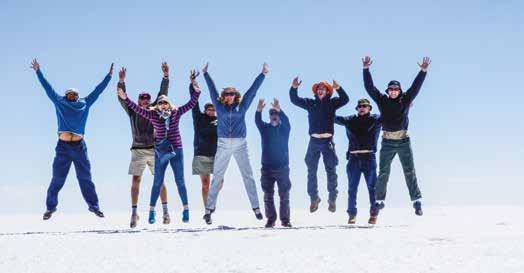
gifts of school supplies, sports equipment and fresh fruit and vegetables.
A quick lunch, a bit of street soccer and amusing the kids with the motorcycles and the crew was back on the road. The landscape became progressively greener as we moved out of the desert and into the mountains.
JC, our ever cheerful, helpful and hard-working support-van driver was also the designated chef for the tour and how happy we were for that. It never ceased to amaze us that JC could whip up a fresh, healthy and supremely tasty lunch from the kitchen in the back of the van. It was like magic when fresh sal-
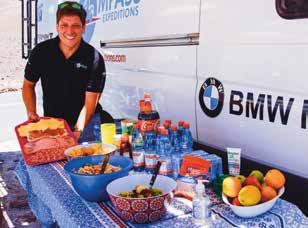
Top: Triumphs and BMWs, so no problems. Photobomb...still no problems.
Above: JC, our ever cheerful, helpful and hard-working support-van driver was also the designated chef.
Below left: The largest salt flat in the world, the Salar de Uyuni.
Below: Salar de Uyuni is the largest salt flat in the world. Even the giant Dakar Rally monument is made completely of salt.
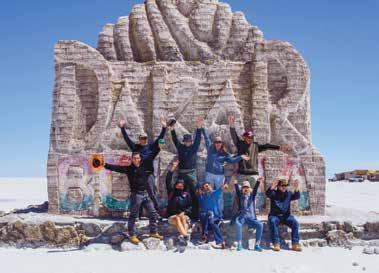


Local knowledge and a helping hand !!
v 10th May 3-day WA Pilbara Station Start Sth Headland $300
v 24th May 3-day QLD Sunshine coast $300
v 31st May 3-day NSW West Quirindi to Cameron’s corner $300
v 1st June 14-day ADVX Perth To Byron Bay $1800
v 6th June 5-day VIC VIC Desert Start Albury $500
v 15th June 3-day NSW Nth Training Camp Piora $390
v 25th July 3-day QLD Bris to Emmaville and return $300
v 10th Aug 2-day NSW Start/Finish Mudgee $200
v 19th Aug 4-day WA Great Sandy Desert Ride Pilbara $400
v 23rd Aug 3-day QLD Boonah to Dorrigo $300
v 5th Sept 3-day QLD Brisbane to Mackay (grass tree beach race) $300
v 14th Sept 3-day NSW Training Camp Piora training camp $390
v 28th Sept 2-day NSW Nundle to Foster $200 (EASY)
v 31st Sept 3-day QLD Western Burnett ride Start Childers $300
v 5th Oct 4-day QLD Brisbane to Bathurst $400
v 10th Oct 3-day VIC High country ride Albury $300
v 19th Oct 2-day NSW Mudgee Start/Finish $200
v 23rd Oct 3-day QLD Wine and dirt tour Stanthorpe $300
v 8th Nov 4-day QLD Annual Bris Suzuki “DR RIDE” $400
v 24th Nov 4-day TAS Ultimate loop $400

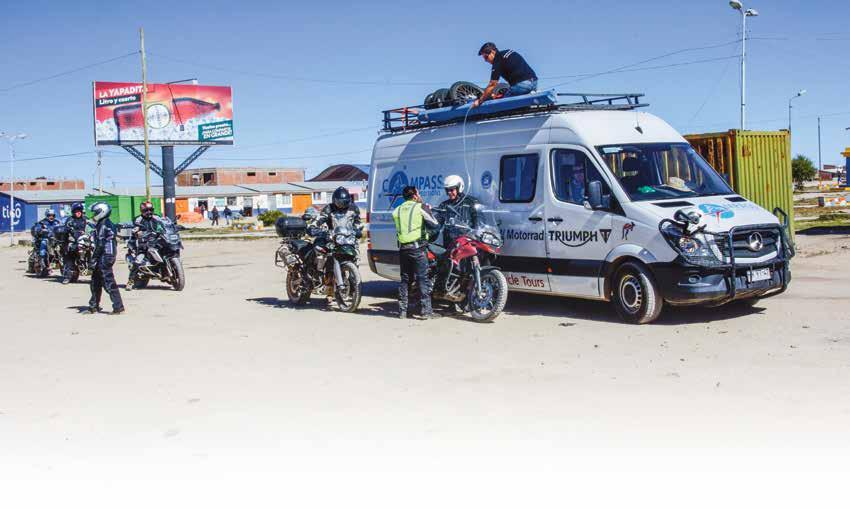
ads, guacamole, pasta and a selection of cold meats would be produced from what seemed like nowhere, all by the time we’d set up some shade and arranged the trestle tables and chairs. Each ride day his menu was fresh, varied and wholesome.
Culture club
The people of Potosi have mined silver, tin and other metals from the surrounding

The silver shipped back to Spain helped make that nation rich. It also made Potosi one of the wealthiest cities in the world and this can be seen today in the beautiful Spanish colonial architecture of the city.
Our ‘rest day’ in Potosi was anything but. A visit to a silver mine that still functioned in a very traditional way, with miners moving much of the rock and soil by hand with basic tools, proved very exciting. It’s dangerous work, with no concessions to modern safety standards. A miner’s life in those parts was generally not a long one.
After the mine tour we then took a city tour which showed us around many of the city’s beautiful churches and other colonial-era buildings. The finale of the day was witnessing a very solemn Easter procession, including a number of brass bands and different community groups, marching with statues of their saints and religious icons mounted on the shoulders of dark-suited and elaborately brocaded officials.
It was another unexpected taste of the local culture.
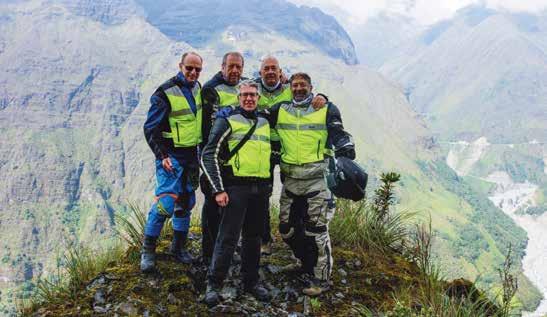
From La Paz the route headed towards the famous Lake Titicaca. Depending on preference, this was perhaps the best day’s riding so far, with good, sealed roads tightly twisting and winding through the mountains further into the Andes. Lake Titicaca spans the border between Bolivia and Peru, so we ticked off another border crossing and took a ferry across the world’s highest navigable lake, then rode around its shore to another colonial gem, the city of Puno.
Continuing the climb into the Andes on the way to La Paz we twisted and snaked upwards across high passes, one at over 5200 metres, and through small villages. The roads were sealed but the prevalence of potholes meant a brief lapse of concentration could end in a very dinted rim, if not a spill.
La Paz is a large, busy and slightly crazy city nestled in the cradle formed by the steep sides of a ring of mountains. The city centre is low in the valley, but the outer suburbs are high above on the rim of a plateau. In between the city looks stacked on top of itself as it climbs up the steep sides of the surrounding slopes. Out of La Paz we had the chance to take on the ‘Death Road’ day excursion. Having watched a number of YouTube videos of this intimidating road I was keen to match my skill and wits to it. I wasn’t disappointed. I could write a separate story about the experience so in this tale it will suffice to say I had one of the best days riding I have had for many years on a well-used Suzuki DR650 belting through the streets of La Paz, into the hills and down, and then back up, the epic and nerve-wracking Death Road. It turned out the scariest part was the traffic chaos, at breakneck speed, to get out of the city.
Our hotel on the central plaza of Puno was just a pedicab ride to the lakeside dock and a morning tour out on the lake to visit the floating Uros islands and experience something of the Uru culture. These 120 or so islands are constructed from many layers of reeds and require constant maintenance to remain afloat. They support houses, schools and a traditional community that has lived on the lake for around 500 years. Interestingly, the Uru retreated onto the lake in an attempt to avoid being colonised not by the Spanish, but by the Inca, who conquered the land and taxed the people.
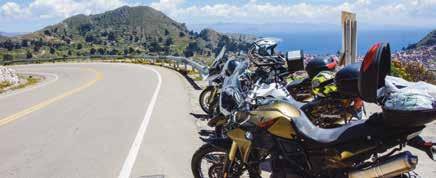
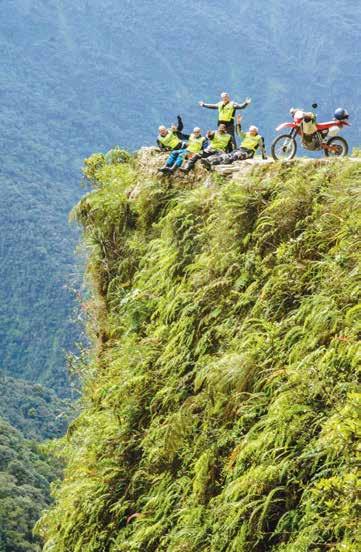


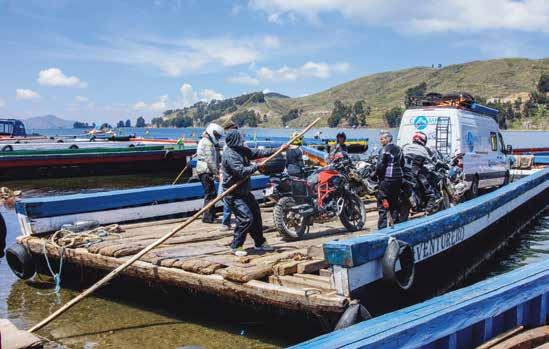
Another unbelievable day of mountain riding through the heart of the Peruvian Andes, and more high passes and views, made it hard to concentrate on the incredible road as we approached the ancient heart of the Incan empire, Cusco.
Cusco is an old city built on an even older city, resulting in the maze of tight roads and alleys that spread out from the wonderful central plaza. Colonial style buildings are built on the massive Incan stone foundations of the earlier civilisation. The city has so much history you could spend a week and not scratch the surface of all there is to see.
Our day tour of pre-Incan sites around the outskirts of the city gave us an insight into the scale and complexity of each successive era of human habitation of the region.
After16 days of mind- and eye-opening experiences and fantastic riding the tour was nearing its conclusion – or rather, building up to its grand finale.
The mysterious and majestic lost city of the Incas, Machu Picchu, had been on my hit list for many years. On my three previous trips to South America I’d never
Left: Lake Titicaca spans the border between Bolivia and Peru. A ferry across the world’s highest navigable lake had the riders heading for the city of Puno.
Below: Unbelievable mountain riding.
Right: A 90-minute trek up the Incan stone steps.
Far right: The constant roar of the raging river, a couple of metres below the hotel room balcony, sent guests off to sleep.
managed to fit it into the itinerary.
The anticipation was almost unbearable, but our ride from Cusco through the Sacred Valley of the Incas did a lot to take my mind off what I could expect from the following day.
The view down the Sacred Valley from the balcony of an unexpectedly lovely coffee stop set the scene for our ride. We dropped steeply down to the valley floor and followed the fast-flowing Urubamba river to Ollantaytambo, the departure point for the train to Aguas Calientes and our last night before the visit to Machu Picchu.
I almost wished I hadn’t had that last Pisco Sour as the alarm sounded the next morning at 4.30am. The constant roar of the raging river a couple of metres below my hotel room balcony had sent me to sleep, deep and peaceful (perhaps the Pisco Sours helped there too).
A head-torch, camera, snacks and a jacket for the cool, misty morning were stuffed into my pack as I headed out the
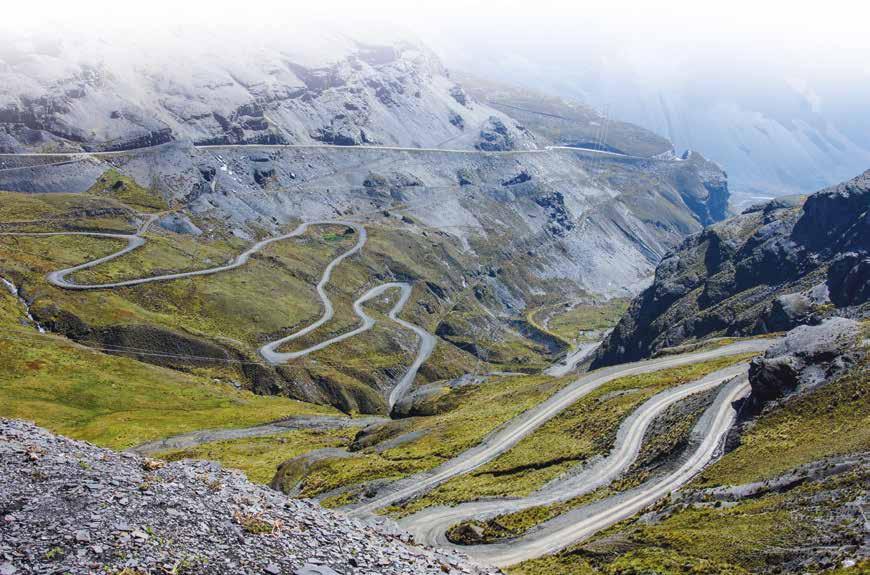

door to join the group who’d decided a 90-minute trek up the Incan stone steps was a better idea than joining the rest of the group in a queue for a crowded bus ride to the entrance to the world-famous site.
We made it to the entrance, hot and breathless, but just in time to witness the cloud misting away and the early morning light illuminating the splendour of the mountaintop ruins.
Machu Picchu, the ruins of a long-lost citadel, reclaimed from the jungle on this remote and spectacular mountaintop, were awe-inspiring enough. The mystery of why and how it was constructed, and even the tale of Hiram Bingham who ‘re-discovered’ the site in 1911, added wonder and romance to the place.
Ruben, our guide, was encyclopaedic in his depth of
knowledge of the site as he led us around all the major features, and filled us in on what was known, suspected and rumoured about the legendary place.
The anticipation at visiting Machu Picchu wasn’t misplaced. The experience proved just as wonderous as I’d hoped. How often can you say that of an often-longed-for and finally realised adventure?
No anticlimax here!
And I can say the same about the Atacama to Machu Picchu (now ‘On The Trail Of The Incas’) tour as well. It over-delivered on many fronts with amazing riding, seemingly endless highlights, great food and accommodation, professional and ever-helpful crew and, of course, the genial and amusing company of like-minded friends.
My heartfelt thanks to all involved.
For more information visit the Compass Expeditions ‘On The Trail Of The Incas’ tour webpage at: www.compassexpeditions.com/tours/on-the-trail-of-the-incas/
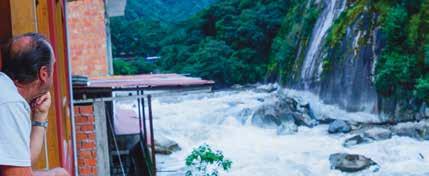
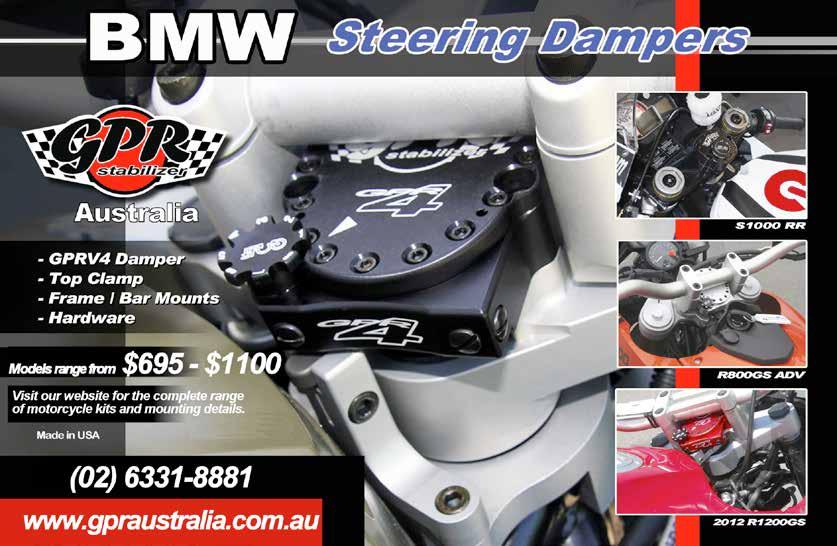
Don Bromfield’s exploration of the US continues.
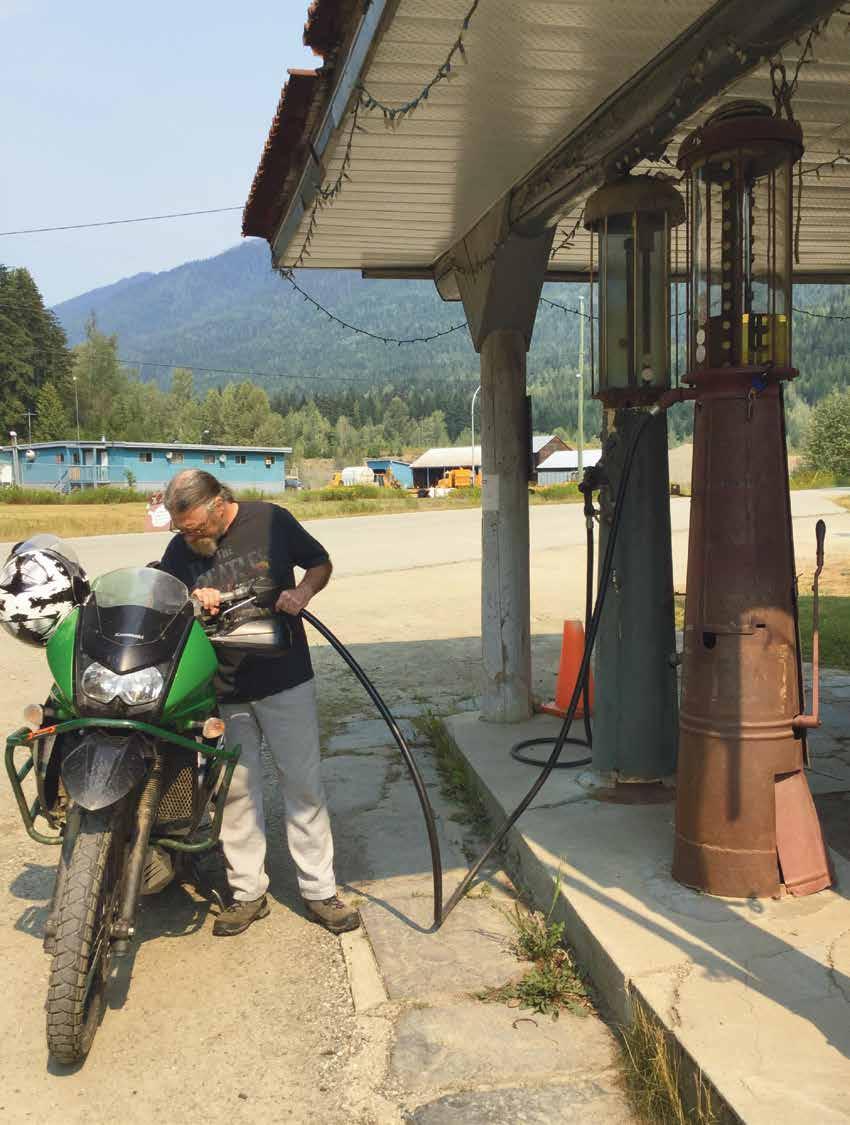
ANorth Dakota oil field truckie suggested, “Head for Sidney and Sarco. That’s the old Montana.”
“Sarco?” I wondered out loud.
“Where’s that?”
It turned out to be the town of Circle in the McCone county. I punched the name into the GPS and headed westward across the prairies and lowlands of the American west.
Montana is best enjoyed off the grid, and certainly off the interstate. Cropping, ranching and the occasional badlands punctuated the run to and beyond Circle. Occasionally a slowly pumping oil head would rise and fall from view. Late in the afternoon with thunderstorms streaking black on the horizon I decided on the concrete Hilton – to camp under a picnic shelter at a roadside rest area.
genuine article
The next morning, like most of my Montana days, started with looking for breakfast. My preference is for small rural towns. I’d look for the local diner or café where old-timers gather for breakfast and conversations about the baseball or the local rodeo or the problem with the pickup.
After packing my gear and ironing out the kinks I fired up the KLR and turned on to a minor road for a 50km gravel run through the prairie ranch back-country.
As dawdled along a distant dust cloud slowly morphed into a herd of cattle being moved along by a solitary woman on horseback. I stopped to watch and savour the moment. Soon after I caught a glimpse of a brightly painted cowboy camp wagon straight out of a western movie, while the occasional small group of free-ranging cattle and horses watched
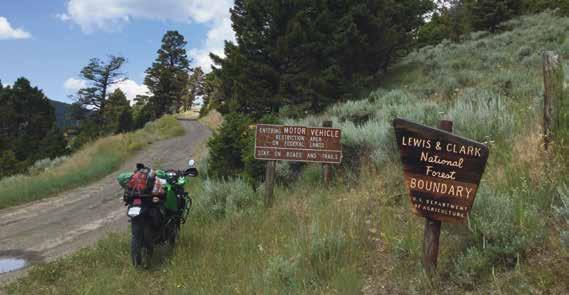
my dusty passing with curiosity.
After turning back on to the bitumen I arrived at Melstone in ranch land, central Montana, population about 100.
As I climbed off the bike up drove an old guy in his Edsel. Well there’s a conversation straight away.
wonder at the loneliness and privation that must have come with the approach of winter in such a harsh and isolated pioneering environment.
The opportunity to ride on some of the Lewis And Clark National Forest roads drew me further into the hills of the backcountry near Martinsdale, and it was here, on an innocuous rise, I had my only fall for the trip. I was in second, had no revs, and stalled. My legs were too short for the camber and down I went. It was a reality check. I was a bit far from help if I’d broken a leg or the bike.
A chat followed and we headed inside to be greeted by a real-deal cowboy drinking black coffee: dust-covered boots, Levis held up with the leather belt and big metal buckle, chequered shirt, cowboy hat and, to top it all off, spurs.
Riding further westward through the slow transition from the prairies, I was attracted by the sight of groups of abandoned farm buildings, ravaged by time and weather, accompanied by slowly decaying vehicles often backdropped by the snow-touched mountains. I can only
I dropped on to the interstate for the run into the historic mining town of Butte, but left after a short while as it seemed strangely lacking in character. All the mines and old buildings are still there perched on the hillside, but enveloped by a modern town of 40,000 people. The little silver mining town of Wallace just over the border in Idaho was much more to my liking. The Red Light Garage with its walls covered with old number plates, hub caps, phones and other antiques was a great place for a meal and chat.
“I can only wonder at the loneliness and privation that must have come with the approach of winter in such a harsh and isolated pioneering environment.” u
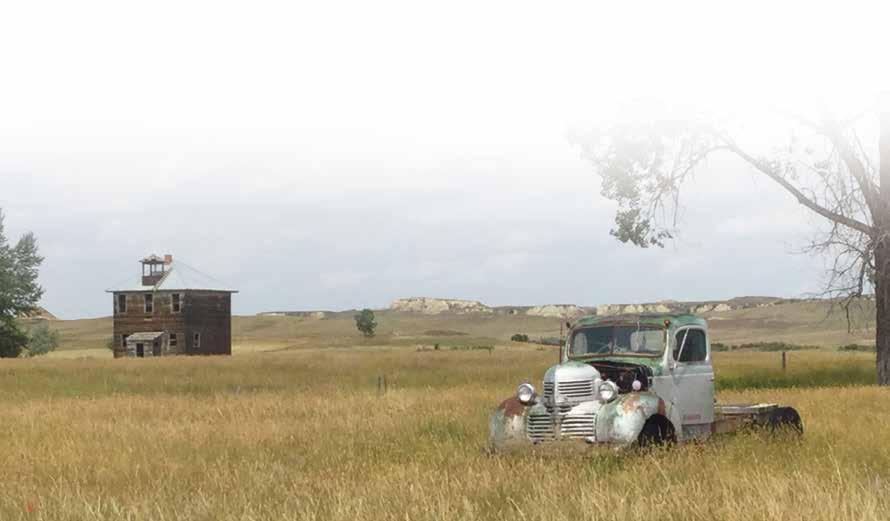
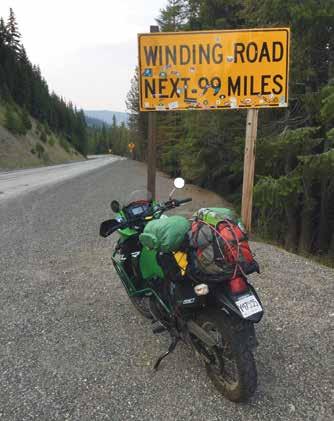
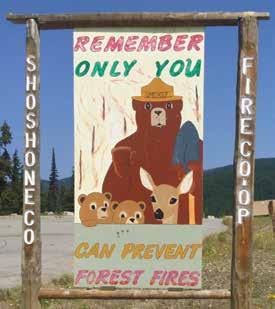
Carving through the curves of Chief Joseph Pass southwest from Butte was my next goal and proved a great primer on the run to Lolo and the famed Lolo Pass. At the top of the pass I stopped to chat with a local couple who were picking huckleberries. They were tasty little berries, but you needed an awful lot of them to get a good meal. The bears must find them frustrating.
Just over Lolo summit pass was a sign saying ‘Winding Road Next 99 Miles’. Woohoo!
Kooskia was the destination as the road twisted and turned on its descent through verdant forests alongside the whitewater rapids of the Lochsa River. It’s easy to see why Lolo is near the top of US ride recommendations.
Wallace was the end of my brief Idaho detour. Locals suggested I ride the backroad over the mountains to Thompson Falls and then on towards Troy. This didn’t disappoint, with forested mountain passes and tumbling streams along the curving roads. It was in this area that I relived my Little Golden Books childhood when I came across a Smokey The Bear fire warning sign. That certainly dates me – and you, if you know what I’m talking about.
The Giant Cedars and Ross Creek Scenic Area provided a great campsite for the night. I pondered what had been lost as I walked through the remnant patch of unlogged oldgrowth forest.
The next morning I started my run towards Glacier National Park, but was stopped by wildfire road closures at the small settlement of Yaak. Sitting on the
porch of the general store with a Coke, I started a conversation with a backwoods local who had come into town to hook into the store’s wifi. He described his encounters with mountain lions and timberwolves as well as the local bears. Montana and the mountains north and west are wild country and riders need to care. The recent death of a mountainbiker taken by a mountain lion in Washington State, and of a mother and her young daughter lost to a grizzly in The Yukon, emphasise the potential risk. Like our crocodiles, awareness, education, preparation and common sense can minimise the risks.
“I relived my Little Golden Books childhood when I came across a Smokey The Bear fire warning sign.”
The Sun Road is an iconic US route through Glacier National Park and, as such, is packed with tourists in all sorts of vehicles from open-topped buses to full-dress Harleys. The toll for park entry is well worth the money as the road climbs from the valley floor to dizzying heights in scenes reminiscent of the Italian Dolomites. Snow-capped craggy peaks, sheer rock faces, tumbling waterfalls and hanging glaciers are in abundance to please the eye.
Well. Perhaps I exaggerate a little. The state of the glaciers was a bit of a worry.
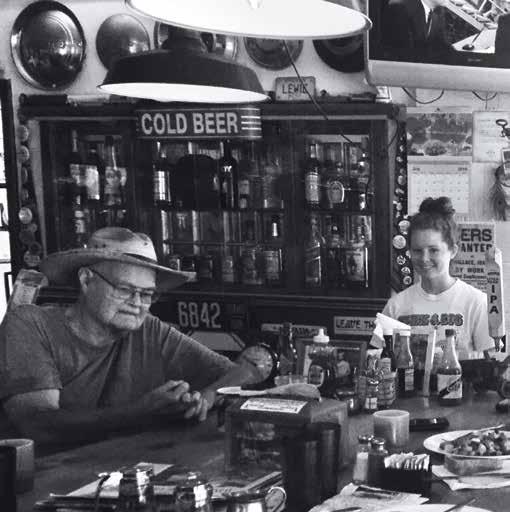
My run to the Canadian border took me through the town of Eureka, which was decorated with over 400 colourful patchwork quilts hung from shops the length of the main street. It was the annual quilt fair, and gave a wonderful perspective on the enthusiasm the locals have for reinventing the struggling former logging community in its push towards the tourism dollar.
From Eureka I quickly arrived at the border crossing where the Canadian official spied my home-made licenceplate replacement. I’d forgotten about it.
I thought it looked good with its white tape backing and carefully drawn texta letters. I even went to the trouble of writing “Beautiful British Columbia” across the top. However, like his US counterpart back in North Dakota, he obviously didn’t appreciate art or Aussie ingenuity.
“You can’t do that. How far have you come? When did you lose the plate?” he asked in a most un-Canadian tone of indignation.
Well I did do it, and I’d travelled over most of Canada in the previous month, and, what’s more, the bike didn’t seem to mind.
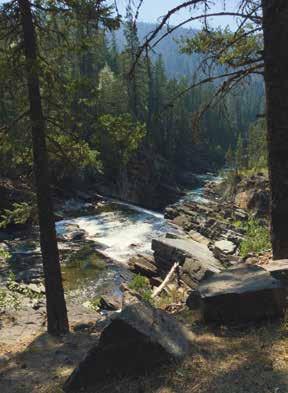
After huffing and puffing for half an hour he sent me on my way to Fernie, the nearest town, to get a new plate. In Fernie a nice lady informed me I couldn’t have replaced it if I’d tried as they don’t send the validating stickers that need to go on the plate out of the province. I was over the border.
With three days riding to go in my Canadian odyssey I discovered the wilds of the Kootenay. What a day followed. It started when I camped up at Toad Rock Biker Campsite, run by Mary, a
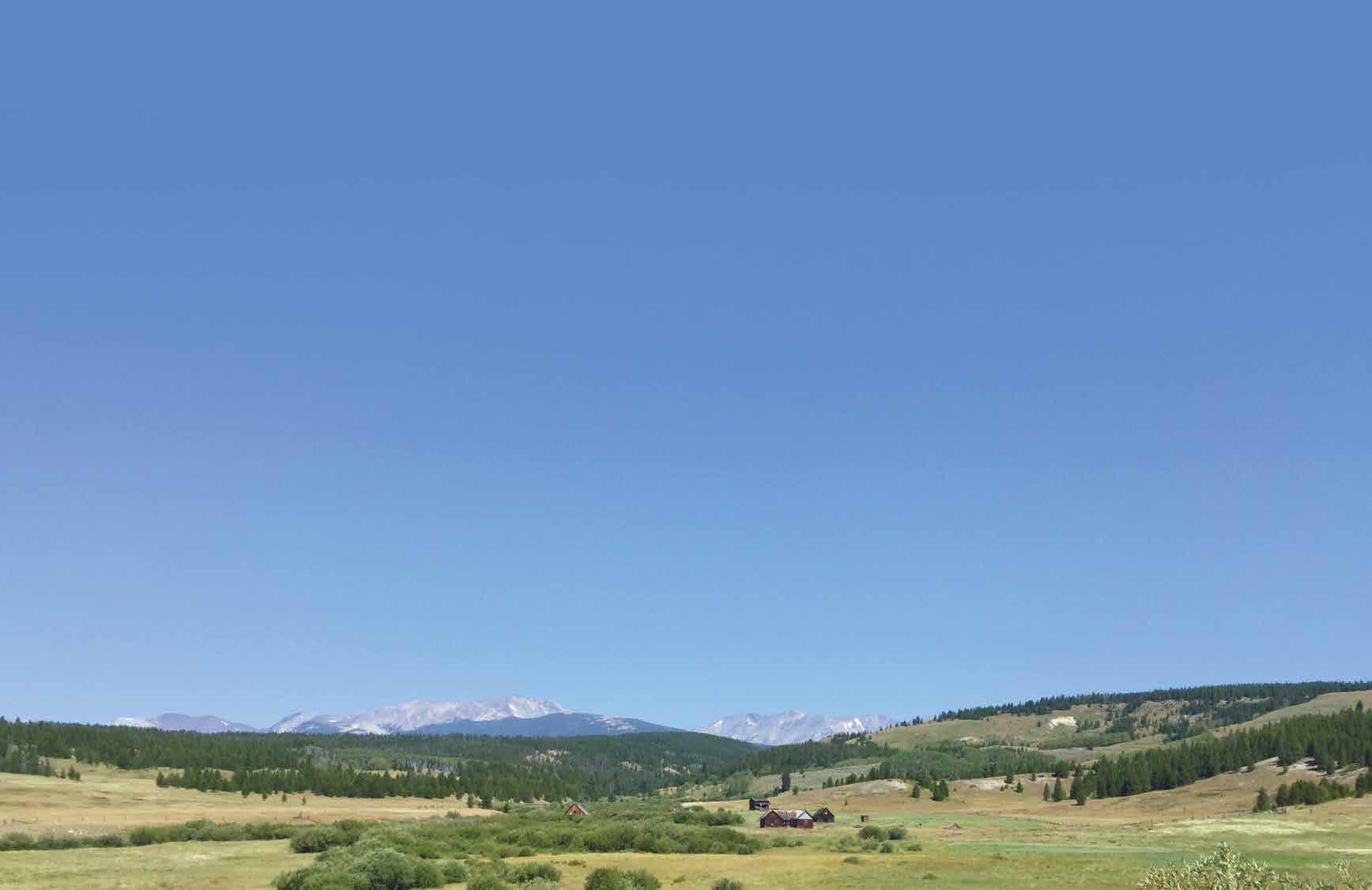
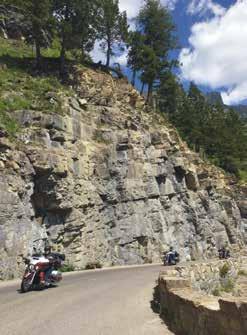
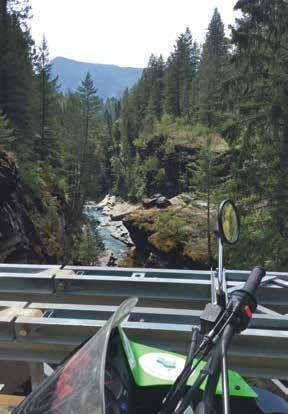
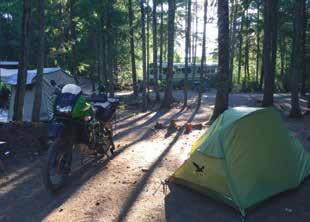
biker of about my vintage. Toad Rock is open to anyone on two, three and even those on four wheels. It’s a ramshackle collection of campsites, old buses converted to bunkhouses and hire tents set in the Kootenay forest near Balfour. Mary’s greeting went something like, “Pay when you go, camp wherever, the beer tent is over there and there’s food from a local restaurant in the fridge. It’s all honesty system, just put your money in the tin.”
So after putting up my tent it was off for a beer. It was a hot day, and a pleasant few hours were whiled away talking to some hardcore bikers about Harleys, café racers and occasionally Indians. They weren’t mainstream Harley types, but rigid-shovel chopper riders. And that was only the girls – although hers did have electric start.
The next morning I was awakened by the dulcet ‘potato-potato-potato’ sound of the occasional Harley starting and the smell of an early-morning joint.
After packing it was off to nearby Kaslo for breakfast where a young guy gave me the lowdown on why it was probably not the best idea to ride out to Argenta. He grew up and lived there on a commune and explained how the
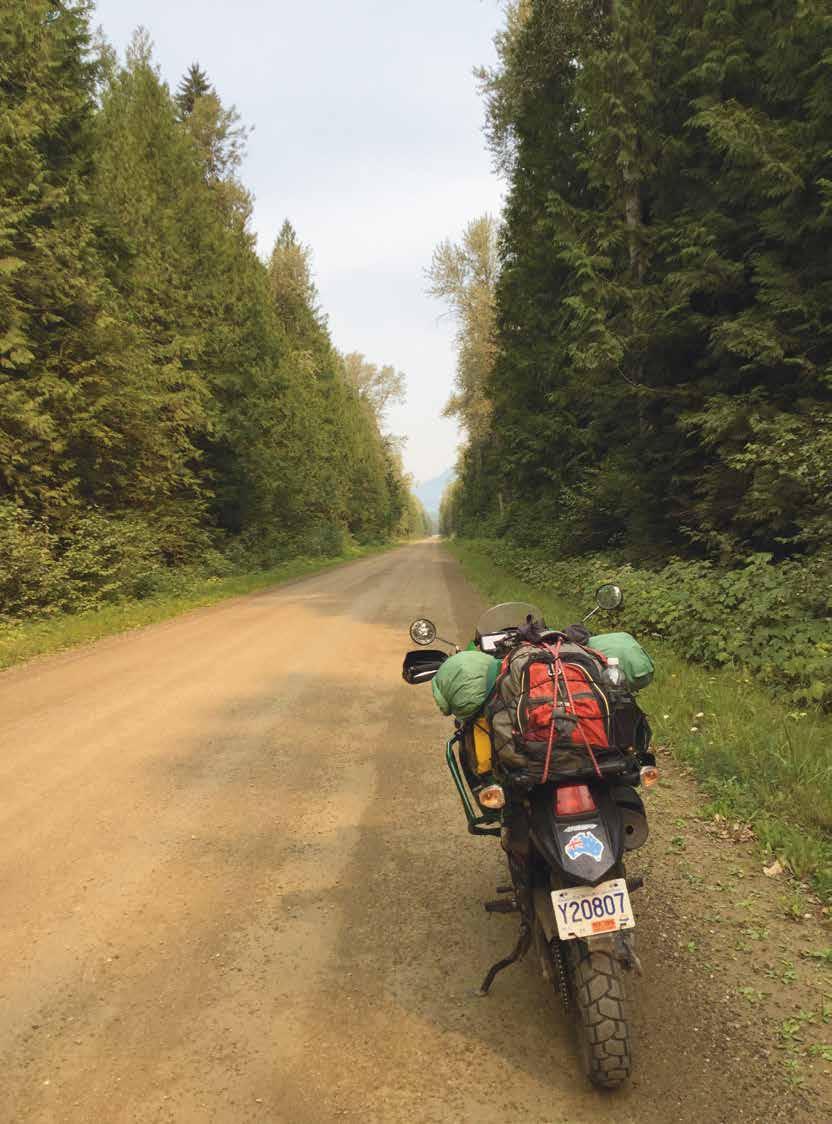
community evolved from an odd mixture of Quakers who arrived dodging the draft in WW2, hippies from the Haig Ashbury days, Vietnam draft dodgers, selfsufficient commune types and the occasional prepper neo-nazi. All were somehow living together in a community bonded by enthusiasm for the isolation of the forest and nature. However they don’t like strangers intruding on their peace and quiet – or disturbing their crops, I imagined. I took his advice and amended my plans and instead headed for Meadow Creek.
Smoke from numerous BC wildfires tinged the air from there to Trout Lake. The 100km of ‘Highway’ 31 was on great, hardpacked gravel through dark avenues of overhanging Kootenay forest, and ran beside lakes and streams before climbing to give glimpses of snow-touched mountains in the distance. I passed the occasional cabin tucked away in the forest and daydreamed of renting one and heading into the hills on the forest service trails.
Just when I thought the ride couldn’t get any better I arrived at Trout Lake and a scene straight out of American Pickers. I watched as fuel was hand pumped up into the glass bowl of the 1912 antique pump and then drained by gravity into the bike.
From Trout Lake I had a relaxing hour’s wait in the afternoon sun for the ferry crossing at Fauquier, then a roller-coaster 160km ride through Ducati country to Vernon and my motel for the night.
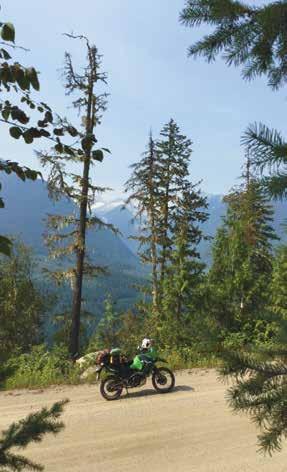
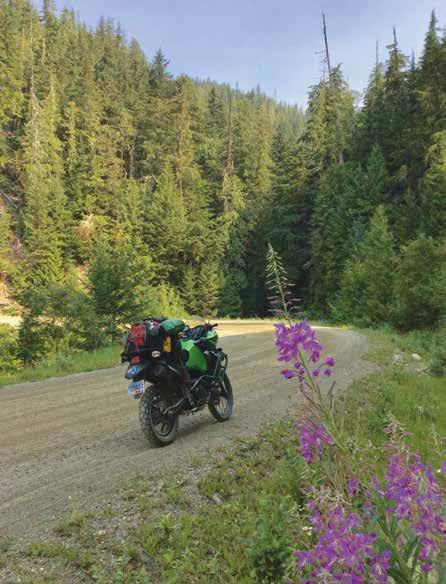
It doesn’t get much better than the
There are so many options a rider could spend months in Montana, Idaho, Washington State, British Columbia and Alberta and still not cover the area. If heading the long way back towards Vancouver appeals, I’d recommend catching the Galena Bay ferry for the short ride to Revelstoke. This is the gateway to the iconic Rockies run to Lake Louise and Banff. From there it’s the Icefields Parkway to Jasper and the run to Mount Robson, best viewed from the western approach. If you ever have the chance, drive this route in winter when the snow-covered peaks and frozen streams and waterfalls are beautiful beyond description. The skiing isn’t bad either if you can stand the frigid temperatures.
Riding the vast, BC Forest Service roads and the US National Forest roads networks gives the adventure rider access to areas rarely visited by most tourists and many locals alike. One 20km run along Bull River and Sand Creek forest service roads near Cranbrook turned into 50kms before I popped out onto a major road, so don’t necessarily believe the descriptions the locals may offer.
I used bestbikingroads.com to get a feel for this part of the trip. BC Backroads Mapbooks are highly recommended, as are Butlers US biking maps. There are numerous web-based downloadable guides readily available. Nationalforeststore.com has detailed maps for those hardcore rides deep off the grid.
The US surprised me with how cheaply I could travel. US$400 covered my week’s expenses travelling through Montana and into Idaho. Wild camping is allowed and is free in any US National Forest. Formal National Forest campsites similar to those provided by Parks BC are available at more popular areas and cost $10 per day on a first-in basis.
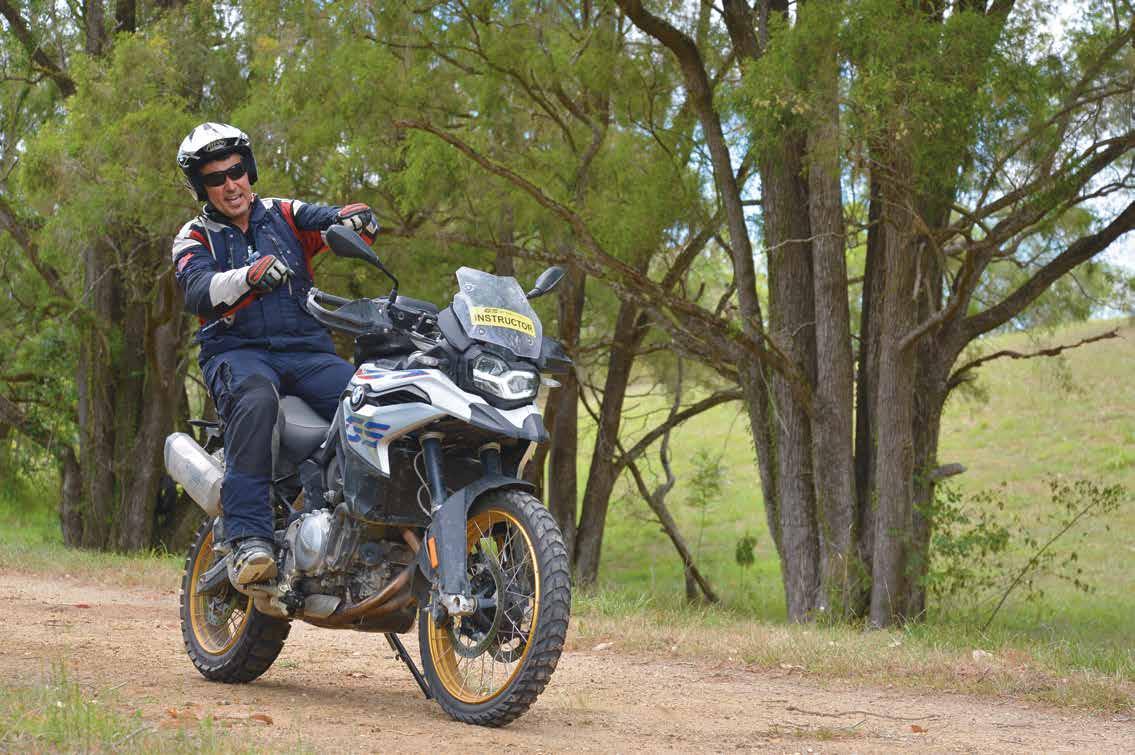
Idon’t spend much time on web forums. I don’t seem to have the time, and if I did, I don’t think I’d spend it reading the quantity and quality of what seems to be there. Call me old-fashioned, but I’d rather be doing something, like riding my bike or MTB instead.
After originally being self-taught at the age of 10, then spending a couple of
Miles highlights some very important and fundamental riding concepts.
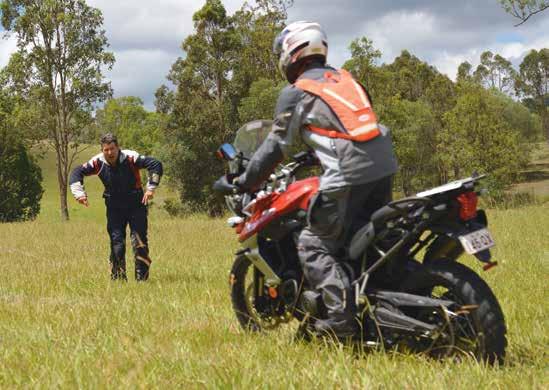
Left: Working on skills can give riders a big boost in control and pace.
Above: Try to stay balanced and physically efficient at all times.
Below right: Practicing front-wheel lock ups helps a rider learn good front brake control.
to take kids mountainbike riding in the morning before moto school, and to share information on what it takes to be a professional mountainbike rider…things like training, diet and so forth. After that I took part in the moto training as one of the regular punters.
It was the perfect foundation to becoming a proficient off-road rider.
A few years later I got my qualifications and became one of the coaches.
Technique
years at a mini bike club, I really learned to ride through Stephen Gall’s Academy Of Off Road Riding at the age of around 24. I was racing downhill mountainbikes professionally on the US and World Cup circuits and met Steve through our local road bicycle club racing Fridaynight criteriums (a great way to get fit and suffer like hell with heartrates over 205bpm).
After telling Gally I had a 250 motocross bike and was getting back into riding after 10 years off, he said I should come to his five-day camp at Dargle as a guest
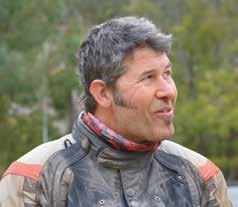
One thing that sticks in my mind from the training was the concept of ‘The Five Points Of Traction’. Here they are in my approximate order of importance:
1. Body position (30%)
2. Control use (25%)
3. Line selection (20%)
4. Suspension (12.5%)
5. Tyres and tyre pressure (12.5%)
I can almost hear shrieks of horror from people who spend many hours of their life commenting about what they think is the best tyre and how it transforms their riding.
I’ve covered most riding skills
(points one, two and three) in previous columns, and also talked about tyres and pressures. But here’s a quick summary of all five points together to get an overall perspective.
Body position: balance on the bike; standing up for rougher or more technical terrain; being light on the bike, staying agile and complementing the bike’s suspension; not being a dead weight and fighting the bike’s balance; anticipating acceleration, braking, cornering and obstacles to remain balanced and physically efficient at all times.
Control use: precise control of throttle, clutch, front and rear brake. Using throttle and clutch together to give optimum drive; find traction where it’s
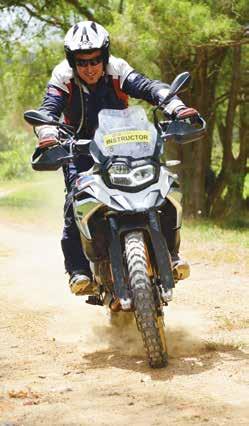
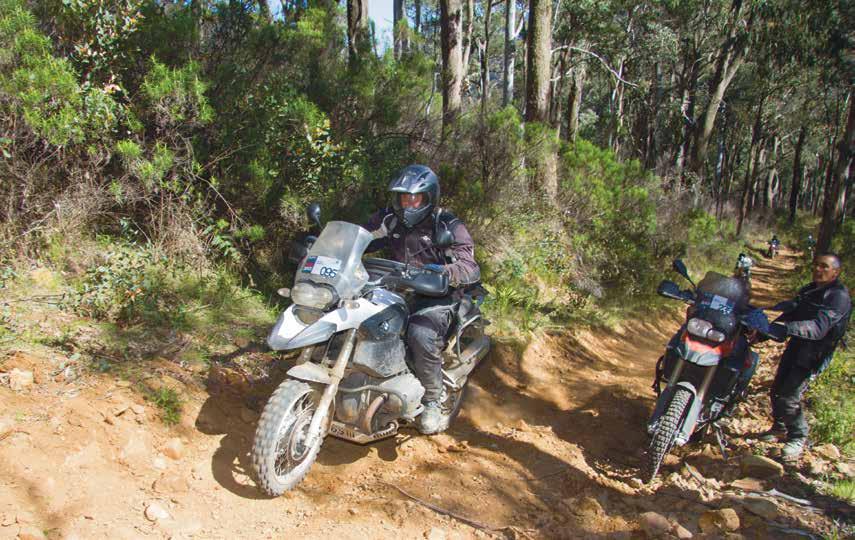
scarce; slide the rear wheel with control to aid steering (not just hold it pinned after a turn); avoid stalling; getting the best overall result for the power and torque character of the bike.
Using the brakes with precision to get the best result.
Good front-brake feel is a huge advantage as you can really wash off speed when required, maintaining
control. Rear-brake feel also helps when either trying to skid or not to skid, depending on the situation. Modern ABS is amazing, but it isn’t a substitute for skill.
Line selection: understanding grip levels by vision and bike feedback, searching out better grip levels for acceleration, cornering and braking; riding with flow and maintaining corner speed.
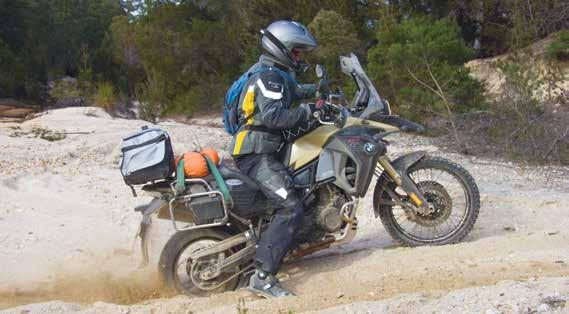
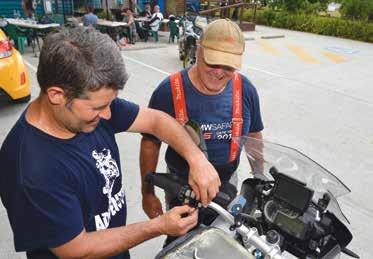
Left: Picking the right line is somewhat of an art. It isn’t always instinctive. Below left: A good understanding of throttle and clutch control will be a much greater advantage than low tyre pressures. Above: Setting up your bike is important, but riding skill is more important.
so you have to replace them every now and then. I like to have a common-sense approach to tyres. Depending on the type of riding you’re doing you might choose different tyres: more dual-purpose for more on- and off-road riding; more knobby for more off-road use.
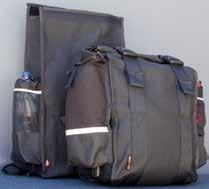
Picking the right line is somewhat of an art. It isn’t always instinctive, depending on your background and other sports you’ve done. Cornering line selection includes corner entry, midcorner and exit, and how to keep left during this process to avoid becoming a bullbar ornament.
The previous three points involve learning how to ride the bike, and in my mind they far outweigh the next two points, which are setting up your bike.
Suspension: the black art of suspension can be confusing, and I won’t go into detail now. The concept is having the right springs for your bike to have the right ride height. This varies depending on the bike, a rider’s weight and luggage. ‘Damping’ is how fast or slow the suspension compresses and rebounds. It’s true a well-set-up bike will handle better than one that isn’t, but if the rider doesn’t have the first three points covered, suspension isn’t a Band-Aid for lack of skill.
Tyres: now we’re talking…and talking. Tyres are black and round and wear out
On my motocross and enduro bikes I generally go for an intermediate knobby to suit a broader range from sand to hardpack with good grip and wear. Pressures are always 14psi-15psi front and back unless I’m riding lots of deep sand, then maybe I’d go down to 10psi. Or on my enduro bikes I sometimes use airless mousse tubes.
On adventure bikes I always prefer name-brand rubber due to the compound technology, profile, on-road performance and wet-weather performance. My first Simpson Desert crossing was on Metzeler Karoo 3s, as was my 11,000km in Mongolia last year. I’ve used Conti TKC80s for years on a range of bikes, and I raced Finke on a pair of Pirelli Scorpion Rallycrosses. I generally keep pressures quite high unless riding lots of deep, soft sand. I don’t believe a lower pressure instantly means more grip, and even if it does there are compromises like wheel damage and pinch flats. I try to optimise tyre life by using a taller gear with throttle control when using power to turn. I’ve seen people have trouble with some no-name or budget brands in terms of flats, tubeless slow leaks and on-road performance, especially in the wet.
For general riding I tend to go with dual-purpose tyres for the longevity and the mix of on- and off-road performance (Metzler Karoo 3/Karoo Street, Conti TKC70 and so forth).
In most conditions I find the less-aggressive pattern provides great traction, getting up hills where some smaller bikes with knobby tyres struggle.
Work on your skills as you can gain lots of control and pace. Set up your bike for the type of riding you do. Don’t expect a tyre to be a substitute for skill. If you’re not looking for on-road performance, wet or dr,y you can choose a harder cheaper tyre, but be careful on the road.
It’s common sense, really.
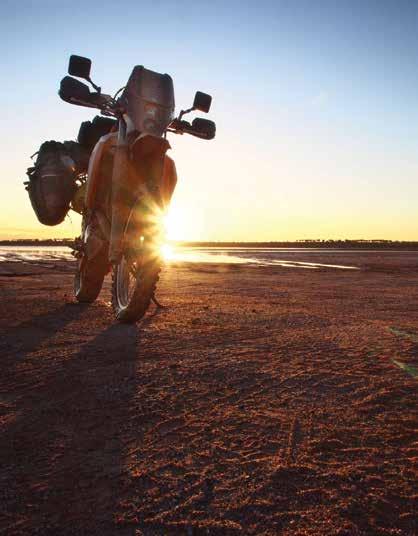
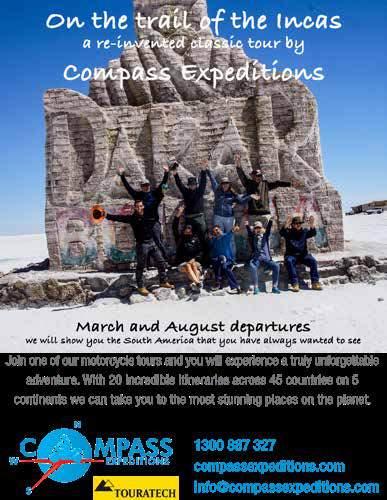
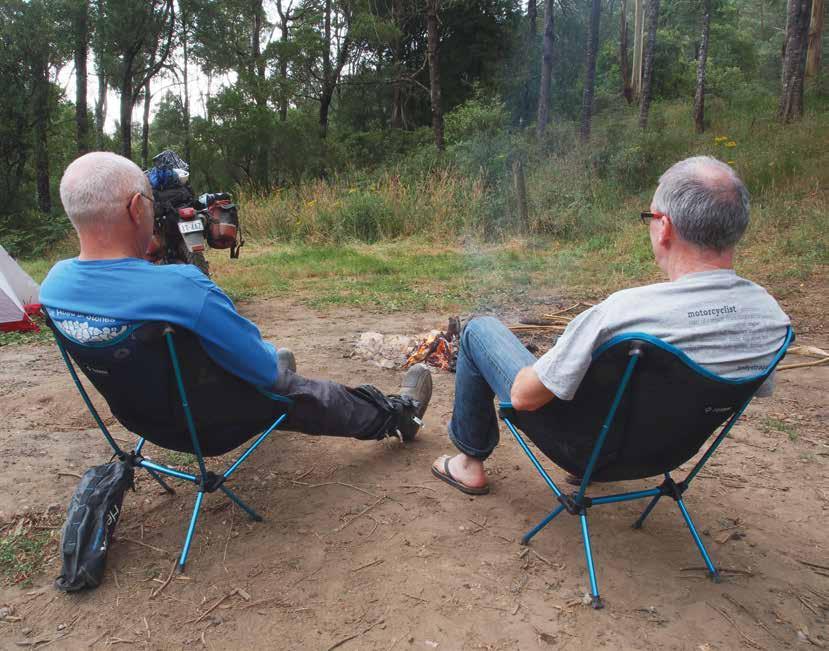
an you have a proper adventure ride without camping?
From a purist point of view, I reckon the clear answer is ‘no’. Motels and pubs are okay, but they all look, smell and feel the same. A pub room is a pub room. Sticky carpet is sticky carpet. You could be anywhere in Oz, if not the western world, once you’re in a musty motel cell. The number of times I’ve been dragged awake at dawn by Ol’ Mate upending the ‘dead-soldier’ bin just below my room…sheesh. Motels and truck noise go hand-in-air-brake.
Pub snub
Five stars might be enough for some, but bloody ’ell…there’s mega
millions more to enjoy. Getting as far away from all the pollution our world bathes us in from day to day, especially ubiquitous light pollution, makes for a feeling of freedom and, importantly for this mug punter, real relaxation. Gimme a babbling creek rather than a clattering ice-maker any day. Let me cook over an open flame instead of ordering a parmy with chips and salad, and I’d much rather enjoy a camp fire and take in the perfume of the bush rather than that wake up to the pong of stale beer and ashtrays. Yes, I’ve had timber-getting trucks stream past my tent by the dozen at 2.00am (recently), a motel wall blocks out snoring better than a tent fly, and packing up a tent and riding
off in the rain is about as miserable a pursuit as there is.
But pub rooms default as a plan B.
The luxury of a proper bed can be very welcome every few days. Yeah, the fart sack can get a bit dreary after a week without a shower or swim in a creek, and crawling into a coffin-sized tent and trying to wrestle off a pair of grubby riding pants is a recipe for shed words. And a good-quality camp mattress is a must. No sleep makes Strapz a very unhappy boy.
Tucker in the bush (I wouldn’t know ‘bush tucker’ from a tree trunk) is one of the joys of being away from civilisation. Some nights we drag
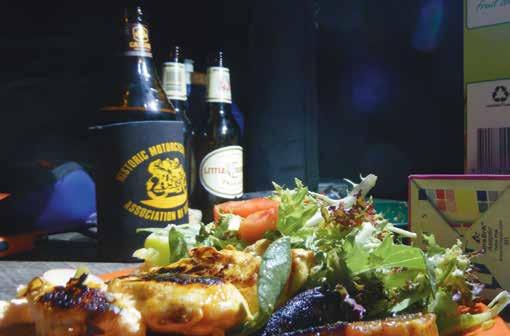
along the sort of grub that might make up a Mediterranean feast and match it to a couple of bottles of red. A good steak from a country butcher cooked on an incendiary-hot park barbie or hot rocks
(yes, never river rocks) is glorious. Beer isn’t hard to keep cold with a bag of ice divided between a couple of riders, and cans are a much lighter choice but rub together and turn into
Andy reads every e-mail you send. Here’s a response to his last couple of columns. If you have thoughts on something Andy’s written, or someone’s out of line in their response to Andy’s thoughts, let us know. Include a pic of yourself if you can.
Thinking big? Start small – issue #32
The bigger bikes can carry more and hold a higher speed, but really, how fast do you need to go? And not to mention the electronic ‘aids’. Hold this button while depressing this switch while modes click over in the display. Really? A mate of mine nearly had a big off as he forgot to turn off the ABS (again) after stopping the bike. A subsequent downhill with erosion channels had him petrified as he couldn’t lock up the back end to control his descent.
I’m actually swaying towards a pure and simple DR650. No electronic aids, relatively light compared to the current breed of ADV tourers, and a handful of mods have them humming along nicely. My Ténéré is nice, but I’ve ridden a DR650 (after getting the Ténéré), and it feels much better on the tighter trails. With me 175cm, the Ténéré is a tall beast and a good 40 kg heavier too. I should’ve listened to myself all those years ago when I took an old DR600 for a blast along the CREB track in FNQ and had a ball, something I just can’t recreate on the bigger ADV bikes.
So yes, I agree wholeheartedly with Andy. Regards, Paul Tailer.

mini geysers. Two or three bikers carefully packing their bikes out front of a stupidmarket is often an adventure in itself.
The great luxury of the camp is the fire. Many a rugged individual will pussy (from ‘pusillanimous’, not genitals, okay!) about with a few sticks and moan about the smoke. I aim for the 3.00am fire at 10.00pm. Load the bugger with good, solid wood once it’s well alight and sit back. Don’t fiddle with it too much either. Yes, you!
It’s another matter the other side of the Black Stump. Dehydrated food – a ‘dingo’s breakfast’ – scrupulous water control and ingenuity come into play. Five-star? Chuck-me-Farley, the star display in the deep outback is almost life-changing. There’s perfect silence as the Milky Way smears its way from one horizon to the next.
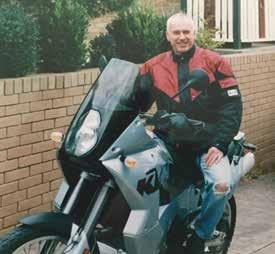
Maybe the silence, or more correctly, the absence of First-World noise, is what does it for me. It leaves space to take a few deep breaths. There’s something primal that draws the human animal to the peace of the natural world. After a day of shredding rubber and burning fossil fuels, hanging out with Mother Earth is good for the soul. Grab yer $1000 tent or five bucks worth of black plastic and go get some stars in ya!

Is it adventure if you don’t camp? Is Andy getting a bit carried away? Are country pubs part and parcel of outback travel? Let us know what you think. Email tom@maynemedia.com.au and we’ll make sure Andy knows what you think.
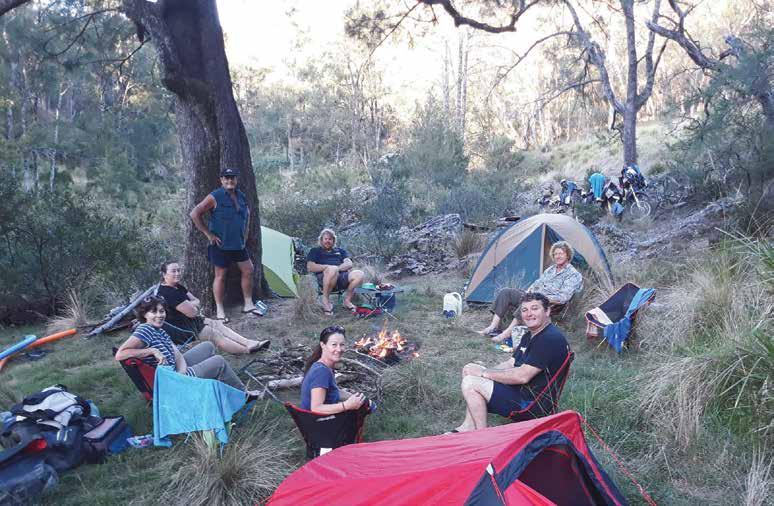
There aren’t too many things that scare Karen Ramsay – apart from steep downhills, sand, steep, loose, rocky uphills, phone calls at 2.00am and editor Tom’s deadlines. But she does have one phobia that outshines them all.
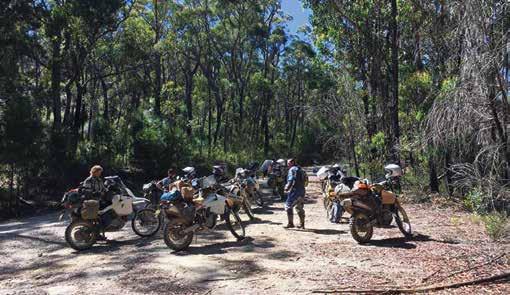
would maintain decorum.
We had a rough plan of what time we’d be at different places on the way to camp so we could meet each other en route after leaving work on Friday arvo. Fuelling up along the way, Kylie was commenting on how nice a particular area looked. She hadn’t been there before and had heard the place gets a bad rap. Next minute we saw some sort of tradie-looking bloke jogging down the road wearing a side arm. That was our cue to gear up and get out.
The particular National Park area we camped at that night was one of those that requires you to book in advance and they give you the code to get in the gate. Now, I’m more than happy to pay for camping if there’s no free camping. My issue is, if you’re travelling, it’s often hard to know where you’re going to stay from one night to the next. It can be hard enough to plan in a car, but it really seems to be exacerbated on bikes trying to cope with breakdowns and flat tyres or
tracks that aren’t passable for some riders. Yet there seems to be this trend towards online booking of campsites. So even if you work out where you plan to stay that night, no phone reception means no booking. Add to that no retrospective booking, National Park staff who aren’t allowed to collect money and no honesty box and you’re left with the options of not paying or finding somewhere else –usually when the sun is already close to the horizon.
The weekend in question was a rare one where booking ahead worked out fine and we had a lovely spot beside Chandlers Creek.
After a rather late evening around the fire, we made a leisurely start the next day from the unofficial camping ground to
Left: Hoping like mad there weren’t more spiders lurking at the Styx River campsite.
Below left: Other local couples who not only loved to camp and ride, but were really nice humans. Right: A very loud scream followed by very loud swearing.
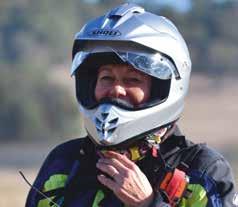
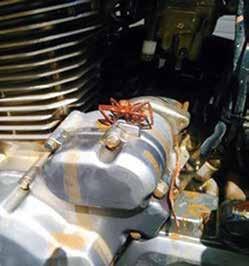
Husband Dave was keen to check out the route for an upcoming ride and I thought it might be nice to share the weekend. We’re pretty fortunate to know a number of other couples locally who not only love to camp and ride, but are also really nice humans who’re great to ride with. It was a spur-of-the-moment thing and, surprisingly, they all happened to be free on the same weekend. All Dave’s thoughts of a romantic weekend getaway were dashed (no, it wasn’t one of ‘those’ couples’ weekends). Our party consisted of Kylie and Greg, Macca and Ness, Nigel and Lianni, plus we were joined by Joc from Armidale, who was full of local knowledge and
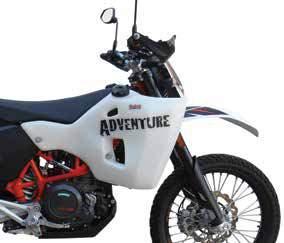
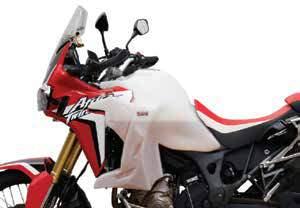

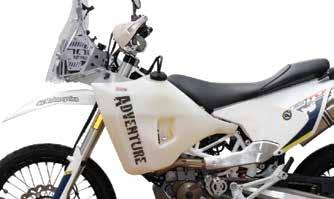
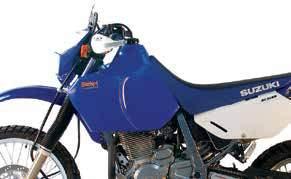
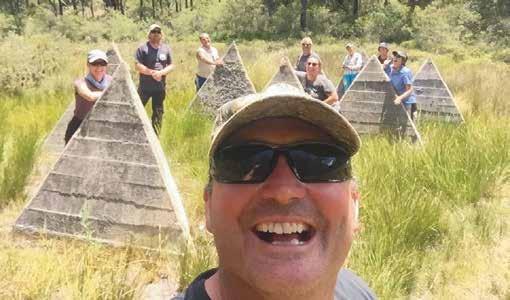
check out the official campground. We’d just pulled up, I’d taken off my helmet and was getting off the bike when I saw it. Right beside my tank bag. Right beside my leg. The mother of all spiders! There’s a special scream I reserve for spiders. And I used it. Along with a mouthful of obscenities. A very loud scream followed by very loud swearing. Then I was off that bike and away from it quicker than a woman my age has any right to move.
Instantly Greg, who was closest to me, was on high alert. He recognized it as Kylie’s snake scream. He was simultaneously checking on his wife’s safety while going into full crocodilehunter mode, scanning the surrounds for the slithering serpent. Dave sprinted up from the creek to let Greg know that the actual danger was far worse than some old snake.
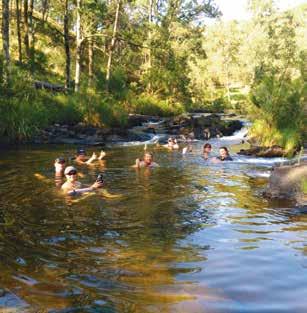
Left: There’s always one. Below: It was stinking hot the entire time.
previously private campground. However, no number of niceties were going to change the perception that I was a shrieking, foul-mouthed bikie who shouldn’t be allowed near children. Given that I work with children for a living, I really hoped they didn’t live in the same town where I teach.
Next he was wielding a stick in the general direction of the monster like a man who had no idea that this was a creature to be feared. I was hyperventilating a very safe distance from the bike, hoping like mad there weren’t more spiders lurking on the ground where I’d chucked my jacket in the panic. I still don’t understand why they weren’t whacking at the bike with sticks, but this allowed it to escape to safety somewhere in the engine. It was a bit like watching the villains in a Bond movie missing 007 when they shoot from almost point-blank range! At the point where the two potential heroes failed to annihilate the spider there was no question that I wouldn’t ride that bike again that weekend. Dave would be riding the spider Uber from then on and I’d be riding his vermin-free bike. If I’d been there on my own I would have probably torched the bike and walked out to safety.
I was going to say ‘worst of all’, but nothing’s worse than being on the same bike as a spider. But second to that, any hope the nice young family camped there would think adventure riders were civilized people was undone rather quickly. We could’ve been forgiven for arriving with a couple of ill-timed backfires from the DR (probably caused by the spider) disturbing the serenity of the family’s
I’ve wondered what I’d do if a spider turned up while I was riding. Would a phobia be stronger than selfpreservation? I only hope I never have to find out. Luckily the rest of the weekend was full of great riding and lots of laughs. I succeeded in not parking anywhere near Dave and his hitchhiker, it was stinking hot the entire time and we managed to camp beside a very welcome waterhole on the second night. The next incident, while completely unrelated, was scary in its own special way.
It all started with handgrips. For some reason Dave and I decided to do some handgrip swapping between bikes. The result was one bike with decent handgrips and one needing new grips. A new set from the local bike shop was too loose and they were having trouble finding some that would fit just like the old ones. Who would’ve thought there’d be so many options for a little piece of rubber or foam to fit on the end of your handlebars? Anyway, I thought I’d look online to see where I could get some. Well, all I have to say on the matter is DO NOT search for ‘pussy grips’ on your work computer.
So now I’m a foul-mouthed bikie with a questionable browser history and we’ve got used to the grips as they are.
A couple of happy footnotes: I still have my job and spiders and hot engines don’t mix.
R Weekends with good friends are priceless
R Spiders have no place on an adventure bike
R Spider repellent is a ‘must have’
R Adapting to handgrip size can be done
R Choose your internet search words carefully
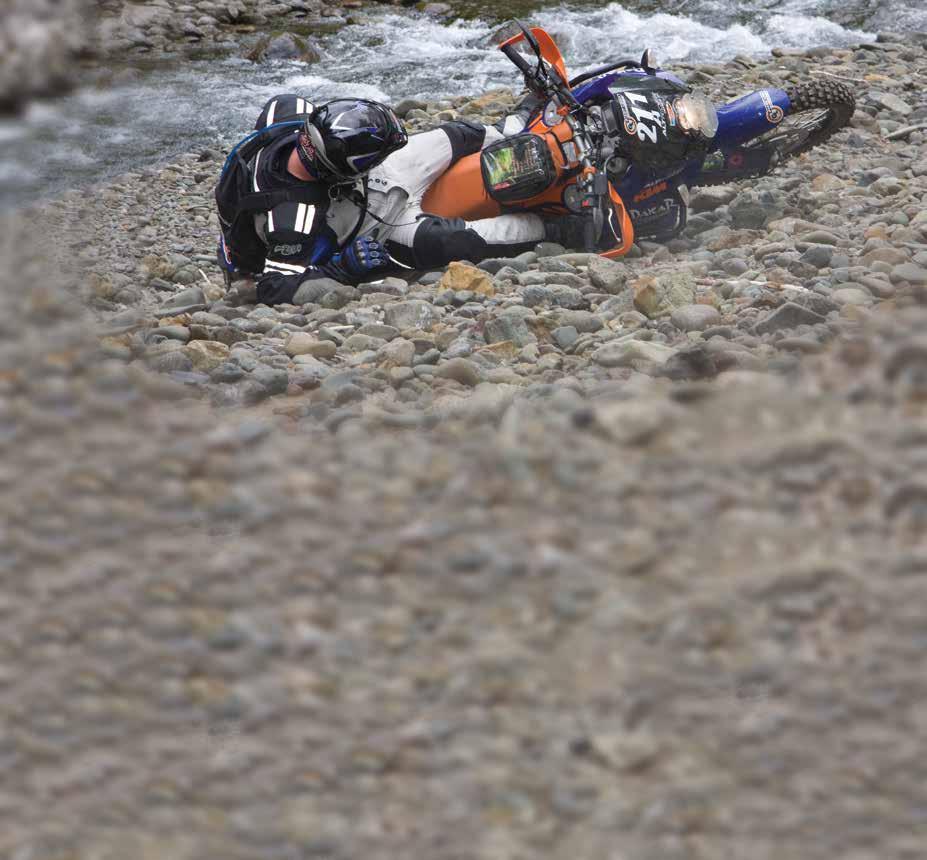
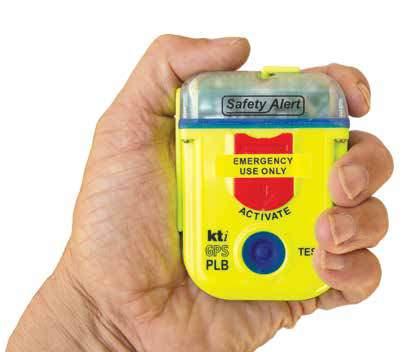

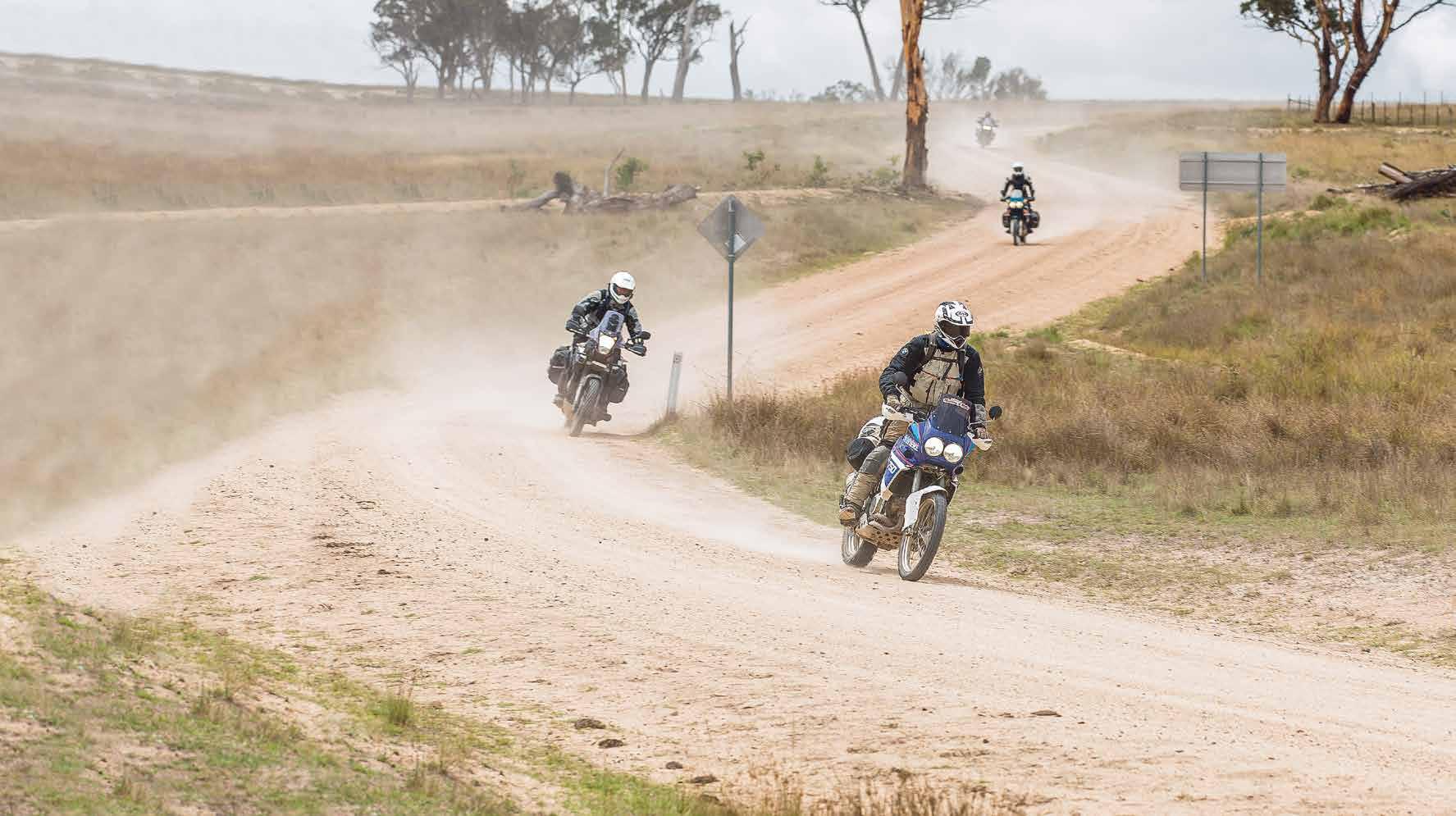
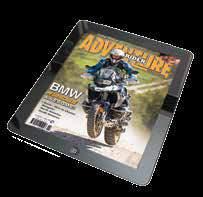

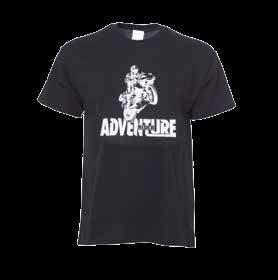


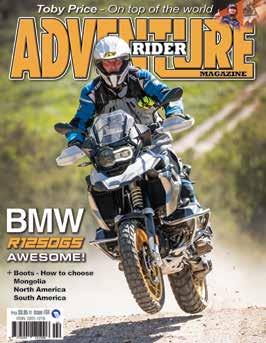



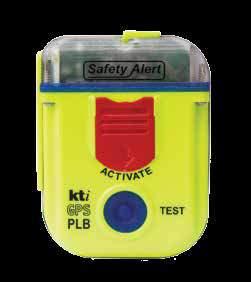
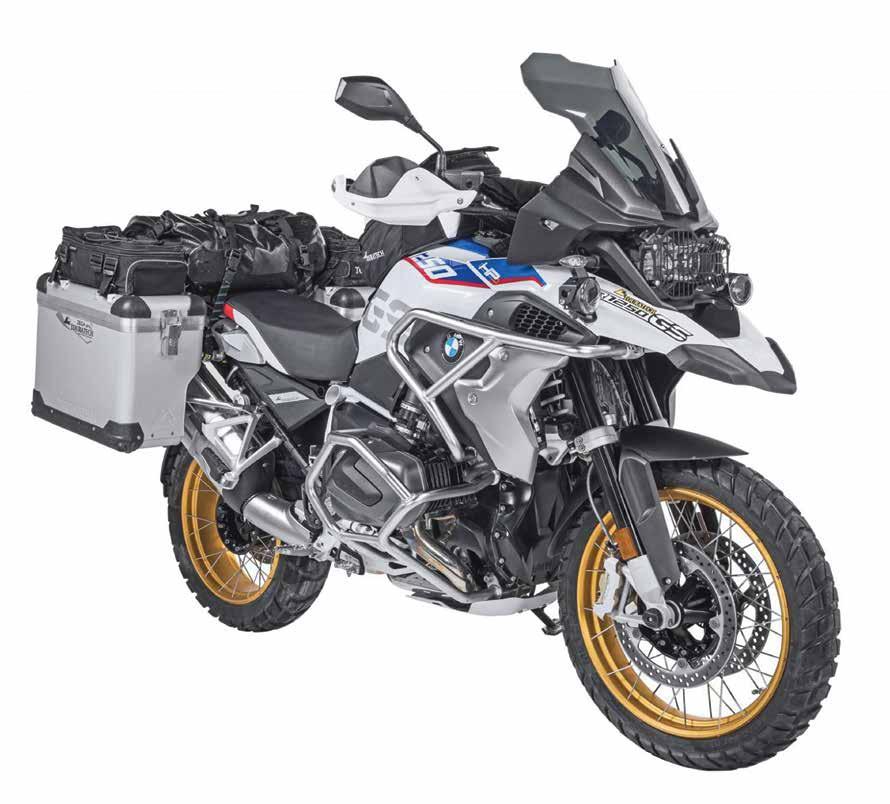
A
R
R
R
R
R
R Available in 1.60 front, 1.85 front, 2.15 rear and 2.50 rear
RRP: $29.95
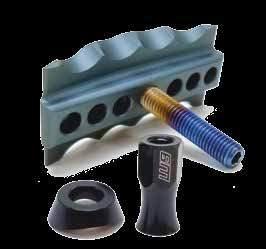
$99.95
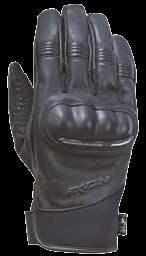
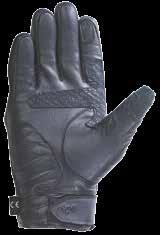
Visor comes standard with Pinlock posts fitted.
Gpr stabiLiser
Control the tankslapper!
R Neatly tucks under handlebars without sacrificing ’bar height
R Broad range of settings
R Strong, machined-steel frame mounts
R Aluminium ’bar mounts
R Kit is supplied ready to bolt on, including mounting brackets
R Pro kits include a billet top clamp
RRP: Starting from $699
Available from: Bike shops and GPR Web: gpraustralia.com.au
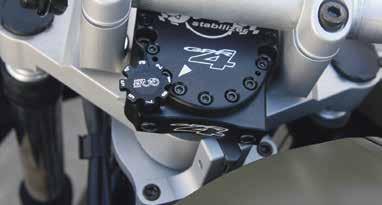
R New exhaust ports added to the top diffuser vents
R New shell shape for better aerodynamic stability
R New chin vent with more intake ports
R Larger, sculpted side cowl vents
R Fully removable/replaceable/washable interior
R New FCS (Facial Contour Support) cheek-pad design R Five-millimetre peel-away temple pads
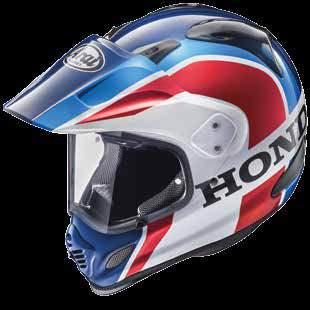
rukka exeGaL
aDventure suit
Premium adventure clobber.
R 100-per-cent breathable, windproof and waterproof Goretex Pro three-layer laminated to abrasionand tear-resistant cordura shell fabric
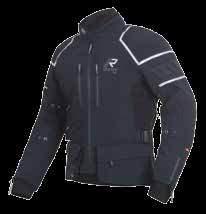
R Armacor reinforcement on elbows and shoulders
R Ventilation openings with zipper and mesh inserts
R Rukka D3O Air protectors
R Zipper for connecting jacket to pants
R Heat- and abrasion-resistant leather panels in inner of knees and seat
RRP: Jacket $1765. Pants $1250
Available from: Innotesco Web: innotesco.com.au

motoz uber uLtra-heavyoffset-vaLve tubes
New offset valve tubes to suit KTM.
R Four-millimetre natural rubber
R Extreme wall thickness designed specifically for adventure bikes
R Outstanding protection against punctures and pinch flats
R Front tubes weigh in at 1.8kg and rear tubes over 2.4kg
R Sizes: 21” 80-90; 17” 130-150;
18” 150-170 straight-valve;
18” 150-170 offset-valve
RRP: TBA
Available from: Your local dealer Web: jtr.com.au

Goretex GLove
Optimum insulation and protection on long or short-haul winter outings.
R Dual cuff closure and strategically reinforced areas
R Goretex waterproof and breathable membrane
R Stretch polyamide upper construction with goatskinleather palm
R 100gm/sqm thinsulate thermal insulation on the backhand
R Thumb and palm reinforcement
R Available in Men’s sizes S - 3XL
RRP: $199.95
Available from: All motorcycle stores Web: monzaimports.com.au
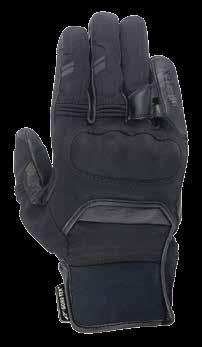
An essential aftermarket part.
R Easy to fit
R Allows adequate airflow in the radiator’s core so cooling temperature is not compromised
R Available in black or polished alloy
R Three-year worldwide warranty
R Australian-made
R Video fitting instructions available
RRP: $195. On special for $159
Available from: Rad Guard
Phone: (02) 6658 0060 Web: radguard.com.au
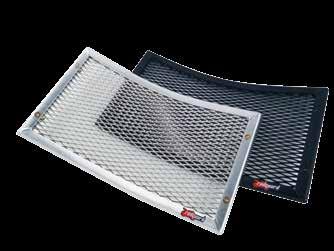
neLson-riGG rG-020 saDDLebaGs
Made from top-quality, UV-treated, Tri-Max ballistic nylon.
R Fit with self-locking harness and, in most cases, can be used without racks
R Includes double Velcro tyre-lever pocket on the bottom of each bag
R Reverse coil zippers help keep out dust and dirt
R Fully expandable for added storage and with organiser under lid
R Lifetime warranty
R Hold 12 litres per side @ 37cmL X 23cmW X 15cmH
R Expanded holds 15 litres @ 37cmL X 23cmW X 20cmH
RRP: $199.95
Available from: All leading motorcycle dealerships Web: nelsonrigg.com.au
Givi smart cases anD mounts
Ideal for GPS or phone.
R Sun visor
R Water-resistant zip but waterproof cover in heavy rain (still with access to charging)
R All mounting is included
R Touch-screen friendly
R Extra strap for added security
R Fits a variety of phones and GPS
R Ball-mounted so it can move to the desired position
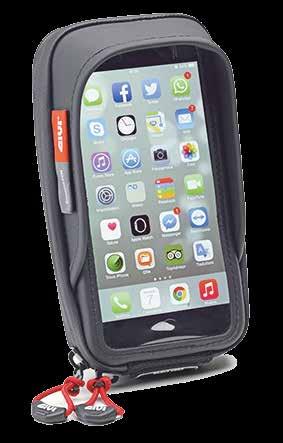
RRP: Cases $74.95. Mounts $119.95
Available from: Adventure Motorcycle Equipment
Phone: 1300 883 908
Web: www.adventuremotorcycle.com.au
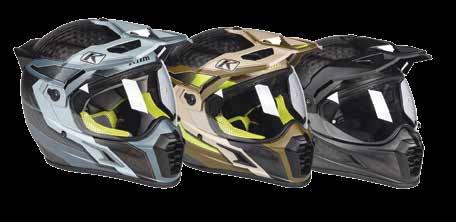
kLim krios pro heLmet
A modular helmet built using Koroyd technology and a quick-release shield and visor system.
R Optically correct face-shield technology coupled with an industry-leading field of vision
R Meets or exceeds the most demanding ECE and DOT standards
R Klimatek fabric liner system
R Adequate airflow through the chin bar vent and a closable top vent
R Transitions to any of four riding modes quickly and without tools
R Premium polycarbonate, anti-scratch, Pinlock-ready shield in clear or smoke
R Available in sizes S to XXXL
RRP: $660 Available from: Made in Germany Pty Ltd Phone: (02) 8004 6083 Web: daytona.de raD Guar f750G cooLer
exoteGG infLatabLe boDy Warmer
Simple and effective.
R An inflatable thermal layer
R Packs down to fit into the smallest gap
R 10-per-cent better insulation than feather down
R Rider inflates vest by blowing into the marine-grade valve. No battery power used
R Puncture-resistant
R Antibacterial and antimicrobial
RRP: $TBA
Available from: AdventureMoto Web: adventuremoto.com.au
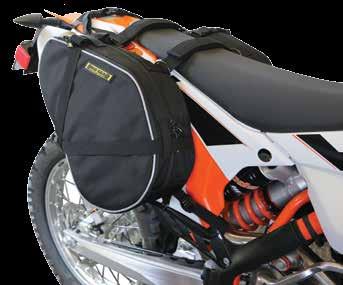
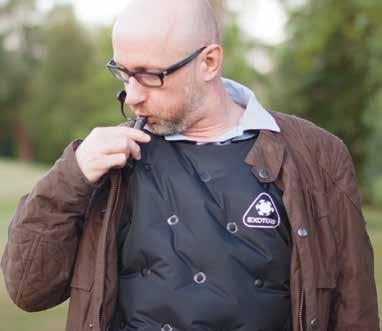
RRP: $995
Available from: AdventureMoto Web: adventuremoto.com.au
Daytona roaDstar Gtx boot
Comes with a two-year Goretex waterproofing warranty and one-year manufacturer warranty.
R Perfect fit, available for narrow and wide feet
R Watertight and breathable with Goretex climatic membrane
R Velcro fastener for different calf sizes
R Two zip fasteners to get in quick and easily
R Reinforced gear change cushion from abrasion-resistant PU foam
R PU foam sole
R Anatomically formed
climatic insole
R Sizes 36 – 51
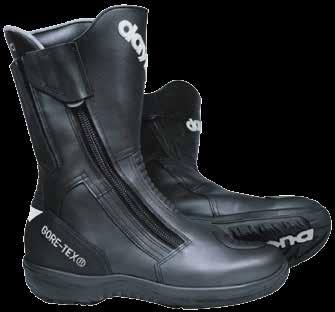
sm pro cush-Drive WheeLs for Drz400e anD Dr650
To suit 2000-2019 DRZ400E.
R SM Pro billet hubs made from 6061-T6 aliminium
R SM Pro Platinum rims made from high-quality 7050 series aluminium
R Heavy-duty zinc-plated carbon steel spokes
R One-year warranty on hubs
R Hand-built in Australia
RRP: Adventure wheels
$1345 per pair.
Motard wheels
$1545 per pair
Available from:
Your local dealer Web: jtr.com.au
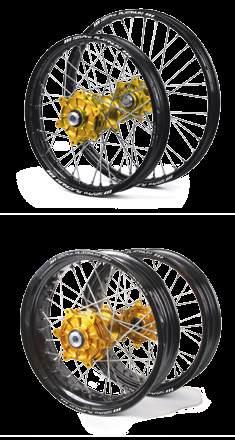
forma preDator 2 GoLD
To celebrate Steve Holcombe winning the 2018 World EnduroGP championship.
R CE-certified protection and quality
five hG-1 pro heate
Winter is coming. It’s a Stark reality.
R More elaborate, more comfortable, more elegant than the previous model
R Heating system is more efficient and reliable
R Easy-reach control knob
R Three levels of heat
R Topside combines fullgrain goatskin with stretch cordura
R Optimum weather resistance
R Metacarpal protective PU shell under the leather
R Reflective elements
RRP: $349.95
Available from:
Moto National Accessories Web: motonational.com.au
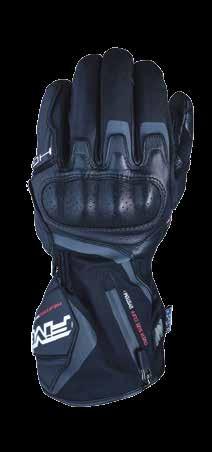
b&b ktm 1050, 1090, anD 1290 bashpLate
Designed with Australian conditions in mind.
R Available in polished or black
R Made from five-millimetre, 5083 structural plate
R Coated steel mounting brackets and stainless bolts supplied for fitting
anDy strapz nekz
A high-tech neck warmer that quickly converts to a beanie.
R Polar fleece on the outside and superfine Merino on the inside.
R Shock-cord drawstring and spring-button toggle for a snug fit
R Easy adjustment and freedom of movement
R Especially useful when performing ‘head checks’
R Designed to be comfy and functional
R Helps reduce helmet noise
R Made in Australia
RRP: $32
Available from: Andy Strapz Phone: (03) 9786 3445 Web: andystrapz.com
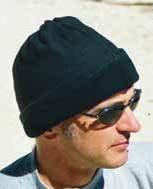
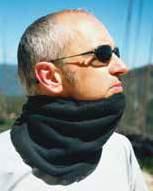
QuaD Lock one-inch baLL aDaptor mount
Integrate Quad Lock with an existing motorcycle RAM mount.
R Super-strong mounting
R Quick to attach and detach
R Minimalistic design
rev’it! sanD
As versatile as a Swiss army knife.
R Seeflex level 2 CE protection
R Prepared for Seesoft CE level 2 back protector insert – type RV
R Detachable Hydratex 3L, breathable, 100-per-cent waterproof liner
R Long and double short connection zipper
R VCS zips in strategic positions
R Zipped venting offers excellent air flow
RRP: $739
Available from: REV’IT! Australia Web: revitaustralia.com.au
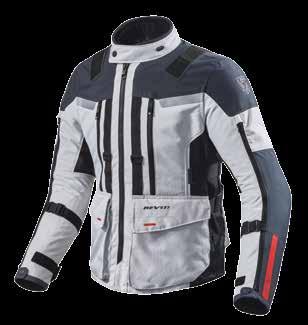
aGv a9x heLmet
Lightness, comfort and adaptability.
R Four different configurations
R Lightweight carbon+Aramid+glass-fibre shell
R Premium interiors are water resistant
R Adjustable chin-guard port
R Three shell sizes
R Removable nose guard
R FCS Dual Pivot Ankle brace system Web: formaboots.com.au
R Can be installed with or without crash bars
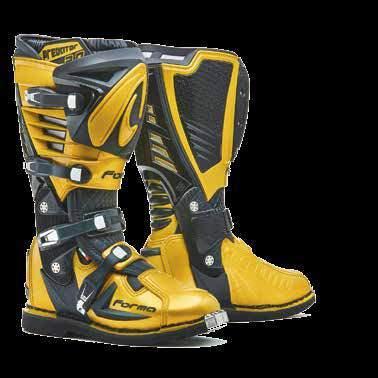
R Offroad protective welt-type midsole
R Dakar-proven comfort and durability
R Four pro folding buckles with adjustable straps
R Rear heel counter for extra protection
R High-quality European production
RRP: $363 – $383
Available from: B&B Off Road Web: bboffroad.com.au
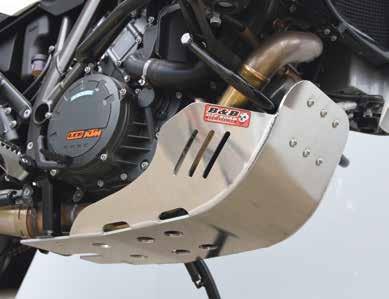
RRP: $34.95
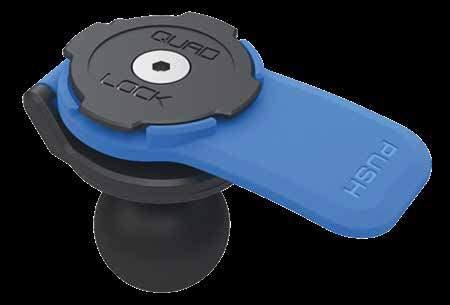
Available from: Your local motorcycle dealer
Dealer enquiries phone: McLeod Accessories 1300 300 191
Givi outback, DoLomiti, anD trekker aDventure cases
Choose your adventure with Givi.
R Ranging from 30-litre to 58-litre
R Specific mounting kits for almost every motorcycle
R Large range of additional accessories like soft internal bags, backrests, and luggage options
R Available in high-quality alloy, or in black finish
RRP: $499 – $829. Pannier pairs from $999 – $1349
Available from: Your local motorcycle dealer Web: ronangel.com.au
$649 – $849 Available from: All leading motorcycle dealerships Web: agvhelmets.com.au
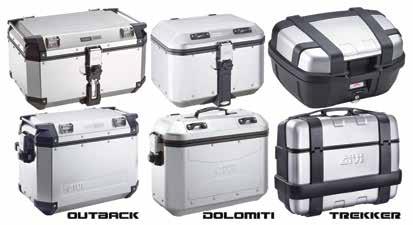
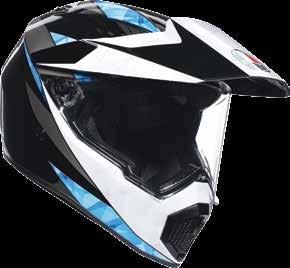
Ls2 ff399
vaLiant
heLmet
Certified as a full-face and an open-face.
R Kinetic Polymer Alloy (KPA) shell weighing in at 1675gm (±75gm)
R 3D optically correct ‘A class’ polycarbonate twin-visor system

R 180-degree, swing-around chin bar
R Removable and washable hypoallergenic liner
R Ready for Linkin Ride Pal 3 Bluetooth communication by Sena
R Fully adjustable intake ports and channelled EPS
RRP: From $499
Available from: LS2 stockists Web: LS2Helmets.com.au
boLt husky pro packs
Not a re-badged KTM kit.
R Researched to service the special features of Husqvarnas –like composite sub-frames and unique bodywork
R Designed for off-road Husqvarna model years 2014-current
R Suitable for all displacements, two-stroke and four-stroke
R Part Number: BMHUSKPP
RRP: $83.95
Available from:
Pro Accessories Web: proaccessories.com.au
Green chiLe aDventure Web
Dominator four pack
Secure your load!
R Can be attached to 25mm webbing
R Eliminates excess webbing hazards, such as tangles
R Secures webbing, cords, wires, excess materials
R Elastic shock cord
R Easy adjustment
RRP: $10.95 with free delivery in Australia
Available from: Smart Motorcycle Accessories Web: smartmotorcycleaccessories.com.au
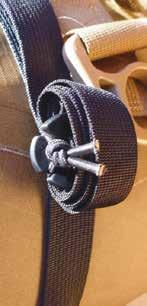
After three years of development, the Motopressor puncture-repair tool is finally here.
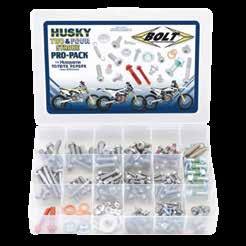
z-Lok security tie
A reusable cable tie with key or number lock.
R Award-winning design
R Toughened nylon on the outside and stainless-steel band on the inside
R Flexible and adjustable protection
R Perfect for short-term security
R Suitable for locking a helmet to a bike, a pushbike to a carrier and many other uses
R Available as a 40cm key lock, single and twin pack, or a 50cm number combination lock which can be re-set
RRP: $14.95
Available from: motoradgarage.com.au
Email: info@motorradgarage.com.au
R A four-in-one multitool that uses prevulcanized repair strings Stores in a sheath small enough to fit in a pocket
Contains a pair of pliers, a rasp, an insertion tool and a knife
Repair strings are prevulcanized, so no more tubes of glue
Repair string plugs the hole and leaves a patch-style repair on the inside of the tyre
RRP: $59.95 plus postage and handling
Available from: Rocky Creek Designs and all good motorcycle stores through Pro Accessories Web: rockycreekdesigns.com.au
